How to Grow and Care for a Wandering Dude Plant
Here’s how to care for this pretty trailing plant.
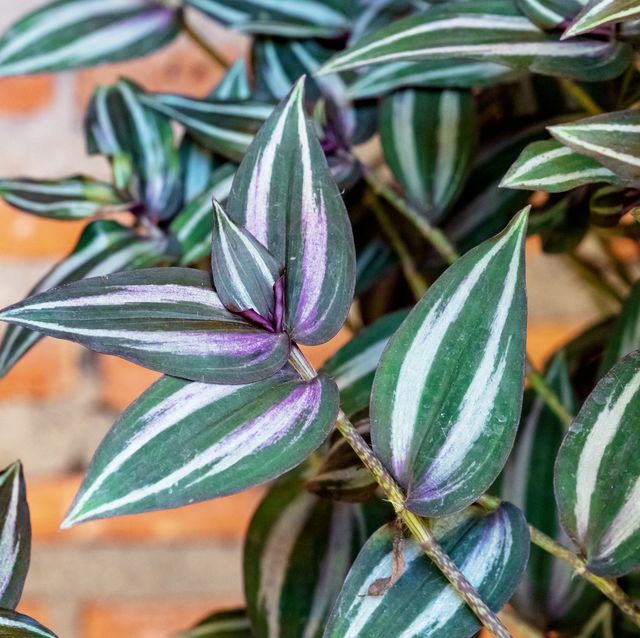
Country Living editors select each product featured. If you buy from a link, we may earn a commission. Why Trust Us?
With its long dangling stems, this plant tends to “wander” all over the place. Today, the plant often is called by its botanical name, Tradescantia, with “zebrina” referring to its silver striping.
It’s sometimes also called silver inch plant, but it can be confused with another plant, commonly called inch plant, Tradescantia fluminensis , which has solid green foliage.
Other varieties of wandering dude have become widely available in recent years, including the very popular nanouk type, which has foliage with pretty pinkish stripes and magenta undersides.
Native to Mexico, Belize, Guatemala and Honduras, the wandering dude usually is grown as a houseplant, but in USDA Hardiness zones 9 to 11 , it can be grown as a low-growing ground cover, too. ( Find your zone here .)
Read more: 15 Common Houseplants to Grow and Brighten Up Your Home
Ahead, learn everything you need to know about how to care for a wandering dude plant:
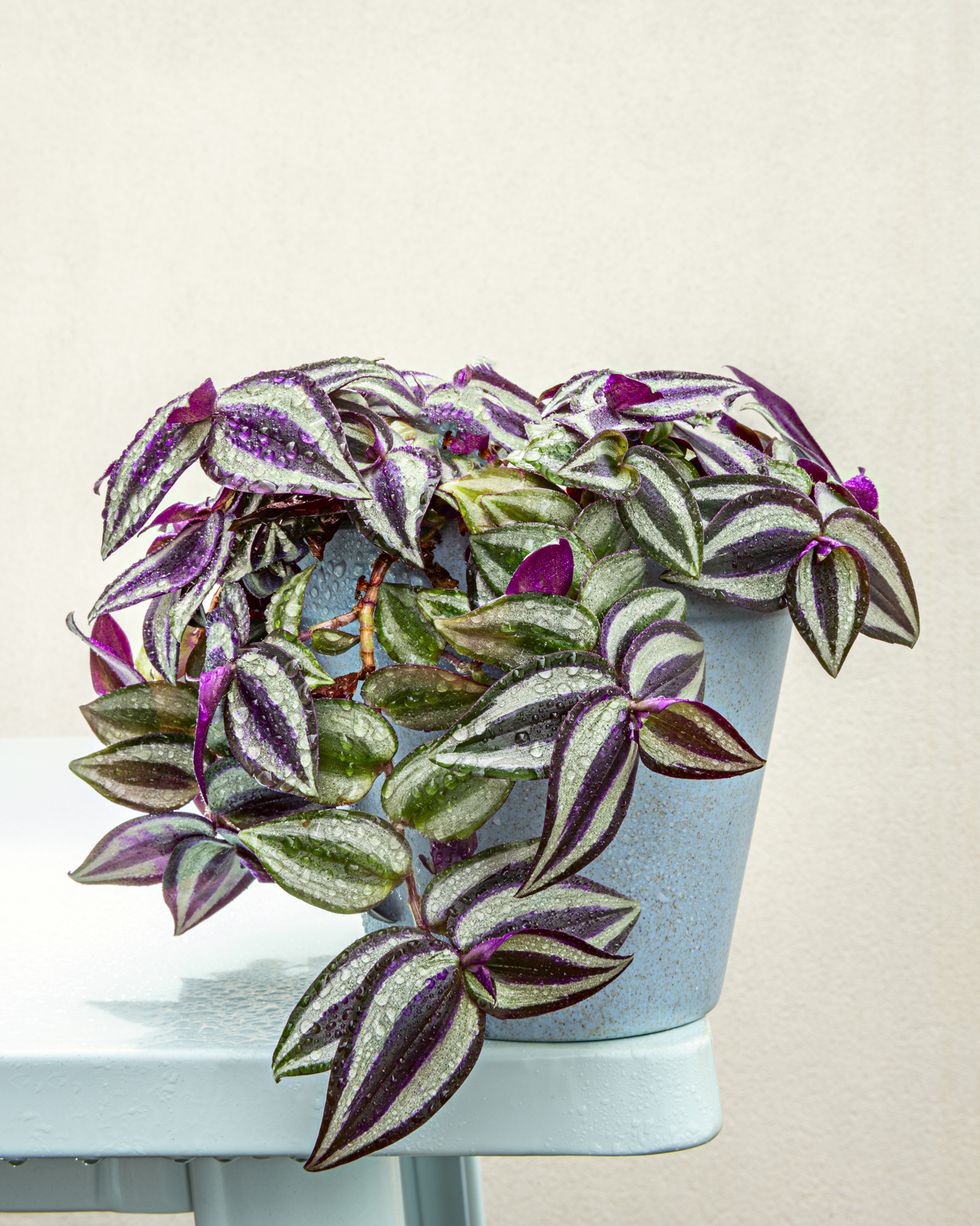

Wandering Dude Basic Info:
- Common Name: Wandering dude
- Botanical Name: Tradescantia zebrina
- Plant Family: Commelinaceae
- Type of Plant: Perennial, grown as houseplant
- Native Origin: Mexico, Belize, Guatemala, Honduras
- Sun Exposure: Full sun to part shade
- Mature Size: 6 inches tall by 1 foot wide
- Toxic to pets: Yes
Why Trust Us
I'm a garden writer with more than 15 years of experience growing houseplants, edibles, and landscape plantings. I also regularly trial new plant cultivars for performance and reliability, and test garden products to evaluate practicality and durability.
How Do You Care For a Wandering Dude Plant?
Give wandering dude bright, indirect light. If it doesn’t get sufficient light, this plant tends to get gangly and unattractive. Its purple coloring also may fade in low light, which means you should move it to a more brightly-lit room or use a grow light.
If your wandering dude is starting to get scraggly, simply snip off a few inches from the end of each stem to help stimulate the plant to push new, bushy growth. You can use plant snips or your fingers. You may need to pinch back frequently because wandering dude is a fast grower.
How Do You Water a Wandering Dude Plant?
You should water only when the plant feels mostly dry. Poke your finger in the soil before watering; if soil clings to your finger, wait a few more days and recheck.
If you let it get too soggy, that’s a sure way for it to get mushy and die. Like most houseplants, it’s better to err on the side of too dry, rather than too wet.
If you like, you can feed this plant with any general-purpose houseplant fertilizer, but it’s not entirely necessary.
Miracle-Gro Miracle-Gro Water Soluble All Purpose Plant Food, 3 lb
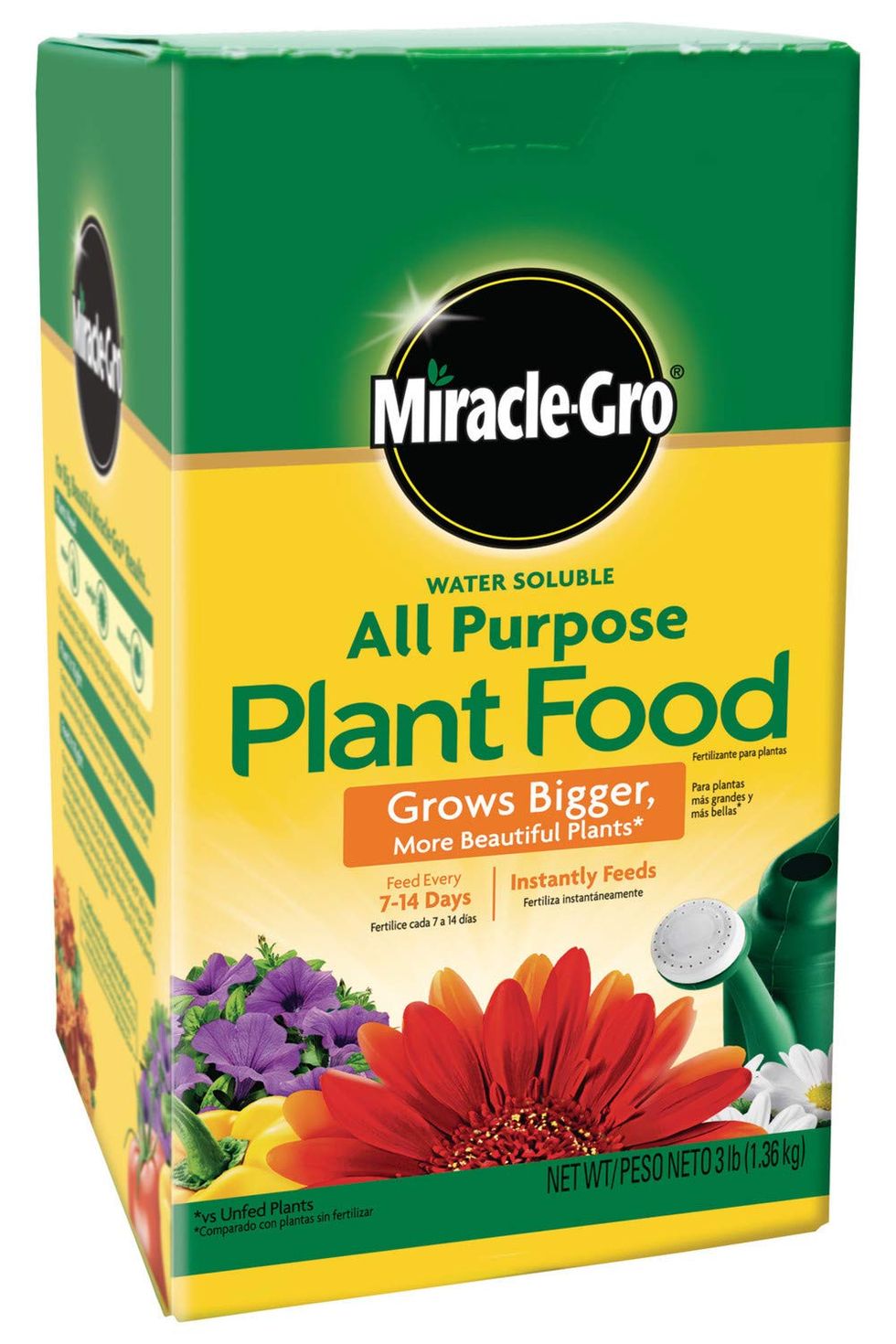
Can You Grow Wandering Dude Plant Outdoors?
Yes, it makes a great trailing plant spilling out of containers! Pair it with tall plants such as hibiscus, canna, elephant ears, or other tall, upright tropicals. If it starts to get leggy, just trim it back. Outdoors, it does best in full sun (northern climates) to part shade (southern climates). It may develop tiny pinkish flowers outdoors, though it rarely flowers indoors.
How Do You Propagate a Wandering Dude Plant?
Like pothos , this is a great plant to propagate to share with friends or to make new plants for yourself. Simply take a cutting, say, if it’s getting too long, then place it in a glass of water to root. Keep it in a bright spot in your home (not direct sunlight), and watch for roots to develop within about two weeks. Then plant in regular potting soil, and keep the soil lightly moist while it settles in.
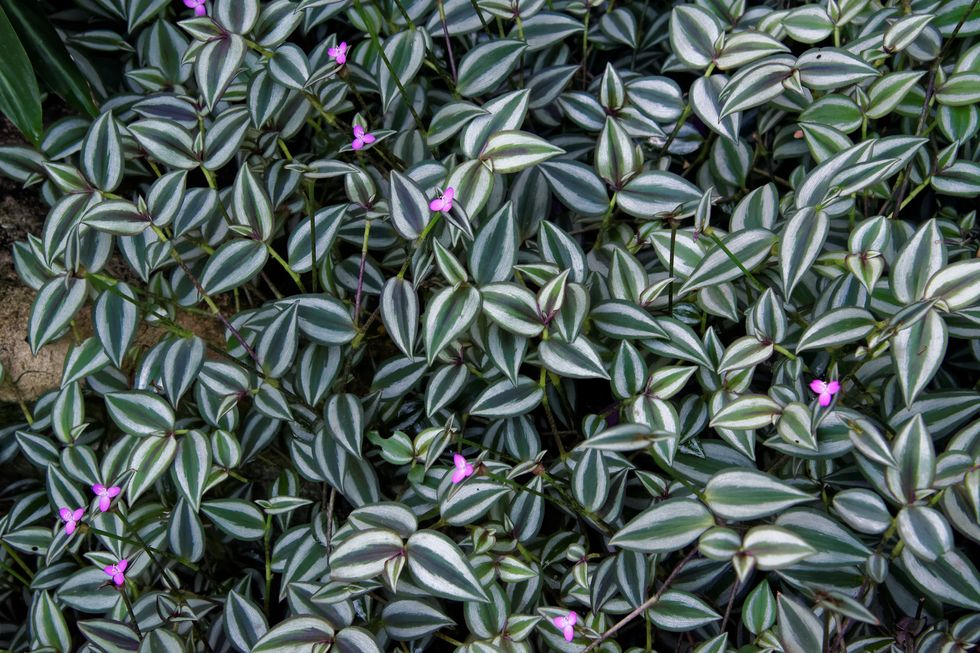
Is Wandering Dude Toxic to Pets?
According to the ASPCA , this plant is toxic to pets and may cause dermatitis, or irritation of the lips and mouth. But remember that any plant may cause vomiting or GI distress if eaten in large enough quantities, so keep this away from pets who are nibblers. Finally, call your vet ASAP if you suspect your pet has ingested it, even if you’re not sure. It’s always better to be safe than sorry!
In addition, the plant sap also may cause skin irritation in some people. Wear gloves when handling cuttings if you tend to have sensitive skin.
Read more: 28 Pet- Friendly Houseplants You Can Grow Without Worry
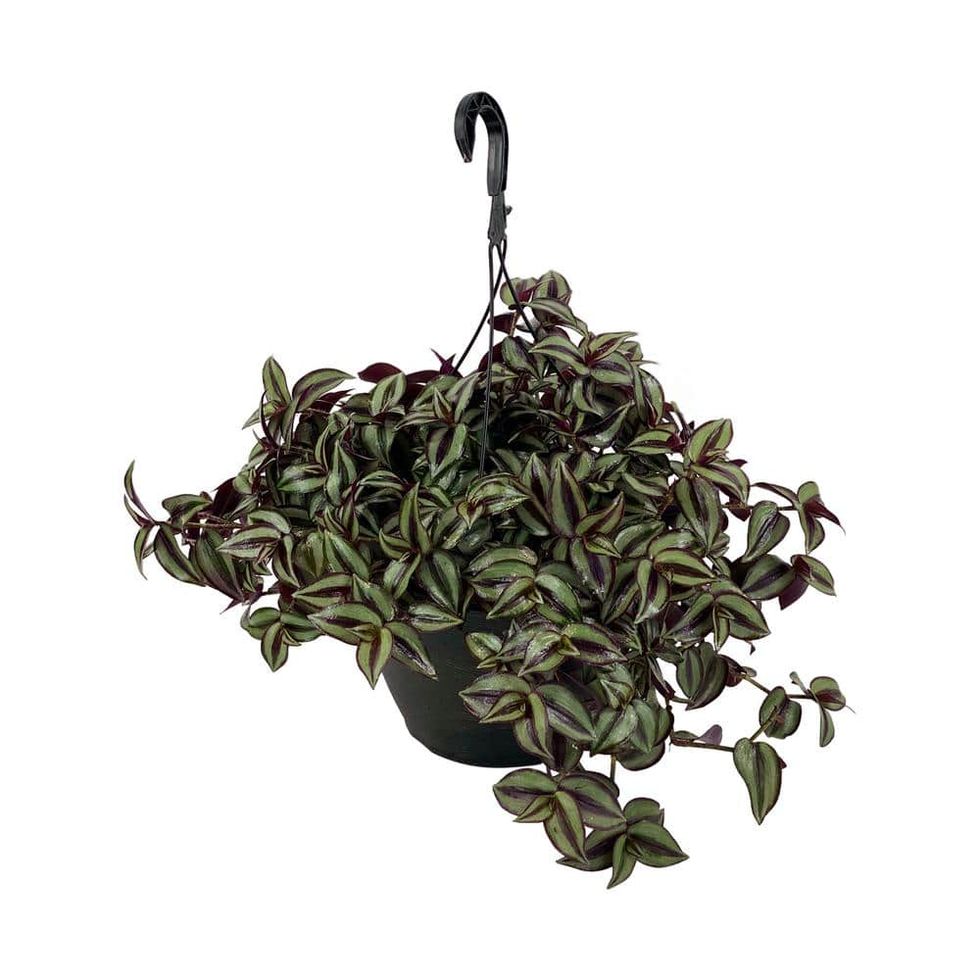
Vigoro Tradescantia in 11-inch Hanging Basket
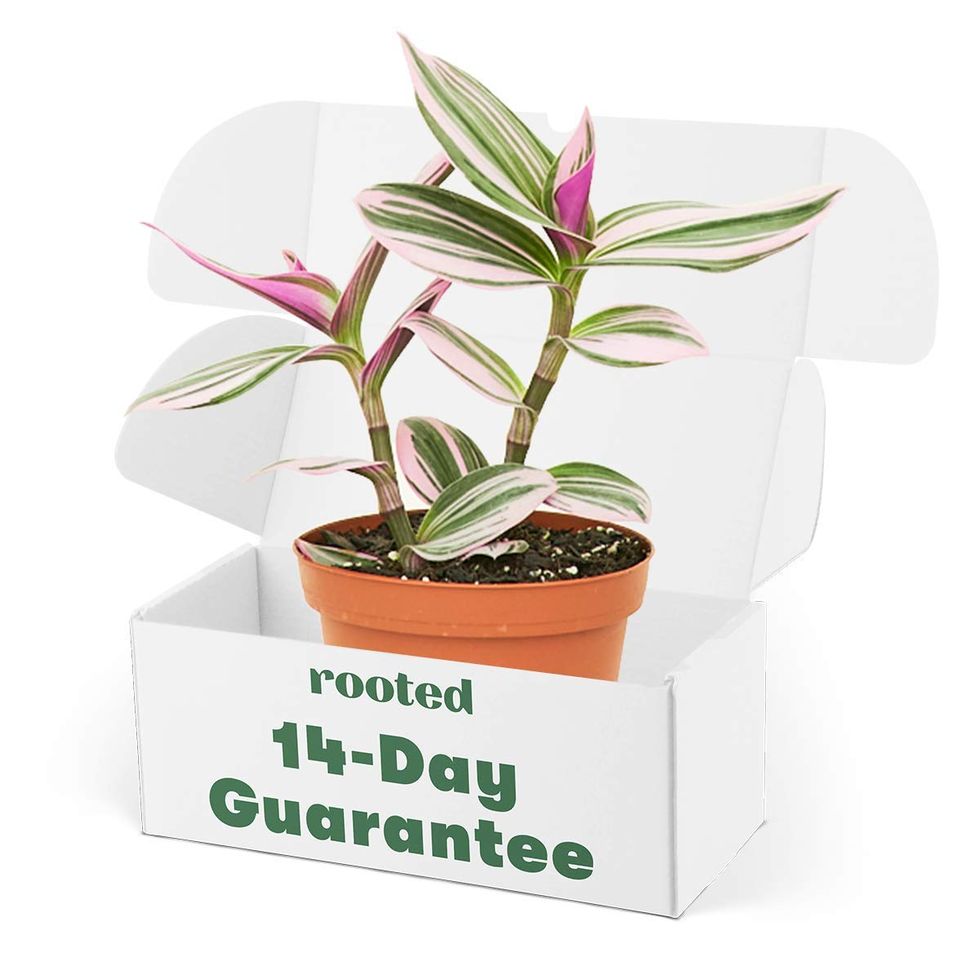
Rooted Tradescantia Nanouk, 4-inch pot
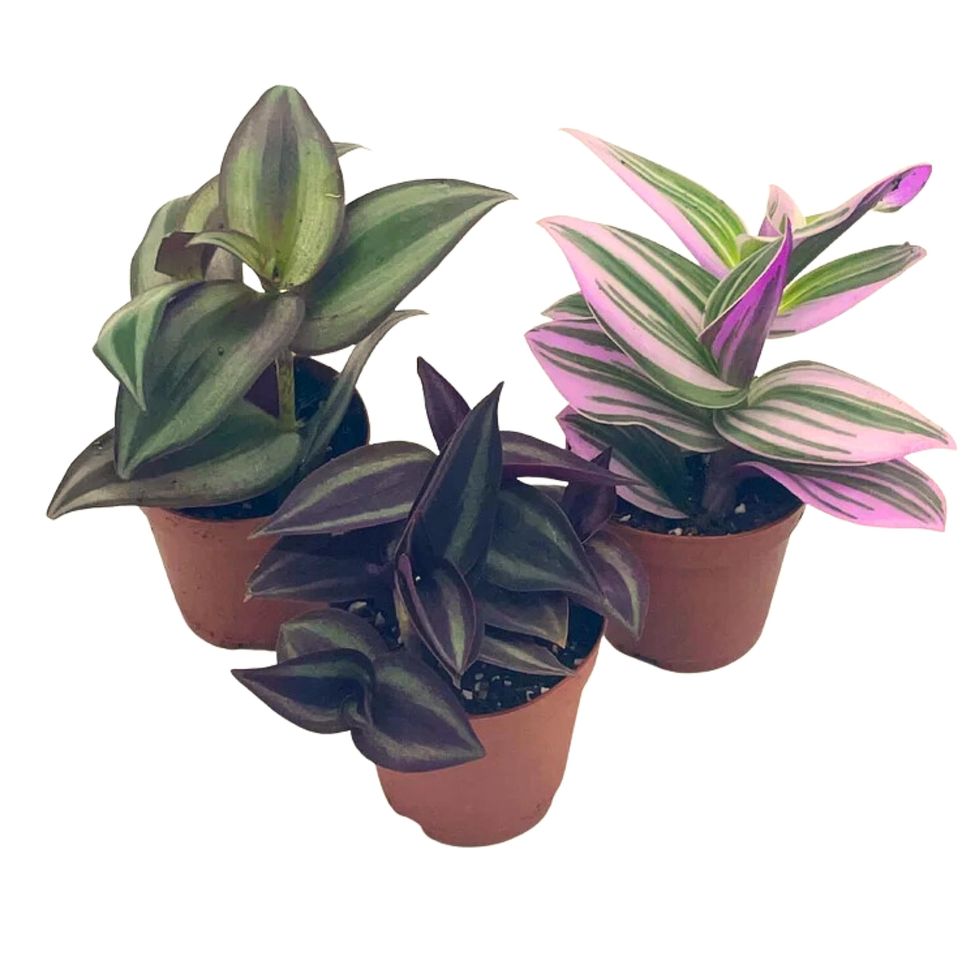
BubbleBlooms Wandering Dude Assortment
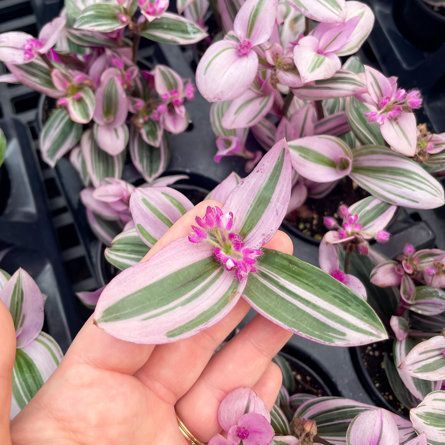
Wayfair Tradescantia Nanouk, 4-inch pot
Arricca Elin SanSone has written about health and lifestyle topics for Prevention, Country Living, Woman's Day, and more. She’s passionate about gardening, baking, reading, and spending time with the people and dogs she loves.

.css-1shyvki:before{background-repeat:no-repeat;-webkit-background-size:contain;background-size:contain;content:'';height:0.819rem;margin-bottom:0;margin-right:-0.9375rem;width:3.125rem;}.loaded .css-1shyvki:before{background-image:url('/_assets/design-tokens/countryliving/static/images/arrow.svg');}@media(max-width: 48rem){.css-1shyvki:before{display:none;}}@media(min-width: 40.625rem){.css-1shyvki:before{display:inline-block;}} Gardening Encyclopedia .css-unxkmx:before{background-repeat:no-repeat;-webkit-background-size:contain;background-size:contain;content:'';height:0.819rem;margin:0.7rem auto 0.9375rem;width:3.125rem;}.loaded .css-unxkmx:before{background-image:url('/_assets/design-tokens/countryliving/static/images/arrow.svg');}@media(max-width: 48rem){.css-unxkmx:before{display:block;}}@media(min-width: 40.625rem){.css-unxkmx:before{display:none;}}

17 Best Cottage Garden Ideas We Love

7 Tomato Plant Pests and How to Get Rid of Them

22 Best Hanging Plants for Every Space
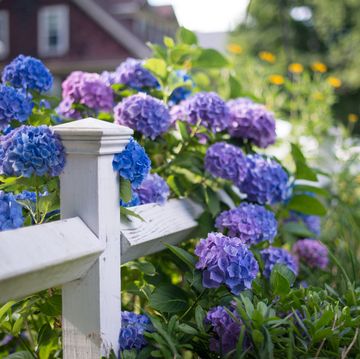
Grow Hydrangeas Like a Master Gardener!

21 Indoor Plants That Are Easy to Grow
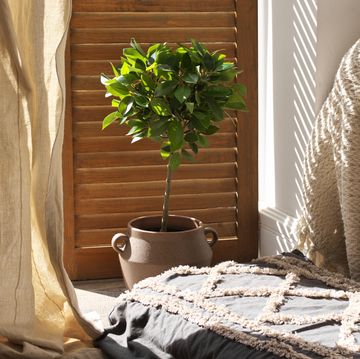
Buying a Ficus Tree? Here's What to Know
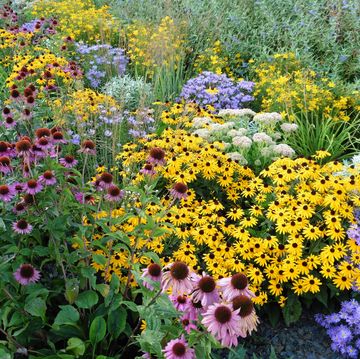
26 Full-Sun Perennials for Your Garden

Got Spider Mites? Here's How to Get Rid of Them
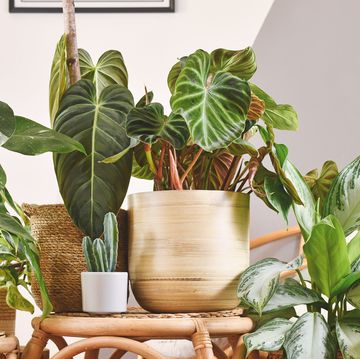
12 Big Leaf Houseplants You Need ASAP
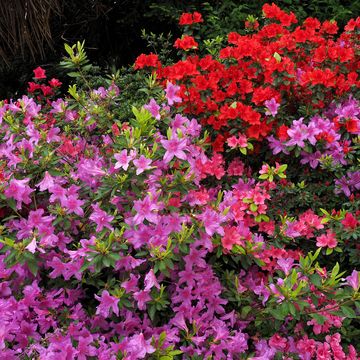
How to Grow Beautiful Azaleas

18 Spring Vegetables That Are Best Right Now
Wandering Dude Plant Care: Growing a Gorgeous Tradescantia Houseplant
Introduction to the Wandering Dude Plant
With its stunning multicolored leaves and cascading habit, it’s easy to see why the Wandering Dude plant has become so popular. This carefree beauty brightens any space with its vibrant foliage and vining growth. Let’s look at how to keep your Wandering Jew or Wandering Dude thriving with excellent care!
Overview of the Wandering Dude Plant
The Wandering Dude goes by many names – its botanical name is Tradescantia zebrina, but you may also hear it called the Inch Plant, Spiderwort, Striped Wandering Jew, or just Wandering Jew. Whatever you call it, this eye-catching houseplant is sure to add a bold pop of color wherever it grows!
Belonging to a large genus of over 75 species, the Wandering Dude hails from Central and South America’s tropical regions. It’s an evergreen perennial prized for its striking leaves that emerge chartreuse and mature to a deep eggplant or violet hue with mesmerizing silver stripes.
Given proper care, this trailing plant can easily reach 3-4 feet long , making it perfect for shelves, hanging pots, or as an attractive ground cover. Read on to learn how to keep your Wandering Dude houseplant growing strong!
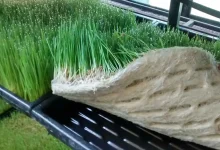
Natural Origins and Habitat
Native to Mexico, Bolivia and Brazil, the Wandering Dude naturally grows along forest floors, near streams and woodlands. It thrives in shaded understories and moist soils. As a houseplant, replicating some of these preferences for partial shade, high humidity, and frequent watering will satisfy your Wandering Dude Plant.
Growing Conditions
While quite adaptable as a houseplant, the Wandering Dude performs best when given conditions mimicking its tropical habitat:
Light Requirements
The Wandering Dude Plant prefers medium to bright indirect light . An east or west facing window provides ideal light levels. Some direct morning or evening sun is ok, but avoid intense midday sun which can scorch the leaves. Insufficient light causes weaker growth.
Temperature and Humidity
Daytime temperatures between 65-80°F suit the Wandering Dude well. At night, temperatures around 55-65°F are fine. Average humidity around 40-50% is preferred, with higher humidity promoting the lushest growth. Avoid drafty locations.
Use a rich, well-draining potting mix with added organic material like compost or peat moss. Soil should retain some moisture but drain well to prevent soggy roots. Adding perlite, bark or coco coir improves drainage.
Watering Best Practices
Water whenever the top 1-2 inches of soil become dry. Thoroughly drench the soil until water drains from the pot’s bottom, then wait for the top to dry out again before repeating. Take care not to overwater, as standing moisture causes root rot.
Caring for Your Wandering Dude
Once you’ve set up the optimal growing conditions, your Wandering dude plant requires minimal ongoing care. Follow these tips:
Fertilization
Use a balanced liquid fertilizer at half strength every 2-4 weeks during spring and summer to fuel growth. Reduce to monthly feedings in fall and winter. Avoid over-fertilizing which can burn the leaf tips.
Repot in a slightly larger container every spring using fresh houseplant soil. Trim any overgrown roots and gently loosen the root ball before repotting. Support vines during repotting to avoid damage.
Pruning and Training
Pinch back leggy stems to encourage full, bushy growth. Remove any dead or damaged foliage and stems. Train vines on trellises or allow them to trail from hanging baskets or shelves.
Propagating New Plants
Take 3-4 inch stem tip cuttings in spring or summer. Remove lower leaves and place the cut end in water or potting mix to root. Once rooted, pot up babies for easy Tradescantia propagation!
Achieving Full, Healthy Growth
With proper basic care, your Wandering Dude will grow vigorously. But you can maximize its full potential with these added tips:
Providing the Right Support
Add a trellis or coir pole to allow vertical climbing, or let the stems trail freely. Use soft plant ties as needed to gently support and train the flexible vines. Keep upright supports sturdy but not too intrusive.
Managing Leggy Growth
Insufficient light causes weak, leggy growth with bare lower stems. Provide ample brighter light to encourage bushiness. Prune back overgrown vines to redirect energy into new leaves.
Encouraging Fuller Foliage
Apply a balanced fertilizer monthly and ensure adequate light to promote full, robust foliage growth. Water well and increase local humidity. Rotate pots periodically for even leaf growth all around.
Maximizing Color Vibrancy
Bright, indirect light intensifies the Wandering Dude’s fabulous coloration. Cooler night temperatures around 60°F also boost rich purple tones. Let soil dry slightly between waterings for boldest color.
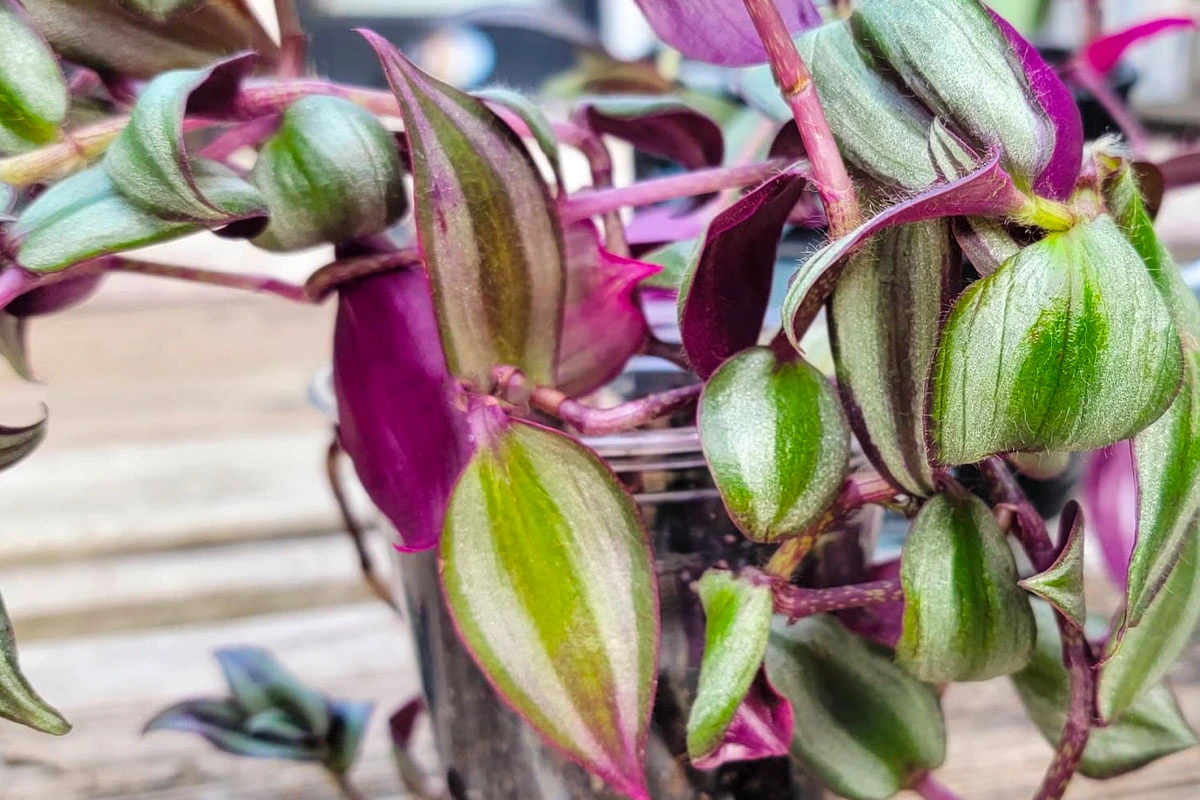
Troubleshooting Common Problems
Watch for these potential issues and take corrective action as needed:
Leaf Spot Diseases
Bacterial or fungal leaf spots cause unsightly marks. Improve air flow, prune affected leaves, avoid overhead watering and space plants out more.
Drooping or Wilting
This signals under-watering. Check soil moisture and water the plant thoroughly until it drains from the pot’s bottom. Resume watering when the top 1-2 inches become dry.
Intense direct sunlight, dry air, or over-fertilizing can cause brown crispy leaf margins. Adjust for more moderate light conditions, increase humidity and reduce fertilizer concentration or frequency.
Lower Leaves Turning Yellow
Natural aging causes lower leaves to yellow and drop over time. But overwatering issues can also cause yellowing leaves and leaf drop. Allow soil to dry more before waterings.
With its trailing vines and sensational rainbow leaf coloring, the Wandering Dude certainly earns its popularity as a houseplant! Give your Tradescantia zebrina plenty of bright indirect sunlight, average room temperatures and humidity, well-draining soil, and consistent moisture. Train it to climb or trail, fertilize monthly, and pinch back wayward vines for fabulous full growth. This colorful charmer thrives with a little attentive care!
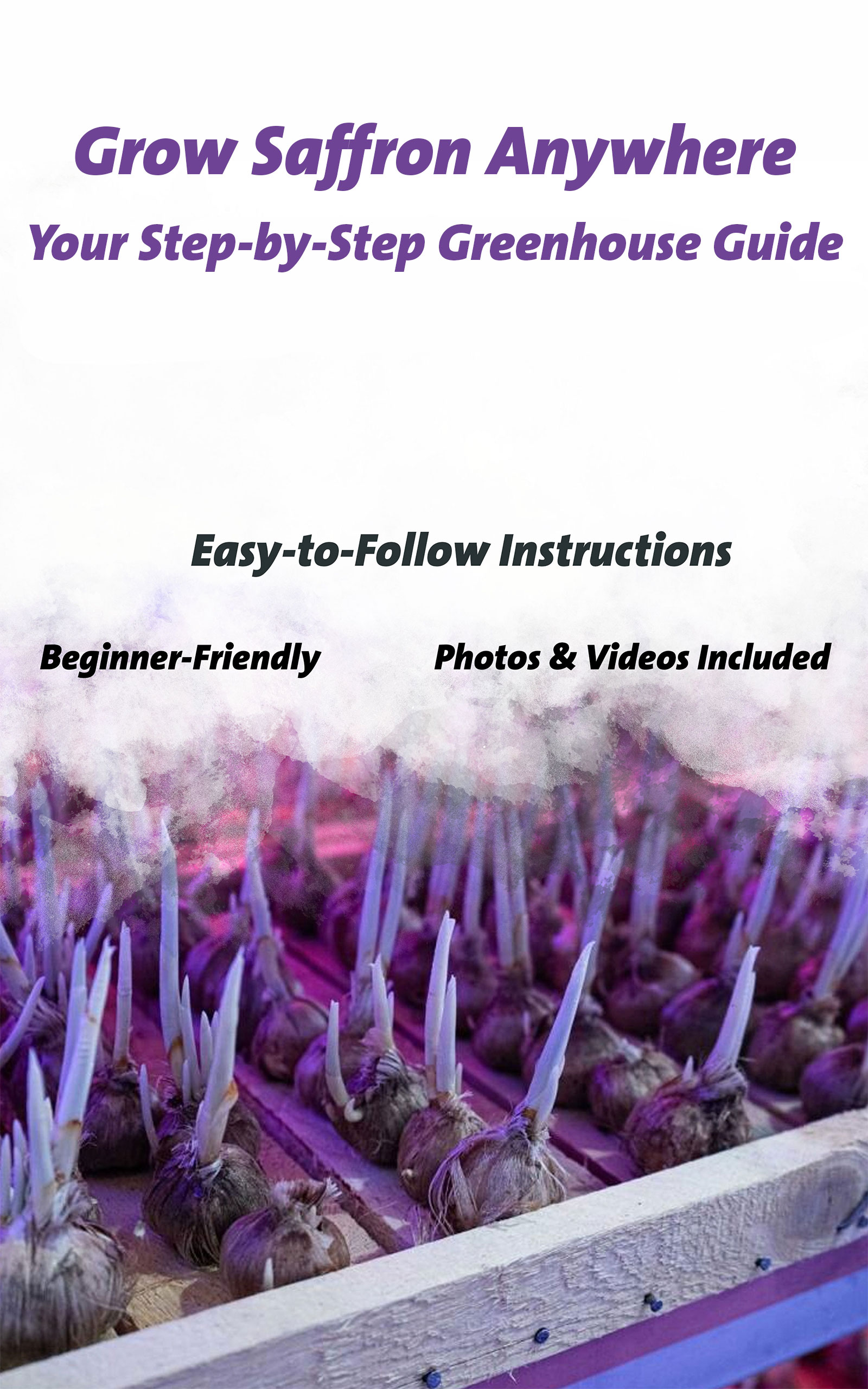
Ebook Training Saffron Planting In Greenhouse
Additional wandering dude plant care tips.
Here are some extra tips to ensure your Wandering dude houseplant reaches its full potential with vibrant trailing vines:
- Turn or rotate plants frequently for evenlydistributed growth on all sides rather than just growing towards the light source.
- Mist leaves occasionally with water to replicate the humidity of its native tropical habitat. Just don’t leave moisture sitting on leaves overnight.
- Remove dried out flower spikes promptly to encourage more energy redirected into leaf and vine growth.
- Wipe dust off plant leaves periodically with a damp cloth to keep their colors looking bold. Dust dulls the vibrant tones.
- Propagate new Tradescantia cuttings frequently. Younger smaller plants tend to show bolder color variegation on leaves.
- Don’t rush to repot into much larger containers. These plants like their roots somewhat confined. Upsize gradually in stages.
- Mix controlled release fertilizer beads into the potting soil to provide a steady low dose of nutrients over many months.
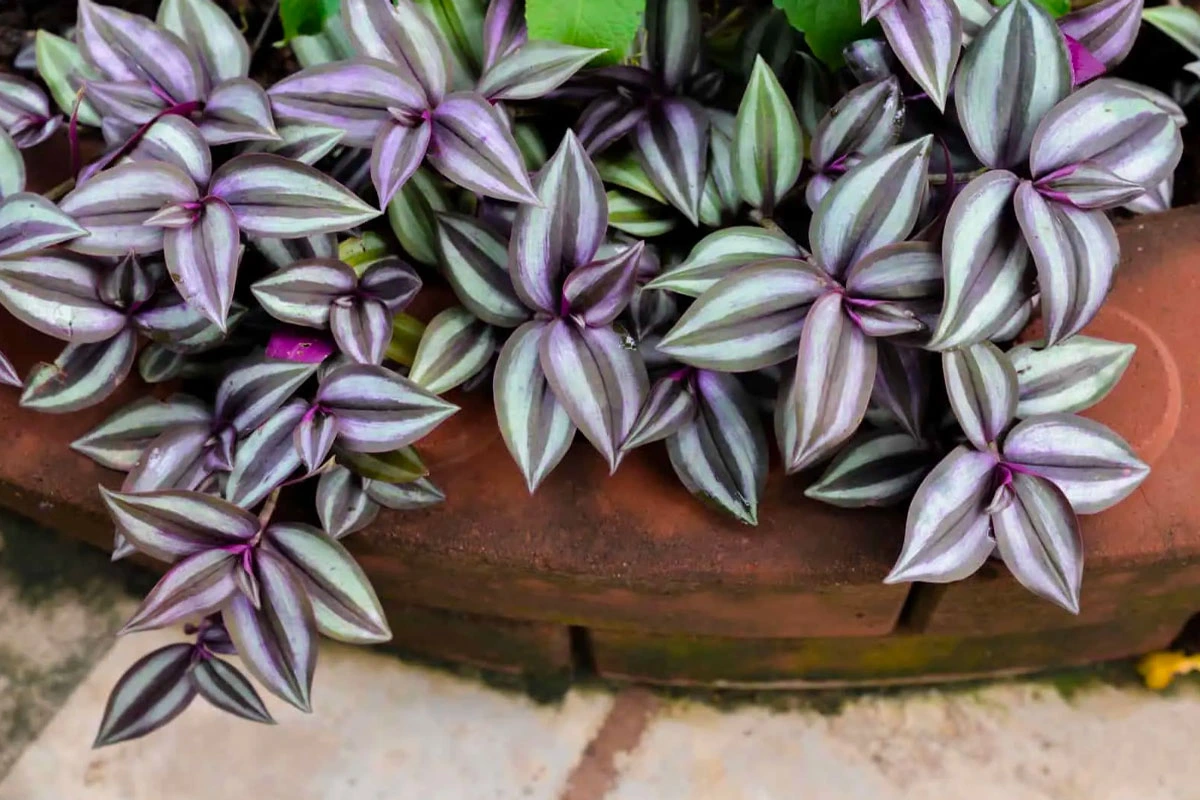
Troubleshooting Additional Issues
Q: Why is my Wandering dude plant developing long bare stems? A: Insufficient sunlight causes lanky, weak growth with bare lower stems. Provide much brighter filtered light or a few hours of direct morning/evening sun. Q: What causes leaf curling and wrinkling in Tradescantia? A: Underwatering causes leaves to wrinkle and curl under as the plant becomes dehydrated. Check soil moisture and water thoroughly when the top inch is dry. Q: How can I revive an overwatered Wandering Dude? A: Allow the soil to dry out completely between waterings. Trim off any rotted roots and repot in fresh well-draining soil. Withhold water again until the soil becomes mostly dry. Let me know if you have any other Wandering Jew or Wandering Dude plant care questions!
Frequently Asked Questions
How much light does the Wandering dude plant need? The Wandering Dude thrives in bright indirect light. Provide some morning or evening direct sun if possible, avoiding intense midday light. Insufficient light leads to weaker growth. What causes leggy growth in my Wandering dude houseplant? Leggy growth results from inadequate sunlight. Provide very bright indirect light or a few hours of direct sun for bushier, fuller growth. Prune stems and fertilize regularly as well. Why are the leaves on my Wandering Dude turning yellow? Lower leaves naturally yellow and drop off over time. But yellowing leaves higher up indicate overwatering issues. Allow the soil to dry out further between waterings to prevent yellowing. How do I encourage new growth in my Tradescantia? Fertilize monthly in spring and summer using a balanced liquid fertilizer to provide nutrients for new growth. Ensure adequate light levels and humidity. Prune back overgrown vines to stimulate new foliage. What are the best ways to use a Wandering Dude in my home decor? Let it trail freely from shelves and hanging baskets, or train vines onto trellises and totems. Position near other tropical looking plants. Allow it to cascade as a lush groundcover or accent piece.
Gruloda Team
Related articles.
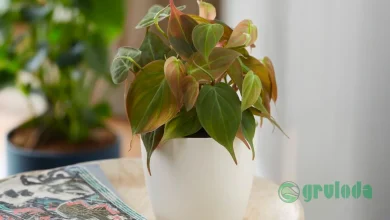
Philodendron Micans Care Guide
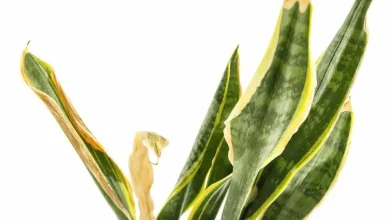
The Silent Killer That Threatens Your Sansevieria
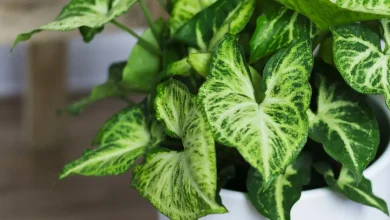
Syngonium Mottled Mojito Care
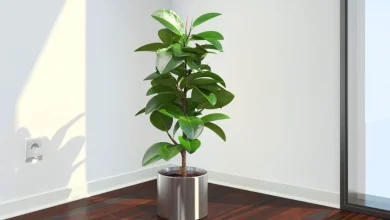
Ficus Elastica Robusta Care

- Indoor Gardening
- Houseplants
- Hydroponics
- Houseplants Made Easy Book

How To Care For A Wandering Jew Plant (Your Complete Guide)
When it comes to houseplants able to brighten up indoor spaces, it doesn’t get much more colorful than the variegated foliage of a Wandering Jew plant ( Tradescantia zebrina ). With their hardy nature and ease of care, they are a perfect choice for those feeling they kill everything they bring indoors. We’ve listed a quick summary of their care below.
How To Care For A Wandering Jew Plant: Grow your Wandering Jew in well-drained soil, kept moist but not soggy through regular watering. Create humidity, keep indoor temperatures between 50°F (10°C) to 85°F (29°C) and fertilize monthly.
Continue reading because we’ve taken all the guesswork out of caring for your Wandering Jew and keeping it healthy and happy for years to come.
How To Care For A Wandering Jew Plant
Wandering Jew plants belong in the Commelinaceae family, which includes around 652 different species. The family is made up of herbs, climbers and several epiphytes, with some used as outdoor and indoor ornamentals like Wandering Jew.
There are three different plants commonly known as Wandering Jews; Tradescantia fluminensis , Tradescantia pallida , and Tradescantia zebrina. Of the three, Tradescantia zebrina is the most common one grown and has the most eye-catching and colorful foliage. All three have the same requirements for care and good growth.
Native to Mexico and Guatemala, Wandering Jew is classified as a tender evergreen perennial that performs well planted outdoors in frost-free regions. Those living in cooler environments can easily grow it as an indoor plant planted either in containers or in hanging baskets. Outdoors it’s typically used as a quick-growing groundcover.
Although a common name shared with several very different plants, Wandering Jew is often called Inch Plant , due to the leaf margins being spaced about an inch apart. You may also find Wandering Jew listed as Zebrina Pendula , but is synonymous with Tradescantia zebrina and is the same plant.

When it comes to Wandering Jew plants, it’s all about the attention-grabbing foliage. The succulent stems give way to leaves that are a deep purple on their undersides with the upper portion striped in silvery-gray and greenish-blue. The oval leaves grow to about 2.5 inches long and the stems grow about 2 feet long. It makes a beautiful plant used in hanging baskets, with the long stems cascading over the side.
Even grown indoors, Wandering Jews have a fast rate of growth and before you know it, the plants will be spilling over your container’s or hanging basket’s sides. Whereas some indoor plants seem to take forever to fill out, this isn’t a problem with properly cared for Wandering Jew plants.
There are several other cultivars (varieties) of Wandering Jew, which include:
- ‘Purpusii’ has unstriped, hairy foliage that is either solid red or reddish-green.
- ‘Quadricolor’ produces metallic-green foliage striped in red, white and green.
Wandering Jew plants are the ideal candidates for beginner houseplant gardeners due to their hardiness and robust growth. Below we’ve outlined all the basics of their proper care, as well as identifying and preventing any potential problems so you can enjoy your Wandering Jew for years to come. The best indoor plants are those that are happy and healthy.

Soil Conditions For Wandering Jew Plants
Wandering Jew plants tolerate growing in a wide range of soils provided they drain well. Although they do tolerate and prefer moist conditions, the soil must drain properly to prevent root and stem rot from occurring. Therefore, it is necessary to use a lighter weight soil mixture in your pots rather than heavier soils that don’t provide proper drainage.
Straight potting soils are usually too heavy, retain too much moisture and have a tendency to leave the soil soggy. You can use a heavier potting soil in your soil mixture, just be sure to incorporate a lighter soil mix to provide the Wandering Jew the drainage required for healthy growth.
Commercial potting mixes work well and many have a slow-release fertilizer mixed in, which cuts down on the need for frequent feedings. The slow-release blends usually continue to fertilize the Wandering Jew for about three months.
You can also make your own soil by mixing several ingredients together such as:
- Using equal parts of compost and a potting mix.
- Mixing equal portions of compost, peat and potting soil or a potting mix.
- Using equal portions of a course sand, compost and potting soil or a potting mix.
Whatever soil you choose to use, just make sure it drains well and contains a bit of fertility for the best performance of your Wandering Jew plants.
Preferred Light Conditions
Although Wandering Jew plants tolerate lower light conditions than many houseplants, to help retain those striking colors the plant is known for, place the container in a location indoors receiving filtered sunlight. If your plant starts losing some of the color in the foliage, move it to a location that receives a bit more light.
In addition, if the lower portion of the stems start suffering leaf drop, the Wandering Jew isn’t get enough light and needs to be relocated to a brighter area inside the home.
Once the warm weather of spring arrives and if you’d like to give your Wandering Jew a bit of a break from its indoor location, place it in an outdoor spot that receives partial sun to partial shade. Moving it to an outdoor location with too much sun may leave the foliage sunburned.
Indoor Temperature Requirements
In the Wandering Jew’s native environment, temperatures are consistently warm without the threat of frosts or freezes. Generally, if the indoor temperatures inside your home are comfortable for you, they will also be comfortable for your Wandering Jew plant.
Indoor temperatures between 50°F (10°C) to 85°F (29°C) are a good range for your Wandering Jew plants. Plants grown in this temperature range produce the healthiest growth.
If you gave your plants a break from their indoor location, just make sure to bring them back indoors before the cold weather of winter strikes.
Water Requirements
Wandering Jews prefer soils that are regularly kept moist, not soggy, compared to many indoor houseplants. However, this doesn’t mean the soil should be kept so wet they never begin to dry out. Keeping the soil too wet for too long promotes rot to set in and you may end up killing your Wandering Jew plants. Your Wandering Jew is more likely to forgive you if you forget to water over watering too much and too often.
A good rule to follow is if the soil starts to feel like it’s about to become very dry, apply water. It’s easy to know exactly when to water by:
- Sticking your finger into the soil and if the top inch is starting to feel dry, water until it runs from the container’s bottom drain holes.
During the warm growing season of spring through summer, you can probably expect to water once each week. However, during winter when the Wandering Jew goes into dormancy (its growth slows), you will probably only need to water about every other week.

Humidity Requirements
Compared to many tropical plants grown indoors, Wandering Jew plants aren’t quite as fussy about humid conditions , but still need some humidity for the best growth and performance. Don’t let the thought of creating a humid environment stress you out because replicating humidity for your indoor plants is relatively easy and basic.
- Fill a spray bottle with room temperature water and mist the Wandering Jew several times each week.
- If you’re growing the Wandering Jew in a container and not in a hanging basket, you can set the pot on a tray of pebbles. As you water, the water seeps from the bottom drain holes onto the tray of pebbles and as it evaporates, it creates a humid environment around the plant.
- If your bathroom gets the appropriate amount of light for the Wandering Jew, you can allow it to grow there. Due to the regular use of water in a bathroom, moisture is created, creating the humidity the Wandering Jew requires.
Fertilizer Needs
Unless the soil mixture contains a slow-release fertilizer blend, which feeds the Wandering Jew for about three months, fertilizing monthly is sufficient for proper growth. You have several choices when it comes to fertilizer you can use for your Wandering Jew plant.
- Use a houseplant fertilizer applied at half-strength, applied when you do your regular watering.
- Use an all-purpose, water-soluble blend for outdoor and indoor plants, applied at half-strength and used during your regular watering schedule.
- If your soil mixture didn’t contain a slow-release fertilizer or it’s been about three months, if one was contained in the soil, you can reapply slow-release fertilizer granules sprinkled over the top of the soil. Follow the package directions on amounts.
When it comes to the appropriate time of year to fertilize the Wandering Jew, only fertilize while it’s actively growing, which is spring throughout summer. In winter, the plant goes through a dormant stage and all growth slows, so there is no need to apply fertilizer. Wait until spring arrives before you resume fertilizing the plant.
The one thing you will need to pay attention to when it comes to fertilizing is the buildup of salts in the soil, which can result in foliage burns. Wandering Jew plants have a low tolerance to salty soils. Preventing any salt buildup is relatively simple:
- If the plant isn’t too big, you can take the entire pot to your sink or bathtub and allow water to run slowly through the soil for about five minutes, flushing out any salts.
- If the plant is too big for indoor flushing, take it outside and allow water from the hose to run slowly through the soil for about five minutes. Allow the water to drain and then bring the plant back indoors.
Pruning Requirements
The pruning needs of Wandering Jew plants are low. If you want to control the size of the plant and promote bushier growth, you can pinch off the tips of the stems. To keep the plant always looking its best, you can trim off any broken, dead or damaged stems and leaves throughout the year.
When using pruning tools to trim your Wandering Jew always make sure they are clean so you don’t transfer any diseases or pests to your plant. This is as easy as wiping off the blades with alcohol.
Some people experience skin irritations when handling the cuttings due to the sap , so if you are unsure if you are one of these unlucky gardeners, it might be best to wear gardening gloves when pruning or handling Wandering Jew cuttings.
Potting Needs
If you purchased your Wandering Jew already potted in a hanging basket or 1-gallon container, it should thrive as is for a year or more before it requires repotting. However, if you received rooted cuttings in smaller containers like 4- to 6-inch pots, you most likely need to repot them into something a bit larger so they can grow properly.
This also cuts down on the need for repotting in a month or two as the Wandering Jew begins to outgrow its present pot.
When it comes to the pot’s material, any type works quite well for growing this plant from clay to plastic. However, if you grow your Wandering Jew in a pot made of a porous material like terra cotta, the soil is going to dry quicker than if it was growing in a plastic pot. This means you will need to water more frequently.
Once your Wandering Jew starts getting too big for its present container, it’s time to repot it into one that is around 1- to 2-inches larger. Although the plant likes a moist soil, make sure the pot has bottom drainage to prevent the possibility of rot due to conditions that are too wet.
If you like, you can dress the container up by placing the draining one inside a decorative pot without bottom drain holes, but be sure to empty out any additional water once the inner pot thoroughly drains.
I think a decorative outer pot can add so much to the beauty of your houseplants, so I do this with almost all of my houseplants. Read this article which discusses my favorite decorative planters if you need some inspiration.
Potting and repotting your Wandering Jew is basic:
- Gently remove the Wandering Jew from its present container, being careful not to break the succulent stems.
- Fill the new container that drains about a quarter of the way full with a fertile, well-drained potting mix.
- Check the Wandering Jew’s root system and if it’s growing bunched together and filled the previous pot, gently tease the roots apart with your hands.
- Place the Wandering Jew into the new container and finish filling it with soil.
- Water the Wandering Jew until it runs from the bottom drain holes and place in a bright location indoors.

Propagating New Plants
When it comes to propagating new plants, Wandering Jew is about as easy as it gets. Even if you have never done this before you should have success starting its cuttings. When you trim to control its size, don’t throw those cuttings away but use them to start additional plants.
You have two choices when it comes to rooting your cuttings and both are easy. The first thing you will want to do is obtain your cuttings. Trim off a 4- to 6-inch cutting from the mother plant and you’re ready to start rooting.
Rooting in Soil
- Fill a 6-inch to 1-gallon container that drains with a rich, well-drained potting mix. Water the soil to settle it.
- Make about a 2-inch indentation in the soil where you want to place the Wandering Jew cutting.
- Remove the bottom leaves from the cutting where you will be inserting it into the soil. You can do this by pinching them off with your fingers.
- Place the cutting into the indentation and firm the soil up around it with your fingers.
- Water the soil again and place the cutting in the same light conditions where the mother plant was thriving. Keep the soil moist but not soggy.
Roots should form in about four weeks and after about eight weeks, the Wandering Jew cuttings should form a new root system.
Rooting in Water
- Fill a glass jar or plastic container with about 3-inches of room temperature water.
- Pinch off any leaves from the section of the Wandering Jew cutting that will be submerged in the water.
- Place the cutting in the water and situate the container in a bright indoor location.
- Change the water in the container about every other week, or when cloudy.
You should start seeing new roots form on the cuttings in several weeks. Once the roots are several inches long, you can repot the cuttings into a draining container filled with fertile, well-drained soil.
Disease Problems
Wandering Jew plants grown indoors are hardy and don’t have major diseases that plague them. However, rot is their biggest enemy and caused by soils that are too heavy and do not drain properly, retaining too much water. Overwatering and planting in pots that don’t drain are other causes of rot problems.
When rot rears its ugly head you’ll notice the bottom stems, as well as the foliage turning black, becoming mushy and the entire plant collapses. If this happens and seems to start affecting the entire Wandering Jew plant, you can trim off healthy, unaffected sections of the stems and repot into fresh, clean soil. Since there is no saving the rot-infected sections, you will have no choice but to discard those portions of the plant.
Steps for preventing problems with rot include:
- Using lightweight potting mixes that drain well and aren’t too heavy, which leads to the soil remaining too wet for too long. Some types of potting soils have a tendency to be heavy and need mixing with a potting mix, compost, coarse sand or peat.
- Don’t overwater your Wandering Jew. Although they prefer growing in moist soils, this doesn’t mean constantly soggy soil. Stick your finger into the soil and if the top inch is starting to become dry, apply water until it runs from the bottom of the pot.
- Make sure the pot you are growing your Wandering Jew in has bottom drainage. If you have placed the pot inside a decorative one that doesn’t drain, make sure to empty all the water from it after you have watered.
Pest Problems
Although indoor Wandering Jew plants are not big candidates for problems with pests, several can cause an infestation and problems. As with any pest problem indoors or outside in the garden, quick control is always the best option to keep your plants healthy. It also assures the pests do not migrate to your other plants causing even bigger problems and headaches.
The pests most likely to infest your indoor Wandering Jew plants are:
- Aphids: Aphids come in a host of different colors and are tiny, pear-shaped, sap-sucking insects that usually congregate in large masses along the Wandering Jew’s stems. In large infestations, they can kill the plant or severely weaken it. If the infestation is small, you can wipe the pests off the stems with a moist cloth. However, if the infestation is large, you will probably have to spray the plant with an insecticidal soap or Neem, reapplying as suggested on the package.
- Spider Mites: Spider mites are another sap-sucking pest that if left unchecked can quickly kill or weaken the Wandering Jew. It is easy to tell if you have a spider mite problem as these tiny, white pests spin fine webbing that covers the plant. Spider mites can be the bane of houseplants so quick control is necessary. Use an insecticidal soap or Neem and spray the entire plant, reapplying as suggested on the product label.
- Whiteflies: Whiteflies are other sap-sucking pests that can quickly kill or weaken your Wandering Jew if not quickly controlled. They are another easily identifiable pest, as just touching the plant sends the tiny whiteflies from the plant’s foliage and into the air, hovering right above it. Control the problem with an insecticidal soap or Neem, spraying the entire plant and reapplying as suggested on the product’s label.
- Mealybugs: Sap-sucking mealybugs show up on the Wandering Jew as cottony masses covering the stems and crotches of the foliage. Control the problem by spraying the entire plant with insecticidal soap or Neem, reapplying as suggested on the product’s label. If the infestation is small, you can also wipe them from the stems and leaves with a damp cloth.

Is Wandering Jew A Perennial?
Wandering Jew plants are considered a tender, evergreen perennial. Unlike annuals, and if grown in preferred conditions with proper care, Wandering Jews should live and keep on growing for quite a few years, both indoors and outside.
Why Are My Wandering Jew Plant’s Leaves Losing Their Color?
If your Wandering Jew is growing in light conditions that are too low, the leaves will start to lose their color and become duller. When grown indoors and to keep the bright color on the foliage, make sure the Wandering Jew is growing in a location receiving bright light.
Why Are My Wandering Jew’s Leaves Dropping?
Wandering Jew plants grown in light conditions that are too low will start dropping leaves at the base of their stems. Solve the problem by moving the plant to an indoor location that is brighter. For the best leaf color and growth, they prefer an indoor location receiving bright light.
Why Are My Wandering Jew Cuttings Rotting In Soil?
If your Wandering Jew cuttings are rotting in soil it could be one of two things causing the problem. The soil you are growing the cuttings in may be infected with a fungus that is infecting them with rot.
You can solve the problem by planting the cutting in a sterile, well-drained potting mix. Another cause might be the soil is remaining too soggy and the container doesn’t drain.
Make sure you are using a soil that drains well and doesn’t remain soggy, do not overwater and use a container with bottom drainage. Water the cuttings when to top inch of soil feels dry to the touch.
Can I Root Wandering Jew Cuttings In Water?
Wandering Jew cuttings root quite well in water. Fill a container with several inches of water, remove any leaves that would be submerged and stick the cut end into the water.
Fill the container with fresh, clean water about every other week. You should start seeing root form on the cuttings in several weeks. Once the roots get several inches in length, you can repot the cuttings in a draining container with rich, well-drained soil.
Are Wandering Jew Plants Toxic?
When it comes to humans, Wandering Jew’s sap can cause skin irritation in humans that are allergic to it. Therefore, it’s best to wear gardening gloves when handling or pruning the plant.
The plant is listed as toxic to dogs and cats, due to its tendency to cause skin allergies and dermatitis. To keep your pets and children safe, make sure you situate your indoor Wandering Jew out of the reach of both.
If you’d like some indoor plants that are non-toxic, check out this article which discusses my favorite non-toxic houseplants.
Do Wandering Jew Plants Produce Blooms?
When grown outdoors, Wandering Jews produce small, three-petaled, lavender flowers, but the plant rarely ever blooms grown indoors as a houseplant.
Can I Grow Wandering Jew Outdoors?
Wandering Jew plants grow as perennials planted outdoors in frost-free climates, however, those with cooler weather can plant outdoors and treat it as an annual.
What’s The Growth Rate For Wandering Jew Plants?
When grown in proper conditions with proper care, Wandering Jew plants are considered fast growers.
Many thanks for reading my guide to Wandering Jew care. This really is a great indoor plant for your home. Beautiful and easy to care for, its hard to go wrong.
If you want more help with looking after your indoor plants, check out the rest of my articles , and head over to my resources section , where I have some great recommended resources, books and equipment to help you grow healthier, more beautiful plants.
Grow. Play. Every Day!

- House & Home
- Houseplants
Wandering Jew Care: How to Grow a Long and Luscious Inch Plant (Tradescantia Zebrina)
Tradescantia zebrina (commonly known as wandering Jew, spiderwort, or inch plant) is popular for a reason: This beginner-friendly houseplant is low-maintenance and grows quickly. It’s also super easy to propagate more plants so you can fill your home with more of the colorful striped foliage the species is known for.
Written by Linda Ly

When it comes to vigorous, colorful, and easy-to-grow hanging houseplants, there aren’t many that can compare to Tradescantia zebrina (known more commonly as wandering Jew—and I’ll touch on the history of that name below). Whether you’re a houseplant beginner or a veteran, most indoor gardeners have owned one of these potted plants at some point.
Keep reading for everything you need to know about Tradescantia zebrina and growing this stunning houseplant in your own home.
Disclosure: If you shop from my article or make a purchase through one of my links, I may receive commissions on some of the products I recommend.

About inch plants
Natural habitat.
Tradescantia zebrina is a native of Central and South America, from Mexico down to Colombia, as well as the Caribbean. Here, it forms part of the undergrowth in lightly forested and often very moist areas. It can form very dense, wide mats thanks to its creeping growth pattern and ability to throw roots extremely quickly.
Unfortunately, its vigorous growth has also made Tradescantia zebrina an invasive plant in some regions. This includes Hawaii, Brazil, and Australia, where the species easily takes hold in moist, forested areas.
As a 2019 study carried out in the Brazilian Atlantic Rainforest notes, this is problematic due to the species choking out native plants.
Some of the above was caused by careless gardeners allowing bits of the plant to get into the wild, where they quickly root. If you’d like to grow spiderworts like this one in your garden, please make sure to dispose properly of any trimmings left after pruning!
This also applies to zebrina’s popular cousins, like Tradescantia fluminensis, T. pallida, and T. spathacea.
Description
It’s not difficult to see why Tradescantia zebrina gained popularity as a houseplant. Wandering spiderwort plants (not to be confused with spider plants , another beginner-friendly species) are low-maintenance and grow just about anywhere—they even just grow in water !
Easy care and quick growth aside, spiderworts are also just good-looking plants. The pointed, oval leaves on thin, fleshy stems overlap slightly and are characterized by their zebra pattern in purple and silvery green. The leaf undersides are deep purple in color and the tiny, three-petaled flowers are bright pink.
Although this species is naturally a creeping plant, it’s often grown indoors in hanging planters. As long as the plant is provided with enough light, the foliage will be very dense and brightly colored, forming a spectacular waterfall that can reach more than 3 feet in length.
What’s in a name? In the case of common houseplants, sometimes a lot.
Tradescantia zebrina is a classic houseplant (I found mention of it in a 1964 German book about houseplants, but it’s probably been around longer than that!) and among most English speakers, it has long been known as wandering Jew. This is probably a reference to the “wandering” nature of the plant, as it does have a creeping growth pattern.
The legend of the wandering Jew is hundreds of years old and is now commonly considered to be rooted in antisemitism. It describes a Jewish man cursed to walk the planet until the Second Coming because he taunted Jesus on his way to the cross.
Because of this, the plant name has partly fallen out of fashion and has been the source of much debate in the plant world over the past few years.
Some plant enthusiasts have embraced the alternative “wandering dude,” which I personally think is a great option.
“Inch plant” (houseplant enthusiasts don’t agree on whether this refers to the fact that it can grow an inch a day, or that you only need an inch of stem to propagate it), “spiderwort,” or “wandering spiderwort” are also popular alternatives, though these are common names for other Tradescantia varieties, such as Tradescantia Nanouk.
The best way to avoid any confusion is to just stick to the scientific name.

Inch plant varieties
There are three subspecies of inch plant (wandering Jew): Tradescantia zebrina var. zebrina, var. flocculosa, and var. mollipila. Unsurprisingly, after it having been a popular houseplant for so many years, nurseries have also managed to create a whole bunch of cultivars through selective cultivation.
A few of the popular Tradescantia zebrina cultivars you may come across in your local plant store include, but are certainly not limited to:
- Tradescantia zebrina ‘Quadricolor’: Yep, as the name suggests, this one adds an extra color to the mix. The leaves are cream, pink-purple, light green, and dark green.
- Tradescantia zebrina ‘Burgundy’: Characterized by its very dark purple coloration.
- Tradescantia zebrina ‘Silver Plus’: Less purple, more shiny silver.
- Tradescantia zebrina ‘Red Gem’: Less silver, more intense (light) purple.
- Tradescantia zebrina ‘Purple Joy’: Less silver, more dark purple.
- Tradescantia zebrina ‘Tikal’: A rare, naturally occurring variety that collectors pay a pretty penny for.
Do keep in mind that most of these cultivars aren’t patented and the amount of mislabeling and variation within a cultivar are both huge. Just growing your wandering Jew in lower-light conditions can completely change the way it looks, so it’s not surprising that confusion sometimes reigns supreme.
Luckily, care is the same across all cultivars, so your best bet is to just enjoy your plant even if you’re not sure what Tradescantia variety you’re dealing with!
Where to buy wandering Jew plants:
- California Tropicals
- Daylily Nursery
- The Green Escape

Caring for an inch plant
Light and temperature.
It’s important to provide your Tradescantia zebrina with enough light. It’s tempting to use plants to brighten up dark, shaded spots in your home, but that just doesn’t work with this one: It loses its dense growth pattern and beautiful coloration in low light.
To prevent your wandering dude plant from growing sparse and green, place it near a window that gets bright indirect light. Some full sun isn’t a problem either, but do make sure you acclimate it gradually to a higher light location.
Temperature-wise, this species is a lot hardier than many of the tender tropicals we like to grow in our homes (like Anthurium andraeanum and Begonia maculata ).
Wandering dude plants can handle a very wide range of temps, making it perfect for those chillier windowsills that your other plants may not appreciate. Room temperature is ideal, but anything between 50°F to 85°F will keep them happy.
Water and humidity
Your Tradescantia zebrina will appreciate lightly moist soil. You can water a bit more during the summer months, when the plant is actively growing and needs a lot of moisture, and less during winter, when soil tends to take significantly longer to dry.
If you’re not sure whether it’s time to water your wandering Jew plant yet, you can always turn to the age-old trick of sticking a finger in the soil.
- If it still feels damp, wait a little longer, until the first inch or two has dried.
- If it feels bone dry, you’ve waited too long; you may also see limp leaves on your plant at this point. It’ll bounce back, but not always without lasting damage.
- If the soil feels wet, you watered too much and need to keep an eye out for root rot.
As for humidity, given its rather wet natural habitat, wandering Jew does appreciate higher air moisture levels. The great thing is, though, that it doesn’t demand it. As long as you keep its soil lightly moist and the air isn’t extremely dry, your plant should do well.
Soil and planting
Wandering Jew is not fussy about its potting mixture at all. I’ve grown it in pure houseplant potting soil with no additives. If you do want to take things to the next level, you can add some perlite and/or peat moss, although this is really not a must.
Most houseplant enthusiasts like to place their wandering Jew in a hanging planter so they can enjoy the look of the leaves cascading down. This is not a must, though. You can also emphasize the species’ creeping growth habit by filling up a large, shallow planter, growing it in a terrarium, or even keeping it in water on a semi-permanent basis.
Recommended products for wandering Jew plant care:
- FoxFarm Ocean Forest Potting Soil
- Espoma Organic Potting Mix
- Perfect Plants Organic Perlite
Fertilizing
Like most other houseplants, Tradescantia zebrina appreciates a bit of fertilizer during the growing season, which extends from spring to early fall. You can use a normal houseplant fertilizer according to the instructions on the bottle.
Don’t fertilize during the winter months unless your plant is growing well. It doesn’t need extra nutrients if it’s inactive.
Recommended fertilizers for wandering Jew plants:
- Houseplant Resource Center Liquid Fertilizer for Houseplants
- Instant Biologics Instant Plant Food (Fizzing Nutrient Tablets)
- Maxsea All-Purpose Seaweed Plant Food
Pruning
There’s a good chance you’ll have to prune your Tradescantia zebrina regularly, because as I mentioned, this is a very quick grower. It also roots very easily, so any trimmings can be replanted! I’ll describe how to do this in the section on propagation below.
Aside from stem trimming, you can remove any dead leaves, which are bound to pop up from time to time in very dense plants like this species.
Dividing or repotting
Inch plants don’t grow by producing plantlets at their base like many other houseplants (such as spider plants ) do. Instead, inch plants spread by rooting along the stems.
This means that division is not really the way to go; keeping these plants manageable is usually done through pruning. You can shape your plant by pinching off any long, leggy stems to create a fuller appearance and control its spread.
You’ll notice that Tradescantia really doesn’t mind being a bit cramped in its planter. Still, it’s a good idea to provide your plant with some fresh soil every year or two by repotting it.

Propagating an inch plant
If you’ve never propagated a houseplant before, this is truly one of the best species to start with. It’s known for rooting extremely quickly in both water and soil, meaning it’s easy to fill endless planters to keep or give away.
All you need to propagate your Tradescantia zebrina is a pair of clean scissors. Here’s how you do it:
- Snip the ends off existing branches. An inch or two with a few leaves works best.
- Remove the leaves at the bottom so part of the stem is exposed.
- Place the cutting in a glass of water to root or plant it directly in soil. You can put cuttings back in the mother plant’s pot to give her a fuller appearance on top.
- It can take a little longer during the winter months, but the first roots should appear within a week or so. You can give soil cuttings a slight tug to verify they’ve rooted.
- Once the first signs of new foliage appear, you’ll know your propagation attempt has been a success!
- If you propagated in water, you can leave the rooted cuttings in water almost indefinitely, although you can also pot them up in fresh soil.

Common questions about inch plant care
How do i make a wandering jew plant bushy.
By their very nature, wandering Jew plants are not bushy. Their creeping growth habit means they naturally grow leggy over time, especially in containers.
However, you can mimic a fuller appearance by strategically pinching off any long, spindly stems to shape the plant more. These stems can also be replanted near the mother plant.
As the baby plants grow, they’ll help fill in sparse areas and create the illusion of a bushy wandering Jew.
How long do wandering Jew plants live?
Wandering Jew plants have a limited lifespan of just a few years, and as a potted plant, you’ll notice your wandering Jew becoming very leggy after just two to three years.
Unlike other fast-growing plants that benefit from pruning, cutting back a wandering Jew doesn’t work well to renew its growth; it simply controls the spread.
The best way to keep your plant coming back year after year is to propagate new plants from stem cuttings, which—fortunately—is super easy with a high success rate.
Is wandering Jew perennial?
Wandering Jew (Tradescantia zebrina) is a trailing evergreen perennial in its native habitat (USDA hardiness zones 9 through 12). Where it’s not winter hardy, wandering Jew is grown year-round as a houseplant.
Are wandering Jew plants toxic to cats and dogs?
Wandering Jew is not considered outright toxic, but it can cause some skin irritation. If your pet gets into your plant, don’t worry too much, although it can be a good idea to have a look in its mouth to make sure there’s no excessive swelling. Be sure to offer water. To prevent skin rash, it can be a good idea to wear gloves if you need to handle your wandering Jew plant. This especially applies if you have sensitive skin.
https://www.cabi.org/isc/datasheet/110354
Racism in Taxonomy: What’s in a Name?
Chiba de Castro, W. A., Xavier, R. O., Garrido, F. H., Romero, J. H., Peres, C. K., & da Luz, R. C. (2019). Fraying around the edges: negative effects of the invasive Tradescantia zebrina Hort. ex Bosse (Commelinaceae) on tree regeneration in the Atlantic Forest under different competitive and environmental conditions. Journal of Plant Ecology, 12(4), 713-721.
Encke, F. (1964). Pflanzen fur Zimmer und Balkon; Auswahl, Pflege, Vermehrung.
I'm a plant lover, passionate road-tripper, and cookbook author whose expert advice and bestselling books have been featured in Time, Outside, HGTV, and Food & Wine. The National Parks Cookbook is my latest book. Garden Betty is where I write about modern homesteading, farm-to-table cooking, and outdoor adventuring—all that encompass a life well-lived outdoors. After all, the secret to a good life is... Read more »
We bought a full grown Bolivian Jewel mid summer last year. It was in a 14” raised pot and flowing 2 foot over the sides. It was beautiful next to our fountain outside. We live in Minnesota so we had to discard it in the late fall since we had no place to care for it in the house. Since we can’t find another like it we’d like to plant one from scratch but how. We still have the pot and riser but have no idea how to start from that. One plant, a few or just how many to make a bushy over grown plant so it looks like the one we purchased last year. Does this make sense or should we just forget it since it is already the middle of May. The greenhouse that we bought it from last summer doesn’t have any this year, just small ones in 4” pots. Thanks
If you can only grow it as an annual (and won’t be overwintering it indoors), you can plant a few smaller ones together to make them look fuller as they grow.
It seems counterproductive to talk about the problematic origin of the name wandering Jew, recommend multiple alternative names (including scientific), but then continue to call it wandering Jew in the rest of the article. If the name is anti-Semitic just set a good example and use a different name.
Leave a Reply Cancel reply
Your email address will not be published. All fields are required.
Save my name and email in this browser for the next time I comment.
This site uses Akismet to reduce spam. Learn how your comment data is processed .
Recommended Reads
- Garden of eatin’

The No-Dig Garden Method: Make Amazing Soil With Less Work

Solarizing Your Garden: How to Use the Sun to Control Weeds and Pests in the Soil

How to Plant a Three Sisters Garden: The Original Companion Plants

How Much to Plant for a Year’s Worth of Food

What You Should Know Before Buying Land (My Real-Life Tips)

Construction Loans: What I Wish I’d Known As a First-Time Borrower

Dark Room? 9 Actually Low-Light Plants That Don’t Need a Lot of Sun

Getting Rid of Fungus Gnats: 11 Remedies That Really Work

My Favorite Ruby Red Sauerkraut Recipe (and Why It’s So Good For You)

How to Make Nukadoko (Fermented Rice Bran Bed) for Pickling

Easy 4-Ingredient Colorful Homemade Pasta—No Pasta Maker Needed

The Best Homemade Limoncello
Want to level up your garden this year.
Sign up for my free, never-boring newsletter and every week you’ll get the game-changing emails you wish you’d gotten sooner.
- About Linda Ly
- What’s In My Garden
- Lazy Gardening Academy
- Sponsorships
- Site Policies

Back to the top
Disclosure: Garden Betty independently selects products to feature on this site. I may receive a commission when you buy something through one of my links. As an Amazon Associate, I earn from qualifying purchases.
© 2024 Garden Betty. All Rights Reserved.

- Privacy Policy

- Houseplants
- Gardening And Landscaping
Wandering Jew Plant (Tradescantia or Spiderwort): Care, Types, Images and More
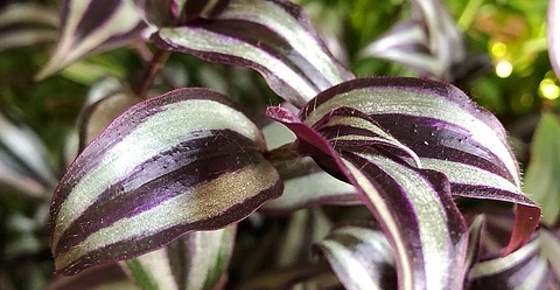
The wandering Jew plant is a common name for different species of plants that belong to the Tradescantia genus. There are around 75 different types of plants in Tradescantia genus and some are called inch plants, spiderwort, striped wandering Jew, Boat Lily, Purple Queen, or flowering inch plant. Wandering Jew plants are great house plants because they are relatively easy to care for. They are also easy to grow because the wandering Jew plant propagates easily from cuttings.
Some types of wandering Jew plants have green and gold leaves, some have reddish leaves, and others have green fuzzy leaves. There are also types of wandering Jew plants that flower. Depending on the species, the wandering Jew plant could have purple, white, or pink flowers.
How to care for wandering Jew plant : For the Tradescantia or spiderwort plant to thrive, grow in a plenty of indirect light and plant in fertile, moist potting soil with good drainage. Make sure the soil isn’t too dry or too damp and keep medium humidity levels. The ideal temperature range is between 65°F (18°C) and 75°F (23°C). You can fertilize every four weeks during the growing season with a diluted liquid houseplant fertilizer.
In this article, you will find all you need to know about this delightful houseplant. You will also get tips and ideas on how to care for your wandering Jew plants.
Wandering Jew Plant (Tradescantia or Spiderwort) – Overview of the Plant and Its Flowers
The botanical name for wandering Jew plant is Tradescantia zebrina and is also called the inch plant. However, the name wandering Jew is given to many herbaceous perennial plants in the Tradescantia genus. ( 1 )
Species of Tradescantias naturally grow outdoors in countries in Asia, Africa, Central and South America, and Australia. Varieties of wandering Jew plants also thrive well indoors, where, like their garden varieties, they grow well when it is warm, sunny, and moderately humid.
According to the United States Department of Agriculture, various varieties of Tradescantias are regarded as invasive plants in the wild. However, it is the fast-growing nature of spiderworts, wandering Jews, and inch plants that makes them perfect houseplants. ( 2 )
Many people like to grow wandering Jews or spiderworts in hanging baskets or grow them in pots to decorate a garden.
What does a wandering Jew look like?
Plants from the Tradescantia varieties have leaves that seem to grow in all directions (hence the term “wandering Jew”).
One of the distinct features about foliage on wandering Jews is that many of them have striped leaves. Sometimes, the leaves can be purple and silver stripes, whereas other types of Tradescantias have leaves that are almost all silver. ( 3 )
You may also notice that some varieties of wandering Jew plant have different colors on the underneath of the leaf. For example, the Tradescantia zebrina has green/silver leaves on the upper side and deep red or burgundy colors on the underside.
Wandering Jew flower
Wandering Jew houseplants also produce attractive flowers. These flowers can sometimes be white or can range in color from pink to various shades of lilac and purple. ( 3 )
However, plant lovers don’t usually grow wandering Jews indoors or outdoors for their blooms. It’s the beautiful variation of leaf colors that makes various types of Tradescantias so desirable houseplants.
Types of Wandering Jew (Spiderwort) Plants
The most popular types of Tradescantia plants to keep indoors are Tradescantia fluminensis ( spiderwort ), Tradescantia pallida ( purple heart ), and Tradescantia zebrina ( wandering Jew ).
Wandering Jew or inch plant ( Tradescantia zebrina )
This type of wandering Jew houseplant has purple and green leaves with a stripe pattern that resembles zebra’s stripes. There are types of wandering Jews that have bluish green leaves and purple hues on the underside.
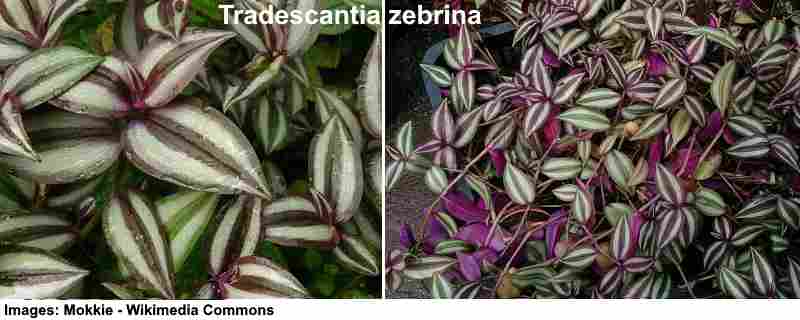
Tradescantia fluminensis (spiderwort)
There are a number of types of Tradescantia that are called spiderwort. This is distinguished from some Tradescantias as it has ovel shiny dark green leaves with pointed tips which are slightly fleshy .
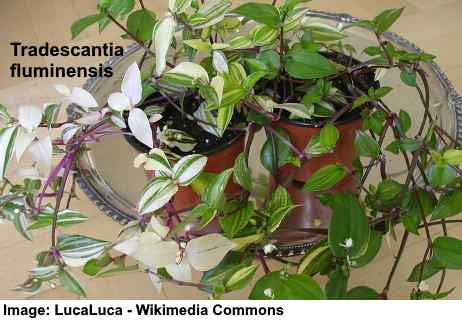
Picture of wandering Jew plant with white flowers
Tradescantia pallida (purple heart)
This type of spiderwort plant is also commonly referred to as wandering Jew. The T. pallida houseplants have vibrant purple leaves and light pink flowers when they bloom.
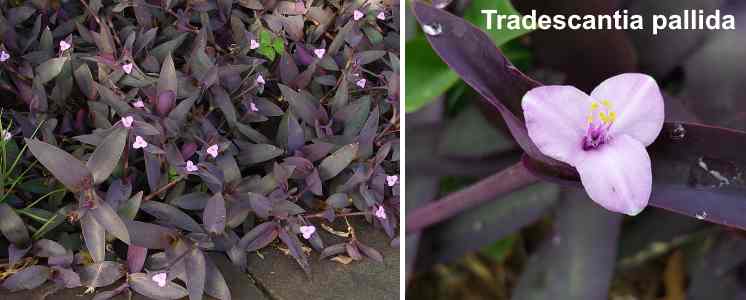
Wandering jew plant with deep purple leaves and light purplish-pink flowers
Tradescantia callisia
The leaves of T. callisia varieties are sometimes referred to as creeping inch plants. They have remarkably stripy leaves made up of green and white stripes.
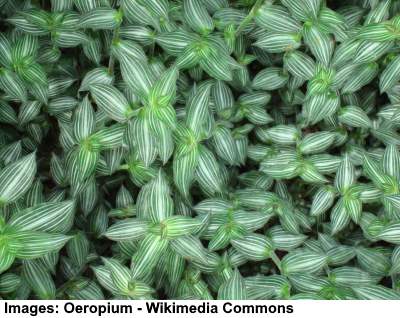
Picture of green wandering jew
Wandering Jew Plant Care (How to Grow Spiderwort or Tradescantia)
Caring for wandering Jew plants is fairly simple and straightforward. All plants in the Tradescantia genus enjoy moist soil, sunny but indirect sunlight, and warm conditions.
So, it doesn’t matter if you have fuzzy leaf Tradescantias, purple queen varieties, spiderworts, or wandering Jews, they all require the same type of care.
Light requirements for Tradescantias
To make sure that wandering Jew plants grow successfully, they require a good amount of light. This ensures that they grow with healthy leaves that have a vibrant green, silver, purple, or lilac colors.
The best place to place wandering Jew plant or spiderworts is in an east- or west-facing location. This means that they get plenty of natural light without being in direct sunlight when the sun is at its strongest.
The only exception is if you have Tradescantia pallida plants with dark purples leaves. They usually thrive in direct sunlight, although you should regularly check them in the summertime to make sure the sun isn’t too strong.
One sign that your Tradescantia isn’t getting enough light is if the color of their leaves starts to fade.
Best growing temperature for Spiderwort or Tradescantia
One of the reasons why wandering Jew plants are good for the home is that they thrive in room temperature.
The best temperatures for growing any type of Tradescantia plant is between 65°F (18°C) and 75°F (23°C). The houseplants also thrive in conditions that are described as “average humidity.”
If you grow Tradescantias outdoors, you should be aware of a drop in night temperatures and lower temperatures during winter. You should bring Tradescantias indoors if the temperature drops.
Best watering techniques for wandering Jew plant care
To care for your inch plant, spiderwort, or wandering Jew, you should keep the soil moist.
The best way to water a wandering Jew is to water the soil thoroughly and let the water drain out the bottom. Another way to water your purple house plant is to put water in the plant pot tray and allow the plant to soak up as much as it needs.
Some beginners who start caring for houseplants such as Tradescantias for the first time buy a soil moisture gauge to help get the soil moisture levels just right.
When it comes to proper watering for your wandering Jew, always make sure the soil isn’t too dry or too damp. Usually, weekly watering in the summertime is enough to keep your Tradescantia growing well.
The best fertilizer for wandering Jew houseplants
The reason why Tradescantias are so easy to care for is that they don’t usually require any feeding.
If you decide to encourage your inch plant or spiderwort to grow faster, then choose a liquid organic fertilizer mixed at half strength and use once a month.
Most houseplant growers don’t feed their wandering Jew plants in the fall or winter as they tend to become “leggy” or “straggly.”
Which type of soil to use for Tradescantias
To properly care for wandering Jew varieties of houseplants, you only need to plant them in regular potting soil.
How to prune wandering Jew plants
In time, Tradescantia plants require some cutting back and pruning. This helps to give your houseplant a bushier appearance and also gives you plenty of cuttings to propagate.
For Tradescantia pruning, you just need to pinch off the stem tips to leave about ¾ of the length. This will encourage your plant to grow better and become more attractive.
Growing Plants from Wandering Jew Cuttings
Even for the most novice of houseplant owners, propagating any type of Tradescantia plant is very easy. After you have cut back your “leggy” wandering Jew stems, you will have a large number of cuttings that you can use to grow new house plants.
How to propagate wandering Jew plant leaves
To prepare your wandering Jew cuttings or purple heart plant cuttings for propagation, you need a couple of stems about 1-2 inches long. Remove all the leaves apart from 2 or 3 at the end of the stem.
There are 2 ways you can grow wandering Jew plants from cutting:
- The first way is to just put a cutting in potting soil and wait for it to grow. All you have to do is make sure that the soil is kept moist and not overly damp.
- The other way to grow a Tradescantia from a cutting is to put the stem in water. You should notice that new roots start to grow within a week. When you notice new roots growing, you can transfer your cuttings to a pot to grow a new houseplant.
Wandering Jew Outdoor Plant Care
Tradescantia plants are great garden plants and grow well outdoors in warmer zones in the U.S. (USDA growing zones 9-11). In fact, it is because they grow so well outside in warmer countries and are quite invasive that they are classed as a weed in certain countries.
You can easily care for any Tradescantia plants to add color and beauty to your garden. Purple hanging plants or wandering Jew vines with stripy leaves can grace any patio, doorway, or garden area.
As with caring for wandering Jews or spiderworts indoors, Tradescantia plants growing outdoor should be protected from direct sunlight. So, place your plants in shady areas of the garden. But it’s good to remember that some bright light will help the wandering Jew plant produce more flowers.
Temperature
Also, frost can damage the plant, so, if you live in areas where fall and winter temperatures drop below 10°F (12°C), you should take them indoor and continue to grow them as houseplants.
Problems with Wandering Jew Plant (Spiderwort)
Even though it is relatively easy to care for wandering Jew plants, you can still come across certain problems.
Let’s look at some growing tips for Tradescantia plants to avoid or remedy some common problems.
The most common pest when growing wandering Jews indoors are bugs such as spider mites or aphids . The appearance of these pests on your bushy spiderwort or inch plant may be a sign that conditions are too dry.
To help remedy the problems of pests on your Tradescantia, mist the leaves regularly and make sure the soil is moist enough. You may need to wash off the mites with water to help get rid of the infestation.
One of the beauties about caring for wandering Jew plants indoors or outdoors is that they are not susceptible to disease. Usually, any discoloration of the leaves or poor growth is connected to the soil being too dry or too damp.
Fungal infections
Overwatering spiderworts, inch plants, or wandering Jews can cause a fungal growth called botrytis to develop in the roots.
Brown leaves
As with most problems associated with caring for Tradescantias, brown leaves can also indicate that the growing environment isn’t right. The leaves of your wandering Jew could have turned brown because of too much or too little sunlight. Also, too much watering can affect leaf health.
Where to Buy Wandering Jew Plants
Many garden centers and online stores stock many different varieties of wandering Jews. You will also find that Tradescantia cuttings are available online.
Because many different types of wandering Jews are so easy to grow yourself, you could ask a friend for a cutting if they have the plant. You can also get more Tradescantia houseplant or garden plants by propagating cuttings from plants you already have.
FAQ Related to Wandering Jew Plant (Tradescantia)
Do they need any pruning.
To properly care for wandering Jews, the leaves and stems require pruning. The stems can grow quite long and start losing their leaves from the base. The best time to prune any Tradescantia plant is just before the growing season in late winter or early spring.
You may also find that Tradescantias grow better if you give them a mild prune in late summer.
How to prevent wandering Jew roots from rotting?
Go easy on the watering to stop Tradescantia plants’ roots from rotting. Water them enough to keep the soil moist during summertime and only occasionally in the winter.
Are wandering Jew plant leaves toxic to animals?
While not toxic to cats or dogs, the leaves of wandering Jew plants can cause irritation. If you have pets that like to nibble on leaves, you can still benefit from the beauty of Tradescantias if you grow the outdoor plant in hanging baskets.
Can I grow my Tradescantia plant outdoors?
Yes, you certainly can. Wandering Jew plants grow well out of doors in warm climates. During the summertime, you can move your indoor houseplants to the garden and place them away from direct sunlight.
Dashes of purple colors, bright pinks, or interesting green and purple stripped leaves can make an interesting feature in any garden or balcony.
Can you train a wandering Jew plant?
Tradescantia plants are easy to train because their stems can grow very long and you can wrap them around objects. Wandering Jew plant stems can grow up on trellises or obelisks or up around any other item.
Heavily pruning wandering Jews in late winter can also help to train the plant to grow into a colorful bush.
How fast does wandering Jew plant grow?
Tradescantia cuttings should start growing roots within a week or so. Once the plant is established, you can expect it to grow about an inch every week. Some people claim this is the reason that some Tradescantias are called inch plants.
Can Tradescantia houseplants cause allergies?
The sap of wandering Jew plants or prolonged skin exposure to its leaves could cause allergic reactions.
The journal Allergy reports that indoor plants such as Tradescantia can also cause symptoms such as itching of the throat, swelling, wheezing, and runny eyes and nose. ( 4 )
Do wandering Jew varieties have any health benefits?
Although not widely used, extracts from Tradescantia zebrina have certain medicinal properties. You can buy inch plant herbal liquid extracts that are said to have many antioxidant properties.
Researchers have found that therapeutic compounds in Tradescantia extracts have antibacterial, anticancer, and antioxidant uses. ( 5 )
Related articles:
- Moses In Cradle Care: How to Grow Tradescantia spathacea
- Chinese Money Plant Care: How to Grow Pilea Peperomioides
- Dracaena Marginata Plant Care: How to Grow Madagascar Dragon Tree
Wandering Jew Plants Guide: How to Grow & Care for “Tradescantia zebrina”
It might surprise you to learn that “the wandering Jew” isn’t a single plant, its name used to describe a collection of plants in the Tradescantia genus.
Many countries around the world view the wandering Jew as an invasive species. Therefore, you won’t find many of them as regular additions to gardens . However, the vine makes for an excellent indoor plant .
Table of Contents
Quick Facts
Wandering jew plant varieties.
The wandering Jew refers to three different plants in the Tradescantia genus. The three varieties are the zebrina, fluminensis, and the pallida.
Tradescantia Zebrina
The zebrina is the most common of the three species, and it features dark-green foliage that contrasts against the brilliant-white three-petal flowers the plant produces.
As you can imagine, the plant also gets part of its name from the zebra-like foliage. The center of the leaf id has a creamy-white color, and the outer trimming of the leaves has a silver lining.
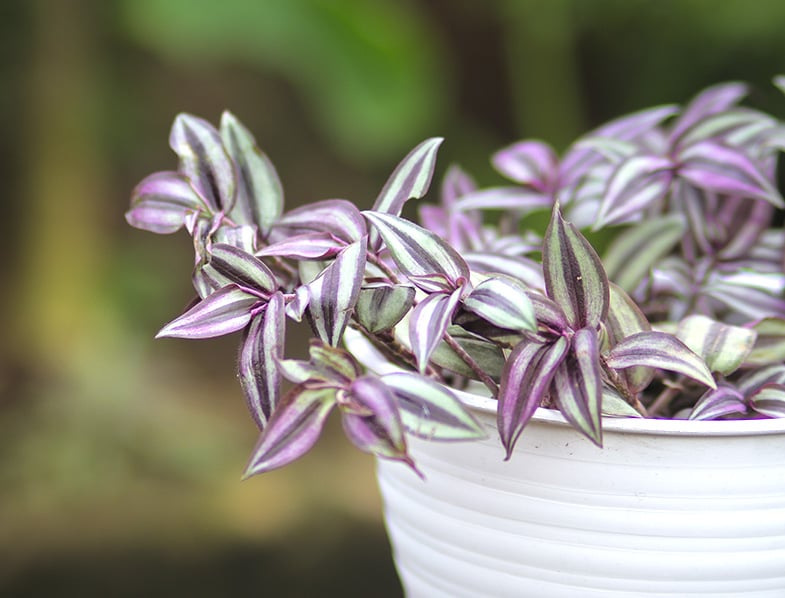
Tradescantia Fluminensis
This wandering Jew species features white flowers, and it’s a trendy indoor plant around the world. The species originates from the southeastern region of Brazil. It’s an evergreen perennial plant that flowers all-year-round and lasts for many years if the owner takes care of it correctly.
The oval-shaped foliage of the Fluminensis is green in color and has a glossy look. The leaves attach to fleshy stems, and the stem nodes quickly put roots down into the soil, allowing for the rapid spread and growth of the plant in ideal growing conditions.
When the plant flowers , it produces a set of flowers with three white petals. The flowers don’t bear any seeds, and they might also emerge in clusters. There are various sub-species of this plant as well, and some types, such as variegate, feature different leaf colors, such as yellow or cream streaks in the leaves.
The plant does best in USDA zones 9 to 12, as it loves the additional humidity in these regions as well. The wandering Jew doesn’t do well in colder climates, so stick to planting in the southern states.
The wandering Jew also prefers full sunlight during the day, and you’ll need to feed it a reasonable amount of water throughout the week. The plant doesn’t enjoy being dry for long periods.
Tradescantia Pallida
This variety originates in Mexico, and it’s the most attractive of the three Tradescantia genus. This wandering Jew produces long, pointy leaves that can reach lengths of 7-inches. The leaf will eventually turn a purple color, but the tips might remain red or green during the color transition.
There are visible segmentations on the stem of this wandering Jew, and it’s for this reason that many countries classify this plant as invasive.
The segments break easily, but they root readily, evolving into two plants with little care. Fortunately, for fans of the plant, it also makes it easy to grow the plants for cuttings as well.
Tradescantia pallida don’t like the cold, and it will die back in colder environments in the Northern states, especially if it grows outside. This wandering Jew produces small flowers that bloom in colors of pink, lavender, and white. The flowers feature three petals, and while they aren’t show-stopping, then do add a beautiful aesthetic to the plant.

- shipped in inproved box to save the plant

Last update on 2024-05-02 / Affiliate links / Images from Amazon Product Advertising API
Natural Air Cleaners
One of the reasons why the wandering Jew is such a popular house plant is its natural air-cleaning properties. The wandering Jew is an excellent “air scrubber,” and it removes bacteria and VOCs from the air inside your home, exchanging it for fresh air that enhances your home.
Some research also shows that the wandering Jew can assist in soil remediation, as well. The plant can remove heavy metals from the soil, helping restore the root health of other plants in the same flowerbed or pot.
Caring for Your Wandering Jew Plant
All varieties of the wandering Jew are easy to care for, provided that you grow them in the right climate and conditions. As long as the plant receives regular watering and pruning, it will thrive, and you’ll also manage to control the growth as well.
If you plant in a sunny spot in your home, then you can expect your tradescantia to last for many seasons. It’s also important to note that the plant might not flower it in its first season. However, by the third year, you should see plenty of flowers that emerge in the summer months.

As mentioned, the wandering Jew prefers sunny planting locations. The plant prefers later afternoon sun to morning sun, but it does well in any sunny area around the home. The more light you give the plant, the more flowers it produces in the flowering season.
If your wandering Jew does not get sufficient sunlight, you’ll notice that the color of the leaves starts to fade. Move the plant to a sunny spot, and it should recover in less than a week.
The wandering Jew enjoys a balanced moisture level in its soil . Don’t let the earth get too dry, as it might cause burning in the tips of the leaves. Likewise, the wandering Jew does not enjoy excessively wet soil either. The plant is susceptible to forming root rot if you “keep its feet wet.”
To check if it’s time to water your wandering Jew, push your finger about 1-inch into the soil. If it feels dry, then give your plant some water.
You must ensure you use a rich, loamy soil that drains well when planting your wandering Jew. When planting in a pot, make sure you add a layer of gravel at the bottom of the pot to enhance drainage. Add perlite to the soil to assist with drainage as well.
You can get away with using a standard potting mix when planting indoors , and other soil enhancements we recommend you add are the following.
- Coarse sand and perlite for drainage
- Humus or peat
- A light dusting of lime
- A few handfuls of rich organic compost
You want the soil to retain water but still allow optimal drainage.
During the growing season, fertilize your wandering Jew plant using a liquid-based fertilizer product. Make sure that you dilute the fertilizer to 50-percent strength.
Strong concentrations can result in burning in the tips of the leaves of the plant. You can also add a granular slow-release fertilizer to the soil once a year at the start of spring.
The wandering Jew grows quickly, and it might take over its pot in one or two seasons, depending on the size of the container. Therefore, you’ll need to pull up the plant and divide it from year-to-year, depending on its growth rate.
If you choose to re-pot your plant, make sure you use a pot that’s at least 50-percent larger than the old one. Line the pot with potting soil and a few handfuls of rich organic compost. Dig around the edges of the existing container to loosen the root ball. After loosening, pull the base of the plant to release it from the pot.
Move the plant to its new pot, and then fill with potting mix to cover the roots — Pat down the soil, and then water lightly.
Wandering Jew plants require regular pruning . The plant grows quickly, and if you don’t prune, then it can overtake the pot fast. Pruning also helps the stem, from getting “leggy,” meaning that the plant starts to look bare at the base. Pruning keeps the plant healthy and growing at an optimal rate.
All; you need to do is prune back any stems and pinch the stem tips. The wandering Jew will then send out two new shoots from the pinched top, helping your plant spread out into a bush-like appearance.
Propagation
The wandering Jew is easy to propagate . This plant grows quickly in a variety of conditions, which is one of the reasons why most countries list it as invasive. You can propagate your cuttings after your pruning session, without much effort.
Remove all of the leaves but the top set after pruning the stem. Place the cutting in another smaller pot with moist potting soil . Leave the container in the sun, and you should find that the cutting roots in a month.
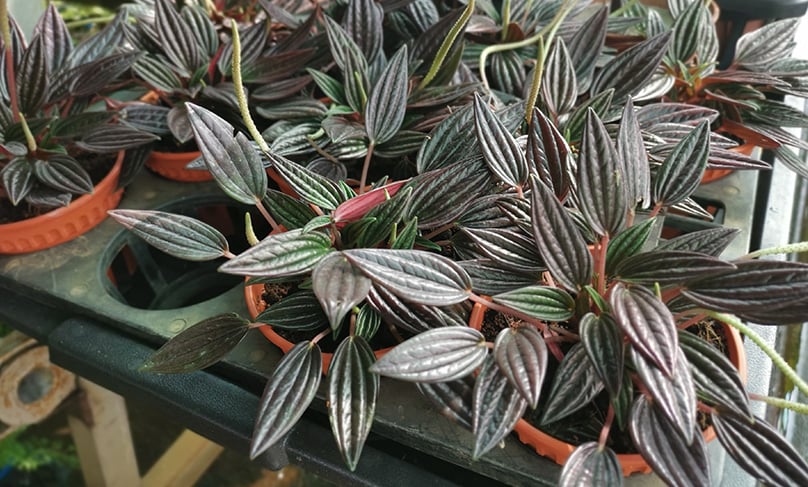
Being an indoor plant , the wandering Jew does not get much attention from pests. However, spider mites can be a problem for your plant if you don’t take care of it and watch for the presence of pests.
Spider mites are tiny spider-like bugs that form a web around the inside of the leaves of the plant. If left unmanaged and untreated, they might start to cause yellow spots in the foliage. The wandering Jew might also fail to flower in the summer months as well.
Over-watering your wandering Jew plant can result in the onset of diseases like root rot. Ensure that you have a well-draining soil mix before planting your wandering Jew. Provided that you do everything you can to ensure your soil drains well, you should never have a problem with root rot in your wandering Jew plant.
Wandering Jew Plants FAQS
What is the best way to grow a wandering jew plant.
The best way to grow a Wandering Jew plant involves placing it in a location that gets plenty of sunlight, preferably late afternoon sun. You should use well-draining, loamy soil to plant it, and ensure a balanced moisture level by watering it regularly but not excessively. The plant also appreciates humidity and occasional fertilizing with a liquid-based fertilizer diluted to 50% strength during the growing season. Pruning should be done regularly to manage its growth.
Is Wandering Jew easy to grow?
A: Yes, Wandering Jew plants are generally easy to grow. They adapt well to various conditions and are fast-growing. They can be propagated easily from cuttings and require minimal maintenance beyond regular watering, pruning, and an occasional application of fertilizer. However, they do not tolerate cold climates very well.
Does wandering Jew like full sun or shade?
Wandering Jew plants prefer locations with full sunlight. They can tolerate some shade but too much shade can cause the color of the leaves to fade. More sunlight exposure generally leads to more flowers during the flowering season.
How often do you water Wandering Jew?
Wandering Jew plants should be watered regularly to maintain a balanced moisture level in the soil. However, the soil should not be allowed to become too dry or too wet. Overwatering can lead to root rot. A good way to check if it’s time to water is to push your finger about 1-inch into the soil. If it feels dry, it’s time to water the plant.
Is Tradescantia Zebrina easy to grow?
Yes, Tradescantia Zebrina, a variety of Wandering Jew, is easy to grow. It requires similar care to other Wandering Jew varieties and is known for its adaptability and quick growth.
Does Tradescantia Zebrina need full sun?
Tradescantia Zebrina does best in a location with full sunlight. While it can tolerate some shade, insufficient sunlight can cause the leaves to lose their vibrant color. Like other Wandering Jew plants, the more light it gets, the more flowers it produces during its flowering season.

Hollie is a life-long gardener, having started helping her Dad work on their yard when she was just 5. Since then she has gone on to develop a passion for growing vegetables & fruit in her garden. She has an affinity with nature and loves to share her knowledge gained over a lifetime with readers online. Hollie has written for a number of publications and is now the resident garden blogger here at GardenBeast. Contact her at [email protected] or follow on twitter https://twitter.com/greenholliec
Pampas Grass Guide: How to Plant & Care for “Cortaderia Selloana”
Rhaphidophora tetrasperma guide: how to grow & care for “mini monstera”, corn plant guide: how to grow & care for “dracaena fragrans”.
under the photo “easy to propagate”, that is not a wandering jew-its a peperomia “rosso!”
My wandering jew plants leafs are getting dried. Why is that?
It’s not getting enough humidity
Could you elaborate on “rich organic compost”? What should it be made of, exactly? Can I use compost accelerator in the soil mix?
Worm castings are great, or worm tea, egg shell tea is another.
What month does the jew break ground to start growing?
All depends on your specific areas weather pattern and seasons.
Do NOT BUY ANY OF THIS SPECIES if you have a dog because dogs are very allergic to these plants & come out in bad rashes if they wander through them!
Leave A Reply Cancel Reply
Save my name, email, and website in this browser for the next time I comment.
Type above and press Enter to search. Press Esc to cancel.
How to Care for Wandering Jew for Massive Growth (7 Ideal Conditions)
Having the colorful wandering Jew at home is a sure and easy way to brighten up the room without needing to care for high-maintenance flowering plants. But for you to boost their growth and not just hang around with a couple of leaves a year, you need to take care of them properly!
Ideal growing conditions for wandering Jew plants are 1) 8-inch wide clay pots with drainage holes, 2) moist well-draining soil, 3) regular watering when the top 2 inches of soil is dry, 4) 6 hours of sunlight or 12 hours under 15W grow lights, 5) temperatures between 65–75°F, 6) humidity around 40–70%, and 7) a diluted 20-20-20 fertilizer applied 1–6 times yearly.
Although they are considerably low-maintenance houseplants, they can still die if they are not taken good care of. This is especially true for certain varieties that necessitate more specific growing conditions. So avoid wondering and worrying over why your spiderworts keep dying by familiarizing yourself with what they want and need for optimal growth!
It’s best to grow wandering Jews in clay or plastic pots that are relatively shallow but at least 8 inches wide. This allows them to grow thick and trail whether kept indoors or outdoors. The planter should have drainage holes.
You don’t really need any special type of planter to grow a lush wandering Jew plant . A regular pot will do so long as it is at least 8 inches wide. Otherwise, they will become very leggy !
As you may or may not know, the inch plant tends to trail on and off the soil it grows on. So it’s indeed normal for it to spill over pots, especially hanging baskets even when grown in optimal conditions.
However, this wandering plant still needs plenty of room in its growing container for it to anchor itself into the soil by forming roots along the nodes of its succulent stems and shoots.
Most wandering Jew or Tradescantia plants grow very thickly, reaching 2–3 feet in both length and width. Even the boat lily, Tradescantia spathacea , can grow 2 feet wide despite its upright growth.
Because of this, you’ll also need to go up by 1–2 inches once you need to repot your wandering Jew. If you don’t, you’ll be left with a scraggly spiderwort.
Now, you can also grow this trailing foliage plant in your yard if you want to add pops of color. However, be mindful when using this as a groundcover as it can grow quite wildly and become highly invasive.
Wandering Jew is considered a noxious weed not only in the southeastern region of America but also in Australia and New Zealand. So owners are strongly recommended to keep it controlled in a container even when placed in gardens.
Additionally, if you live in a drier area, opt for plastic pots as they help retain moisture in the soil. On the other hand, home gardeners living in more humid areas can grow their inch plants in clay pots to allow for good drainage and aeration.
Either way, make sure that your spiderwort has at least one drainage hole to prevent water from standing in the pot, which could result in root rot . You will also want a catch plate so the excess water won’t come spilling out of the planter.
Most wandering Jew varieties and cultivars can tolerate a wide range of soil conditions. They can grow in sandy, loamy, and clay soils that are acidic, neutral, or alkaline. Regardless, their soil is best kept moist yet well-draining.
The wandering Jew, unlike many other houseplants, is not picky when it comes to the soil it likes to grow on. It grows fast almost anywhere, from mountainous regions to coastal areas all around the Americas—starting from Canada, going all the way down to South America.
You can keep it in soils rich in sand, silt , clay , and even rocks . Due to its highly tolerant nature, it can grow and flourish in different regions and any corner of your house.
However, there is a difference between surviving in a corner of your house with little water and light and thriving producing lush purple and green leaves. Who doesn’t love to let their inch plant shine?
When grown as an indoor plant, however, you can use ordinary ready-to-use potting mixes for houseplant for your wandering Jew. I personally like this organic mix from Amazon.
Still, there are a few big no-nos if you want to keep a wandering Jew happy and healthy in the soil. First, it doesn’t tolerate soil well. Besides that, it doesn’t like constantly wet soil.
As such, make sure to check the soil condition of your inch plant from time to time. Otherwise, you may only notice that something’s wrong once it has already started wilting significantly.
Prevent your soil from becoming too wet by choosing mixes containing perlite and vermiculite. You can also add them to your regular soil mix. Alternatively, you can go soil-free to virtually eliminate all chances of getting and spreading soil-borne diseases.
Pro Tip: Many houseplants, including wandering Jew plants, do well with soil-less growing mediums composed of 60% sphagnum moss, 20% perlite, and another 20% vermiculite.
3. Watering
As it is a moderately drought-tolerant foliage plant, the wandering Jew plant must only be watered once the top 1–2 inches of its soil has dried out. If unsure, then it’s recommended not to water it.
Similar to how it is with soil, the wandering Jew isn’t fussy with water either. If you really want to get into it, you can use regular tap water, well water, distilled water, rainwater, and even melted snow.
Moreover, chlorine and fluorine in city water are generally harmless to plants. But if you want to be 100% certain, check with your local provider.
All it asks for is evenly moist soil that will let its roots grow well and strong. You can do so by using a slender-spouted watering can like this copper one from Amazon. This will help you avoid getting the foliage excessively wet.
Having said that, it’s important to never let spiderworts in either condition wilt. On the other hand, it should never be left to stand in water—which is why it’s best to go for relatively shallow pots over deep ones.
You will have to adjust your watering frequency based on several factors such as:
- Wandering Jew size
- Container size and material
- Type and amount of light received
- Average local temperature
- Overall humidity
For instance, inch plants grown with sandy soils and hotter temperatures require more frequent watering. Conversely, ones in clay soils and cooler temperatures need less water.
Outdoors, wandering Jew grows best with about 6 hours of direct or partial sunlight each day but it can survive with 4 hours a day if only for winter months. When grown indoors, it can be placed near east or west-facing windows or under LED grow lights that are at least 15–30W.
The vibrant purple, green, and yellow hues of your wandering Jew can be improved and maintained with proper lighting.

Generally, these beautiful colors become more intense as it gets more direct sunlight exposure. At the same time, however, harsh sunlight—as is normal in southern states like Florida—can also cause the wonderful colors of the inch plant to fade.
In other words, you want to strike the perfect balance between the two, especially with wandering Jew plants kept outdoors. But don’t worry, I won’t leave the guesswork to you!
Give your wandering Jew plants about 2–6 hours of full or partial sun exposure before moving them to shadier areas in your garden, balcony, or patio.
Providing wandering Jew plants with some shade prevents them from growing too aggressively and becoming invasive. Even indoors, artificial shading can make it more manageable!
For potted wandering Jews kept indoors, however, a good full-spectrum LED grow light with a power rating between 15 to 30 Watts will be necessary for good growth. Just place the grow light about 1–2ft above the top-most part of the plant and adjust the height as it grows.
To ensure that the light stays on for 12–14 hours, you can use an electric timer. Remember to also regularly rotate the pot so that it won’t become leggy or lopsided.
5. Temperature
The wandering Jew plant thrives with moderate cool to warm temperatures, around 65–75°F. It tends to become very weedy in sustained warm temperatures.
Many newbie home gardeners may find it surprising that spiderwort grows quite well with cool temperatures of 65°F or 18°C as it is widely known to be native to Mexico a hot country. In reality, however, you can also find native species from southern Canada to the United States.
As such, it can live and grow even in relatively cool regions. But in such cases, they are best kept indoors where their growing environment can be better monitored and kept regulated.
Simply put, you wouldn’t need to worry much about your wandering Jew dying from extreme cold if you have a working thermostat along with reliable space heaters.
You see, a wide variety of inch plants can be grown in USDA plant hardiness zones 4–12. Certain species though are less hardy. For instance, T. fluminensis thrives in zones 9–12, T. ohiensis in 4–9, and T. pallida in 7–11.
On the other hand, it can also handle heat quite well. Although it’s ideal to keep the temperature around it at 75°F or 23°C, the wandering Jew can tolerate even higher temps.
Despite its seemingly restricted temperature tolerance , wandering Jew can be grown from Alaska all the way down to Hawaii. Just remember that it can become invasive in hotter areas.
To put things into an even more broad perspective, its tolerance to not only varying temperatures. Wandering Jews can also withstand different growing conditions. All of these combined have allowed it to become naturalized in virtually all parts of the globe.
6. Humidity
Keep moderate to high humidity levels of 40–70% to promote growth in wandering Jew plants. Doing so can help prevent pest problems.
Considering that I just told you they do well in cool climates may confuse you with what I’ll be saying now if it’s new information for you. Sure, cool temperatures normally equate to dry air while warm temperatures correspond with humid air.
But it’s important to keep in mind that these factors naturally fluctuate through seasons and even a single day.
Plus, taking into account that most people grow spiderwort as potted indoor plants , the relation between temperature and humidity isn’t always as linear.
Having said all that, inch plants thrive with high humidity of up to about 70%. This is in line with the fact that they do well in humid climate zones.
Once you notice the tips of your wandering Jew leaves are turning brown, it’s a sign that it isn’t getting enough humility. So turn it up using a room humidifier because regular misting could do more harm than good for this foliage plant. You could also put it in the bathroom!

By increasing the humidity to at least 40%, you can prevent pests such as spider mites from feasting on and killing your otherwise lush and thriving inch plant. Alongside boosting humidity, make sure to also provide sufficient ventilation for your plants.
7. Fertilizer
Wandering Jaw plants do not require fertilizer to survive for many years. However, the application of one can dramatically boost growth. Apply a 20-20-20 liquid fertilizer for wandering Jew once every 2 months to once a year in the summer months. Dilute 1 1/2 teaspoons of fertilizer will 1 gallon of water.
One thing I want you to keep in mind as we end this article is that the wandering Jew plant isn’t a heavy feeder it only needs 1–6 yearly applications of complete fertilizers like the one below from Amazon. It’s mostly content with optimal lighting, temperature, and humidity.
More importantly, overfertilizing your inch plant could lead to very serious consequences—which does include plant death. The thing is, the wandering Jew has a very low tolerance for salt in its growing medium. So you should also water it before fertilizing.
Oftentimes, the accumulation of salt in the soil is a result of too much fertilizer and frequent bottom-watering which can lead to:
- Stunted development
- Discolored leaf tips
- Leaf dropping
- Damaged roots
So although I gave you a general rule to go by above, I still strongly advise you to double-check the instructions for the fertilizer you’ll be using to be absolutely certain.
When your wandering Jew plants start becoming unruly as a result of regular feeding, get your pruning shears and cut away excess stems. But don’t throw them out.
Instead, propagate them for even more plants which you can give out to fellow plant lovers—heck, send them this care guide too!
I have a few wandering Jews myself and I honestly never fertilized them. They are doing fine (not thriving by any means) but such a plant is not demanding. So, no worries if you can’t fertilize it. It will still survive as long as its lighting and watering are right!
How long can wandering Jew plants live?
In warm regions, with climates similar to their native habitats, the wandering Jew is an evergreen perennial plant—meaning it can live on and continue growing for several years or indefinitely. However, when grown and kept in much colder and drier areas, the spiderwort lives as an annual plant dying after just one growing season.
What are the common pests of wandering Jew plants?
Common pests of wandering Jew plants include aphids, caterpillars, deer, mealybugs, rabbits, scales, slugs, snails, spider mites, and vine weevils. They can seriously damage spiderwort shoots, especially young ones. However, some species are more resistant to pest damage than others. For example, purple spiderwort, T. pallida, is resistant to deer.
Is spiderwort poisonous?
Spiderwort, also known as wandering Jew or inch plant, can be poisonous to humans, cats, dogs, and horses. It will mostly only cause contact dermatitis possibility due to oxalate crystals in its leaves. However, the Tradescantia spathacea, in particular, can be moderately toxic when it is eaten in large amounts, causing severe stomach pains.
Summary of How to Care for Wandering Jew
The wandering Jew is a fast-growing low-maintenance plant that can survive a wide variety of growing conditions. However, it grows best in even moist well-draining soils container in shallow but at least 8-inch wide clay or plastic pots. It must be watered once the top 2 inches of the growing medium has become dry.
If grown outdoors, the wandering Jew thrives with 6 hours of direct or partial sunlight. Conversely, it needs 12 hours of artificial light indoors from 15–30W LED grow lamps.
Wandering Jew plants grow well with moderate temperatures at 65–75°F or 18–23°C and considerably high humidity of 40–70%. For feeding, it only needs occasional application—as seldom as once per year—of a diluted water-soluble complete fertilizer after it is watered.
- “Tradescantia” by n/a in N.C. Cooperative Extension
- “Tradescantia” by Leonard Perry in Perry’s Perennial Pages
- “Zebrina pendula wandering jew” by Edward F. Gilman in University of Florida IFAS Extension
- “Caring for Houseplants” by n/a in University of Missouri Extension
- “Indoor plants – Cleaning, fertilizing, containers & light requirements” by Debbie Shaughnessy and Al Pertuit in Clemson University Cooperative Extension
Similar Posts
Why does my christmas tree have drooping branches [4 reasons and solutions].
Only 1 out of 4 trees is handpicked and chopped fresh for Christmas each year [1]. This means that 75% of real Christmas trees in the US are bought from retailers who sell pre-cut trees, with the trees losing their freshness after all the time spent in shipping and distribution. As a result, you may…
Why Is Your Snake Plant Turning Yellow? (Revive it!)
Snake plants have served as beloved houseplants for about a hundred years. But it was in the 1920s that they started gaining popularity. Although they’re ridiculously low-maintenance, it’s pretty common to see them turn yellow sometimes. This is the guide you need to find out what exactly went wrong and how you can fix it!…
6 Causes of Brown Calathea Louisae Leaves
Calathea louisae, known for its air-purifying ability and decorative leaves, stands out as one of the most in-demand house plants anyone would climb mountains to search for. But, would it still be pleasing to the eye when some of its leaves start turning brown? Absolutely not! In general, Calathea louisae leaves turn brown due to…
175 Plants Toxic for Cats – Full List (Avoid Them at Home)
Have you ever caught your cat chomping on your plants? It may look cute but there is a possibility that your kitty may experience poisoning from eating or touching plants. The real dilemma comes from knowing which plants are toxic for cats. More than 100 plants are known to be toxic to cats. The most…
7 Causes of Brown Calathea Musaica Leaves to Watch Out for!
Leaf browning in Calathea musaica, also known as the network plant, could quickly destroy your perfectly designed indoor garden’s ambiance. With its defined mosaic-like pattern, any signs of browning or wilting are just simply unacceptable. So knowing the causes behind this is key to maintaining a beautiful garden! In general, Calathea musaica leaves turn brown…
Is My Christmas Tree Bad For The Environment?
It’s almost that jolly time of the year again for families to decorate a Christmas tree together and exchange gifts under that tree. Being the centerpiece of an annual tradition which is observed in 94 million households in the USA alone [1], the Christmas tree presents an environmental choice for each family: artificial or fake….

Wandering Jew (Tradescantia zebrina): Plant Care and Growing Guide – House Plants Expert

Table of Contents
The Wandering Jew plant is the common name given to a number of plants from the Tradescantia genus, including the scientific name Tradescantia Fluminensis, Tradescantia Pallida, and the most popular one – Tradescanita Zabrina.
The common name of “The Wandering Jew” is believed to come from a legend that the wandering jew ‘taunted Jesus’ en route to being crucified and was cursed to walk the Earth until the second coming. This can be viewed as antisemitic to some so be sensitive to that. We love our plants and certainly do not mean to offend when using their common name. Many have started now to use the common name wandering dudes or dude plant.
Some countries classify this species as an invasive plant or even a weed. This is because of its growth habit (it grows fast and prevents the growth of other plants). However, grown indoors it makes an attractive hanging basket or windowsill plant.
The purple wandering jew or purple heart is one of my favorite plants. The foliage is fleshy, has violet leaf colors, easy to care for, has simple propagation, and is just an overall nice houseplant to have in your collection.
Description
There are a number of tradescantia plants very similar in looks, how they’re grown and their growth habit, including the T. zebrina (which has dark green leaves with silver bands), the Tradescantia Fluminensis variegata with cream stripes, and quicksilver which has white stripes. Then there’s the T. Pallida from the same genus which is sometimes named Wandering Jew plant but looks very different from the Tradescantia Fluminensis and Zebrina.
Foliage
Fleshy oval or lance-shaped leaves are produced from the pendant stems (growing a couple of feet or so long). These small leaves have a shiny appearance and grow to about 2 – 4 inches long with pointed tips. The underside of a leaf is purple in color on the zebrina and new leaves appear purple at first, then turn green. In the wild or grown in gardens (grown as a bedding plant) stems take root at the nodes, but indoors in a hanging basket or container they grow and hang over the sides.
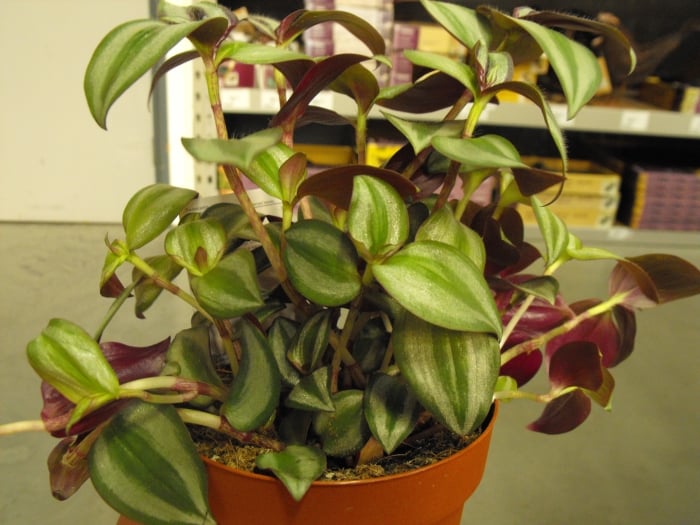
Flowering
The small non-showy flowers are white in color, appearing during summer usually and at other times (depending on the conditions). These flowers appear in clusters and display three small petals.
Plant Care and Growing
Wandering jew plants are pretty simple to care for and maintain, although providing plenty of bright light is important. Tradescantia naturally becomes spindly and needs to be pruned regularly and pinching stems will encourage fuller growth, improving its appearance.
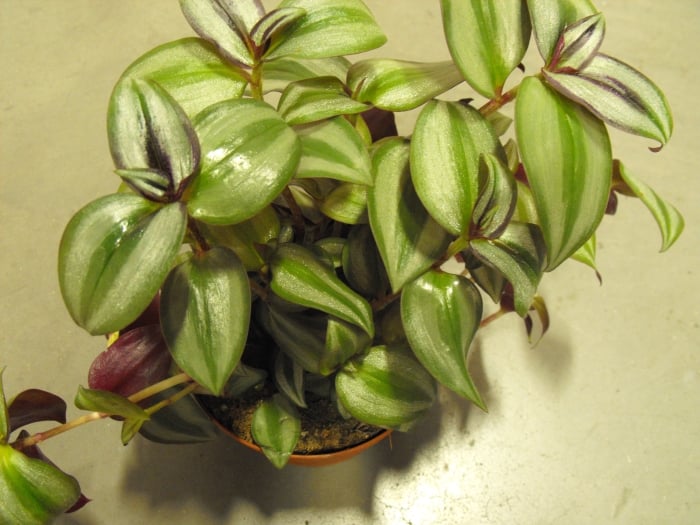
Potential Problems
- Spindly growth and bare stems: This happens naturally with age for this plant but lack of light, water, or plant food can also cause spindly growth. If the plant is old and conditions are fine (water, light, etc.) then it could be time to replace it.
- All green leaves: Variegated leaves turning green and losing their variegation is most likely due to too much light.
- Limp stems: Limp stems are usually a sign that the plant is lacking water
Take a 3 to 5-inch softwood cutting and place it in a moist potting mixture or water. Wait three weeks and enjoy.
Yes, the wandering jew can live in water indefinitely given nutrients and frequent water changes.
Yes, it is toxic but not fatal to cats, dogs, and horses. The leaves contain calcium oxalate crystals which is the toxic component.
The answer is it can be planted inside or out and is even considered a noxious weed in some areas as it grows so well.
Water often to keep the soil moist but not soaked.
Was this helpful?

Elyssa Goins is an experienced house plant hobbyist who maintains over a hundred plants. She is a gardener, beekeeper, and a proud mother of four. She is a member of the American Horticultural Society, has a published study in the National Social Science Association , and loves to talk about her love of plants. For the past twenty years, she’s been all about growing and caring for various fruits, veggies, herbs, livestock, kids, and houseplants. Managing a big garden to feed four growing kids and raising dairy goats has taught her so much about being an excellent plant parent and now is her time to share with you.
Dumb Cane Plant (Dieffenbachia): Plant Care and Growing Guide – House Plants Expert
Monstera albo (monstera deliciosa): plant care and growing guide – house plants expert.
This site uses Akismet to reduce spam. Learn how your comment data is processed .
Hi Mary, I hope you are able settle an argument between my brother & I He claims that golden canes are a grass spieces & not a tree!! Thank you in anticipation James

Oh boy, this feels like a setup. Golden Canes are a monocots which is in the same primary class as grass. What is the definition of a tree? If your hammock is tied to a tree on a tropical island would you call it grass? The technical and practical definitions are not the same for this age old debate.
- Privacy Policy
Copyright © 2013-2024 · Houseplantsexpert.com Houseplantsexpert.com is a participant in the Amazon Services LLC Associates Program, an affiliate advertising program designed to provide a means for sites to earn advertising fees by advertising and linking to Amazon.com.*Amazon and the Amazon logo are trademarks of Amazon.com, Inc., or its affiliates. Additionally, Houseplantsexpert.com participates in various other affiliate programs, and we sometimes get a commission through purchases made through our links.

Wandering Jew Plant (Tradescantia zebrina): Types, How to Grow and Care
Sharing is caring!
Plants with trailing and creeping habits are some of the best plants to keep. They are fast-growing and make thick carpet of groundcovers for gardens in no time and they also create striking hanging indoor plants.
Among the all-time best trailers to grow is the wandering jew. Easy to maintain and drapes beautifully, this colored plant will make any space more inviting and interesting.
Medicinal Properties
Propagation and maintenance, what is a wandering jew plant.
Tradescantia is one of the 37 genera under the plant family Commelinaceae (1). Some of its 75 species are commonly called ‘wandering jew’ (also known as inch plant), a name they adapted due to their long lifespan like the Jewish character from a Christian folklore.
Another name for this group of herbaceous perennial plants is ‘spiderwort’ after the spiderweb-like sap they produce when the stem breaks. They are native to Canada, Mexico, and Argentina and have been naturalized in other parts of the world (2).
The most common tradescantia grown ornamentally is the T. zebrina also previously called Zebrina pendula . It has long fleshy stems where the wandering jew plant leaves and roots appear. The lance-like leaves are a mixture of green and purple with silver stripes on the upper side and deep purple under (3). The plant grows close to the ground and can only reach 20 to 30 cm high.
Does Tradescantia Zebrina Flower?
The wandering jew is considered an ornamental plant primarily because of its showy colorful foliage but the plant does produce pink flowers.
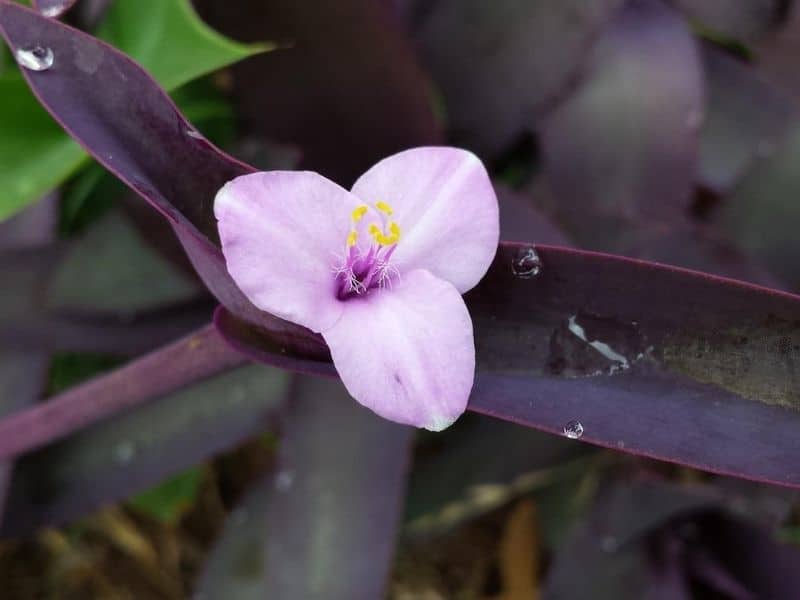
Small three-petaled pinkish purple flowers appear sporadically throughout the year (4). The resulting fruit is a capsule containing tiny brown seeds.
Is it Toxic to Pets?
Spiderworts are normally harmless plants but they contain toxic properties that may cause mild gastric problems and dermatitis to pets. Although they don’t lead to anything serious, it will be safe to keep the plants out of reach of pets and to keep the hands protected when dealing with the sap of the plant.
Because of the plant’s hardiness and adaptability to different environments, the wandering jew establishes well, in fact so well that it can be considered an invasive species. In countries like Australia, the plant has the capacity to invade natural vegetation. Although growing them is not prohibited, everyone is obliged to keep the plant’s growth under control (5).
Studies showed that Tradescantia has significant effects as an anticancer, antioxidant, and antibacterial medicinal plant. In traditional Chinese medicine, the wandering jew plant is highly valued as treatment for kidney failure.
The extract from the whole plant is cooked with dates, ginger, and water and consumed by patients. The plant is also known to treat high blood pressure, cough, urinary tract infection and tuberculosis (1).
How to Grow and Care for a Tradescantia
Here’s how to care for a wandering jew plant, one of the easy house plants to own.
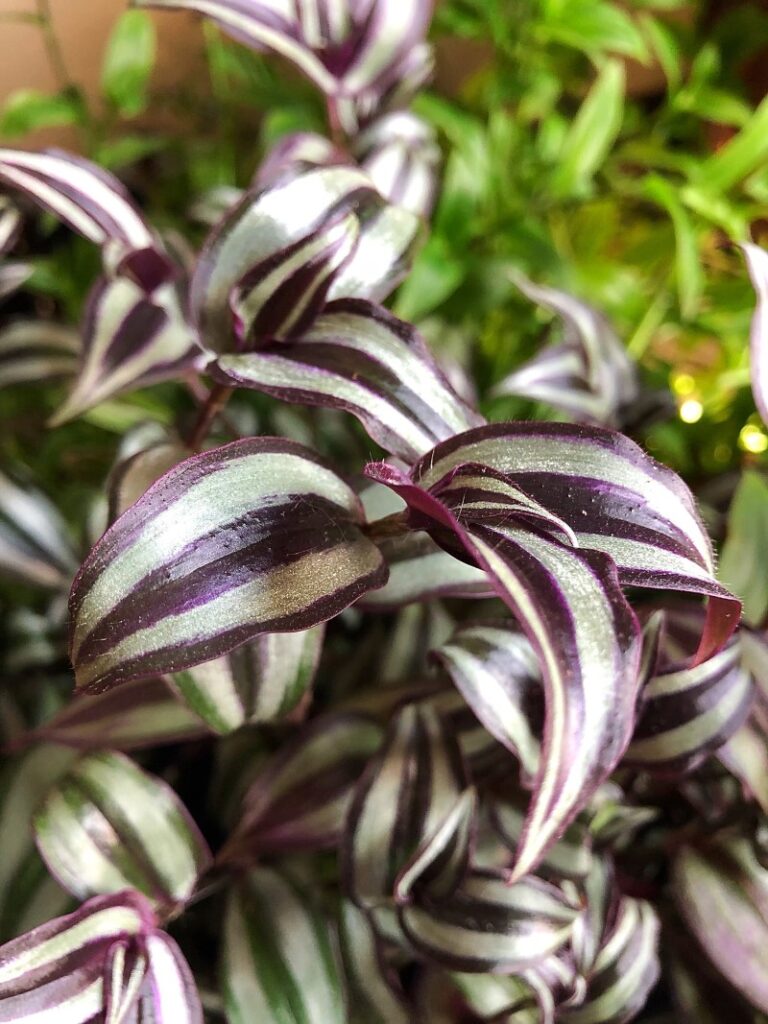

Light and Water
In the wild, the wandering jew plant thrives without assistance but under the right conditions. It likes filtered sun so indoor fluorescent light is enough. Placing them by the window and turning the plant every two weeks will keep the leaves colorful and the growth even on all sides (3).
The plant spreads easily in damp areas that’s why it naturally grows along riverbanks and roadsides. When potted, the soil should be kept moist but well-drained. Saturated soil often causes root rot.
Fertilize your Tradescantia plant once a month during the growing season (spring and summer) with a balanced, water-soluble fertilizer diluted to half strength. Avoid fertilizing in fall and winter when the plant is dormant. Over-fertilizing can lead to fertilizer burn and damage the plant, so follow the instructions on the fertilizer package carefully.
Temperature and Humidity
Spiderworts like it warm but there should be enough air circulation or else the leaves will sag. During the heat of the summer, taking the plant outside under shade will provide the necessary cool to the plant.
Mist the hanging plant early in the morning and late in the afternoon. If the plant is on a table, place a glass of water beneath the leaves or put the pot on a wet pebble tray. This will humidify the immediate vicinity of the plant aiding in its photosynthesis and transpiration processes.
Pests and Diseases
The most common living enemies of the wandering jew are aphids, mealybugs, scale, white flies, and spider mites. Manual removal at the onset of infestation is effective but they should be closely monitored as serious attack may lead to the plant’s death. If left unnoticed and the infestation has become severe, get rid of the plant by burning to avoid contamination.
Since the creeping inch plant is mainly soft almost like a succulent, soggy soil and too wet conditions lead to root and stem rot (4). As long as the plant is receiving just enough moisture, this disease will be avoided.
Propagating wandering jew plants is very easy. They can grow from seeds but will take years to establish so the more convenient stem cutting is best. The trailing or creeping stems form nodules where the roots will eventually grow as it comes in contact with the potting soil (2). When the hanging plant has longer trails than intended, it can be trimmed and the resulting stem cuttings can be rooted to form new plants.
There will be times that the potted wandering jew will become leggy, especially if it’s been receiving more shade. To promote a bushier growth pinch back by literally pinching the tip of the plant where the new growth occurs (4). This practice allows the formation of lateral stems.
In two or three years, these hardy plants may become pot bound, with the roots taking up most of the space in the pot. Repot in a larger container with a good mixture of soil, coarse sand, and compost to replenish the nutrients and provide room for the roots to breathe. Additionally, fertilize once every two months by foliar application just to improve plant vigor.
Common Varieties of Wandering Jew
The oldest and most common indoor wandering jew, this species has leaves alternating, often overlapping when young, purple leaves with silvery green thick stripes and solid purple underside. The stem is also a mixture of purple and green.
T. blossfeldiana
The leaves of this species are quite thicker, glossy, and covered in miniscule hairs called trichomes. The three-petalled flower is an ombre of white and pinkish purple with yellow anthers.
T. fluminensis ‘Tricolor’
This attractive variety showcases leaves with white, lilac, and green variegation. It appears smaller than the common wandering jew but bushier in form.
T. sillamontana
This whimsical species looks frosted with its silvery trichomes covering the entire plant. The green leaves are still alternately arranged but more compact which make a potted plant look more bushy than trailing. The light color of the leaves provide a complementing backdrop to the bright purple flowers.
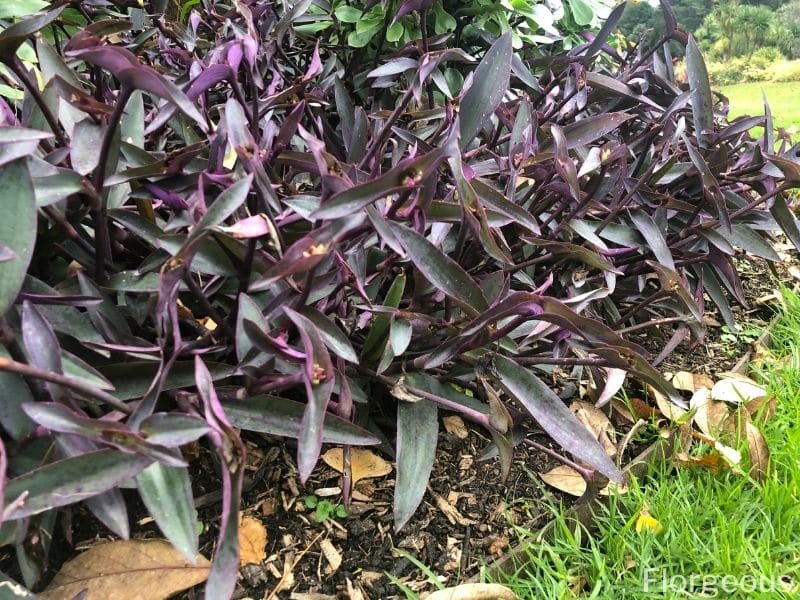
The leaves and stems of this species are in striking deep purple color hence the common name ‘ purple heart ’. Under shaded, they turn a hint of dull green. The leaves are also longer and have wider space in between.
Does Wandering Jew plant need full sun?
Wandering Jew plants (Tradescantia zebrina) prefer bright indirect light but can tolerate some direct sun, especially in the morning or late afternoon. However, prolonged exposure to intense sunlight may cause their dark green leaves to scorch.
How do you care for a wandering Jew plant indoors?
To care for a Wandering Jew plant indoors, place it in a location with bright, indirect sunlight, such as near a window. Water it when the top inch of soil feels dry, typically every 1-2 weeks, and provide well-draining soil. Additionally, mist the plant occasionally to increase humidity and remove dust from the leaves.
How do I make my Wandering Jew fuller?
To make your Wandering Jew plant fuller, prune it regularly to encourage branching and bushier growth. Pinch off the tips of the stems or trim back leggy growth to promote new growth and create a more compact appearance. You can also propagate wandering jew cuttings to create new plants and fill out the pot.
How long do Wandering Jew plants live?
Wandering Jew plants are generally long-lived when provided with proper care. With the right growing conditions indoors, they can thrive for several years, often becoming fuller and more lush over time with regular pruning and maintenance.
Reference List
(1) Dash, G., et. al. Tradescantia zebrina: A Promising Medicinal Plant. 2017. IAJPS, 4 (10). P. 3498-3502 .
(2) Arakelyan, H. Tradescantia zebrina- Mother Nature Healing. 2019. Researchgate.
(3) Vermeulen, N. Encyclopedia of House Plants. Taylor and Francis. 1999. P. 320.
(4) North Carolina State Extension. Tradescantia zebrina. NC State University. 2018. https://plants.ces.ncsu.edu/plants/tradescantia-zebrina/ . Accessed on 12 August 2020.
(5) The State of Queensland. IPA-Zebrina. Department of Agriculture and Fisheries. 2020. https://www.daf.qld.gov.au/__data/assets/pdf_file/0020/51284/IPA-Zebrina-PP102.pdf . Accesed on 12 August 2020.
Photo by Wirestock/depositphotos
Have you seen these?

Overwatered Lantana: Identifying, Fixing, and Preventing Water Damage

Overwatered Petunias: Signs, Damages, and Recovery Steps

Overwatered Pumpkin Plant: A Comprehensive Guide to Rescue and Prevention

Overwatered ZZ Plant: Rescue, Recovery and Prevention Strategies

Overwatered Dogwood Tree: Causes, Symptoms, and Revival Techniques

Overwatered Lavender: A Comprehensive Guide to Prevention and Recovery
About the author.
Wandering Jew Plant

A Perfect Choice for First-Time Plant Owners
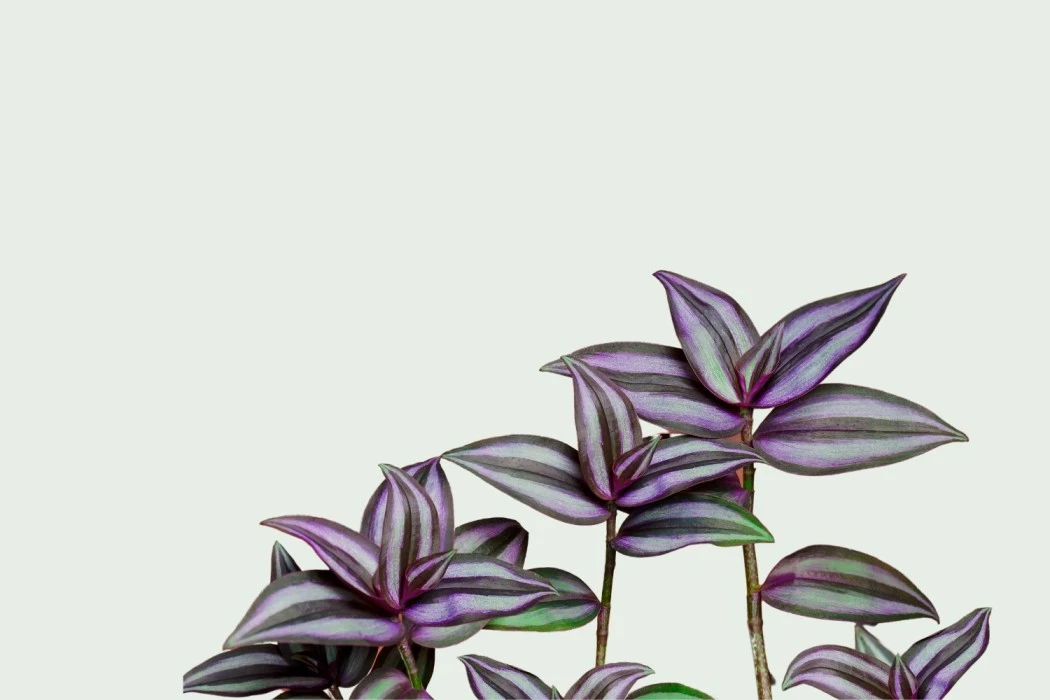
Get to know us
Growing problems in wandering jew plants.
Yellowing leaves may result from excessive sunlight. Relocate your inch plant to a spot with bright, indirect light or propagate a cutting for a new planting. Prolonged soil moisture can stress the plant, fostering rot. Adjust watering accordingly.
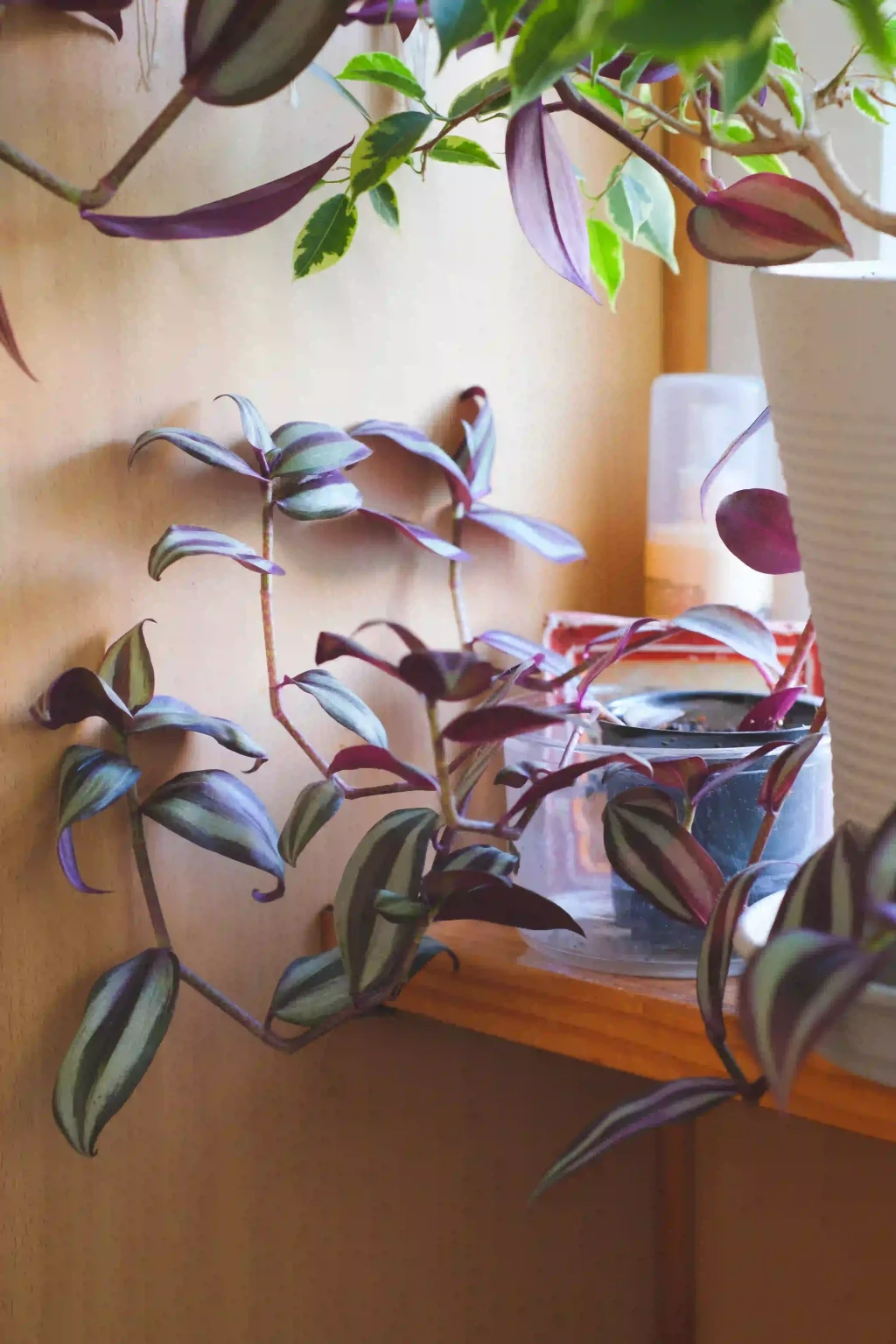
Dealing with Pests in Wandering Jew Plants
Spider mites are the primary pests for wandering jew plants. They thrive in warm, dry environments, so maintaining high humidity or misting your wandering jew plant is an effective countermeasure.
If these methods prove ineffective, try rinsing the plant with water to dislodge the mites. For more severe infestations, consider removing affected areas and employing a systemic insecticide.
Aphids also extract sap from the leaves of wandering jew plants. When cultivating these plants indoors, transport them outside for treatment with neem oil or a forceful water stream. Ensure follow-up applications every 7 to 10 days if aphids persist.
Addressing Common Issues in Wandering Jew Plant
- Overwatering
- Soil retaining excessive water
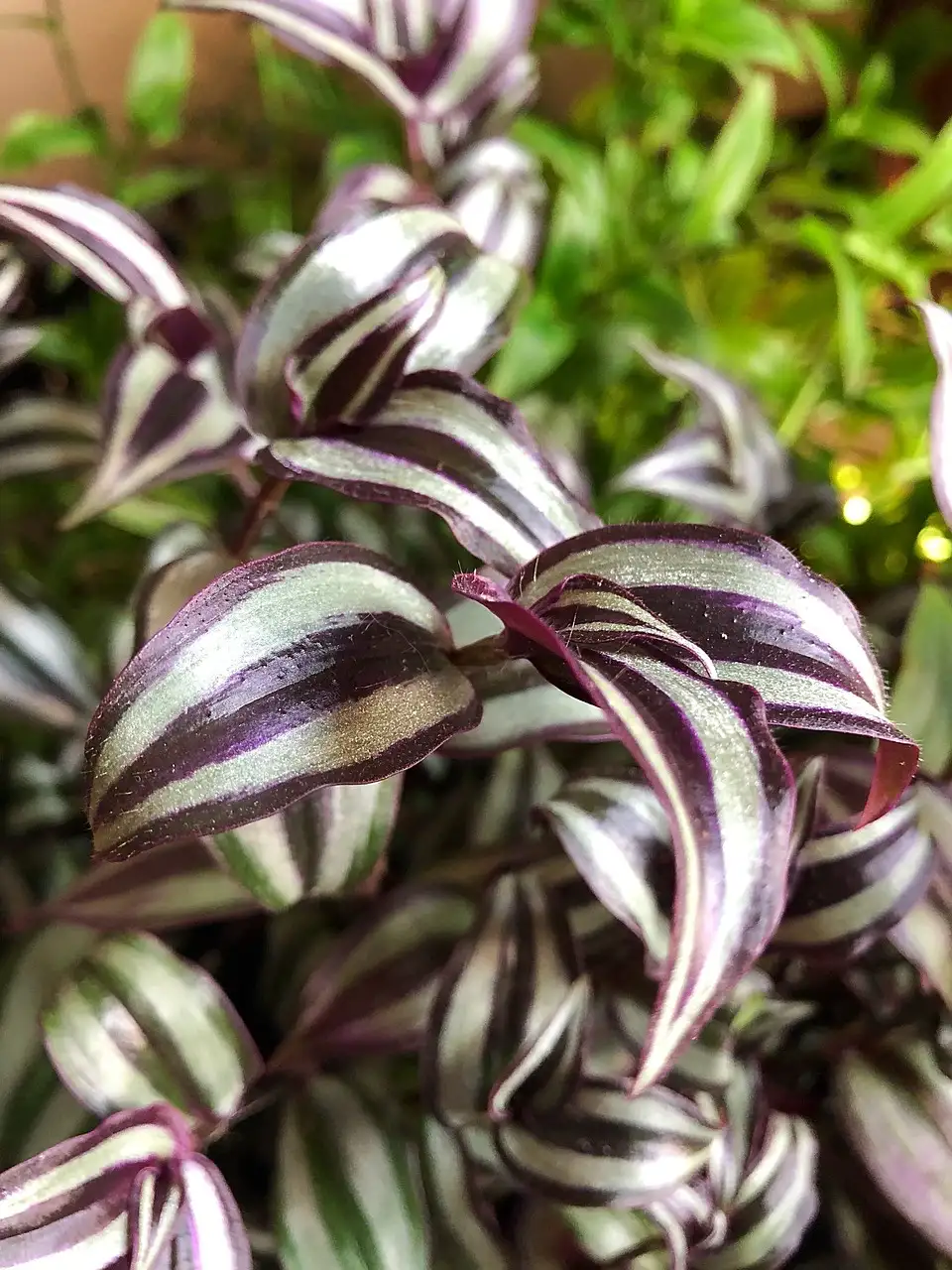
Wandering Jew Plant Care (Indoor & Outdoor)
Wandering jews display particular sensitivity to receiving the correct light dosage. They require ample light for maintaining their vibrant color, but exposing their leaves to direct sunlight can result in burns (except for the purple queen variety, which thrives in full sun).
The optimal position for cultivating them indoors is a window facing east or west. This way, they receive abundant natural light during the morning/evening and bright, indirect sunlight for the remainder of the day.
Insufficient light exposure leads to a fading and dull appearance of their leaves. Thus, if a location with abundant natural sunlight is unavailable, incorporating a grow light is advisable.
However, if the decision is made to transfer the inch plant outdoors for the summer, it is crucial to place it in a shaded or partially shaded area, sheltered from the intense afternoon sun.
The wandering jew plant prefers its potting mixture to remain consistently moist but not excessively saturated. In situations with indirect light, hydrate your wandering jew plant once a week or when the upper layer of soil becomes arid. Ensure that the soil never reaches complete dryness.
Nevertheless, when irrigating your desiccated potting mixture, administer water in intervals to guarantee thorough absorption by the soil, preventing it from simply flowing out of the planter. Apply a small amount of water, pause for a while to allow the soil to soak it up, and then proceed with watering until it drains from the planter’s bottom drainage hole.
The soil for your wandering jew is suitable for a conventional houseplant potting blend, yet they will thrive even more in soil enriched with additional organic material.
Enrich your potting mixture by incorporating some organic compost, perlite, and peat moss. Strive for the optimal equilibrium between retaining water and facilitating drainage. Water the plant and observe the soil’s tendency, then make adjustments accordingly. The preferred soil pH falls within the range of 5 to 6.
Another crucial aspect of effective wandering jew plant care is humidity, and a substantial amount is required. When the humidity drops too low, the leaves will begin to brown and wither.
This becomes particularly challenging when cultivating them indoors in the winter season, as the air inside our homes tends to be excessively dry. Therefore, maintaining high humidity levels is of utmost importance.
A convenient method to elevate humidity is by operating a nearby humidifier. Additionally, it is advisable to place an indoor humidity monitor close to your inch plant.
You may also place the pot on a pebble tray filled with water (avoiding soaking) or opt for growing it in a small plant cloche or a miniature indoor greenhouse.
Temperature and Humidity
Your inch plant thrives most in a temperature range of 60 degrees Fahrenheit to 80 degrees Fahrenheit. Exposure to frost can be fatal to the plant. However, in USDA hardiness zones 9 through 11, the plant might endure light frosts. In these regions, if the leaves wither, there’s a chance the plant will revive in the spring.
When the external temperature consistently drops below 60 degrees Fahrenheit, container-grown plants should be relocated indoors. While intense heat can scorch the leaves, the plant can endure high temperatures much better than it can tolerate cold.
An optimal relative humidity of 70% is recommended for Tradescantia plants. Indoors, achieving the right humidity level can be accomplished by utilizing a plant humidifier or misting the plants daily with filtered or distilled water.
The Inch plant generally doesn’t necessitate specific pruning. Pruning becomes relevant for the creeping inch plant in two scenarios: firstly, to eliminate withered foliage, and secondly, to govern the plant’s shape and growth pattern. If left unattended, the spiderwort plant tends to become leggy; to maintain a fuller appearance, periodically prune the stems or pinch back at least one-fourth of the branch length.
Utilize sharp and clean pruning shears or scissors to trim stems to the desired length, cutting at an angle between leaf nodes. To eliminate dead or yellowing leaves, simply pinch them away, ensuring the leaf stalk is also detached from the main stem.
Fertilizing
Spiderwort plants typically don’t require regular fertilization as part of their routine care. However, they can certainly benefit from occasional nourishment.
Feeding is only necessary during spring through summer; refrain from fertilizing in the fall or winter. Winter growth tends to be weak and leggy, and encouraging that is not desirable.
You can nourish your plant monthly with a liquid fertilizer diluted to half strength. I suggest opting for organic plant food over synthetic alternatives, as wandering dudes can be sensitive to chemical fertilizers.
A quality organic general-purpose fertilizer or compost tea would be excellent choices. If you prefer, you can also incorporate slow-release organic granules into the soil.
Fish emulsion and liquid kelp are also effective options, but it’s advisable to use them outdoors as they can emit a strong odor when used indoors.

Wandering Jew Plant Benefits
Tradescantia Zebrina isn’t merely aesthetically pleasing; it functions as an inherent air purifier. Positioned in your living area, it diligently eliminates undesirable substances such as formaldehyde and xylene. There are numerous advantages to Wandering Jew plants that render cultivating the plant somewhat worthwhile. Let’s Take a look at the primary benefits of Wandering Jew plants.
Aesthetic allure
Owing to their splendid visual appeal, Wandering Jew plants are predominantly retained in households and gardens as embellishments. They are ideal for suspended baskets or containers. Their beautiful deep purple, emerald green, and silver streaks impart a distinctive taste to every room in your residence!
Upon reaching maturity, Wandering Jew plants also commence flowering. They showcase stunning blossoms.
Purify Air
Inch plant (Wandering Jew), also recognized as Tradescantia zebrina, has gained popularity due to its captivating, exotic foliage. Its appealing oval-shaped leaves can appear in silvery, purple, and green hues. This resilient and easily-managed plant also boasts numerous small purple, white, and pink flowers that develop along the length of slender stems, reaching a height of up to three feet.
Not only are Inch plants visually pleasing, but they also contribute to indoor air purification. Emitting oxygen, they absorb pollutants and diminish allergenic dust mites in indoor environments; this makes them an optimal choice for enhancing indoor air quality. As per alive, this indoor plant reduces benzene, TCE, toluene, and terpenes.
A pleasant present
Houseplants might not be the initial consideration when pondering gifts, but they serve as the flawless means to bring a smile to someone’s face on any occasion.
The perfect gift for every special event, whether commemorating a holiday, advancement, engagement, or property ownership, could be a houseplant gift.
Opting for a Wandering Jew plant is among the finest choices for gifts. They are available in vibrant varieties, are uncomplicated to cultivate, and have a reasonably compact size.
Medicinal uses
To take advantage of the healing abilities of the Wandering Jew plant, the leaves and stems are mainly used which are processed in different ways such as decoctions and teas. Being an antioxidants-rich plant, it aids in general health by deactivating the free radicals and also fighting inflammation. Its properties as an an anti-inflammatory and also antimicrobial agent make it a natural treatment for the conditions such as nephritis and also urinary tract infections.
Furthermore, the infusion of the plant is widely used in Malaysia to enhance the kidney performance and also preserve the health of the urinary system. Research suggests a possible anti-arrhythmic effect, which is very good for the cardiovascular system, but further studies are definitely required to understand and develop this benefit.
Reducing Stress
Based on research, incorporating plants into your residence or workplace can contribute to a sense of ease, tranquility, and connection with nature. Consequently, placing Wandering Jew plants throughout your dwelling could aid in reducing tension and stress, enhancing your efficiency.
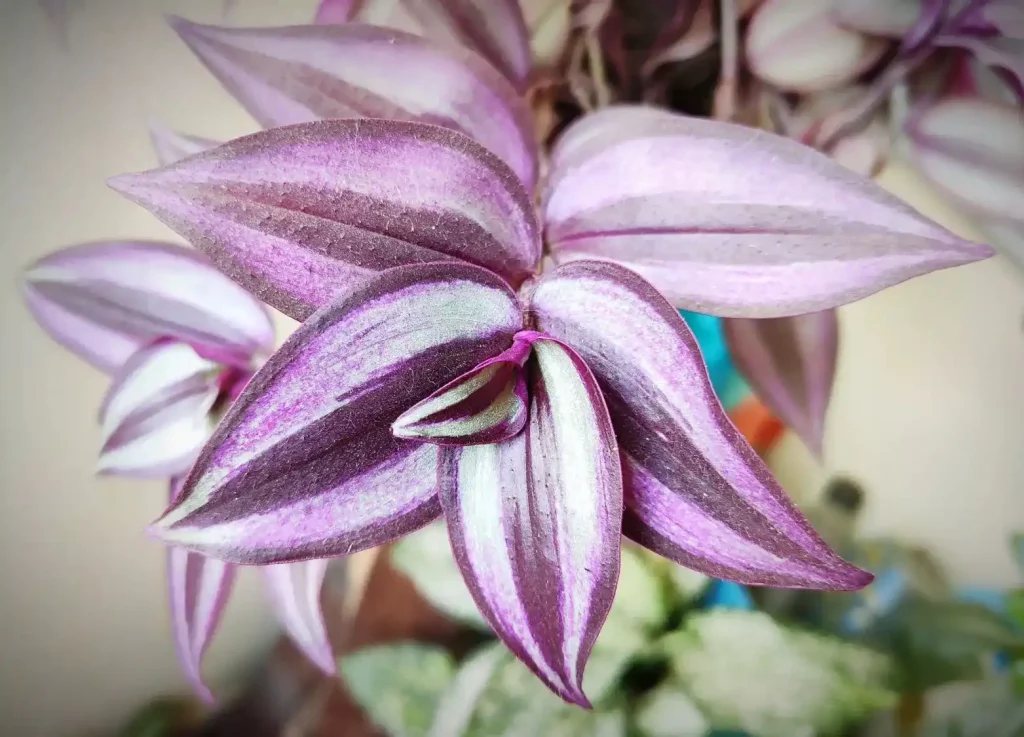
Quicks Facts About Wandering Jew Plant
Key Details about Wandering Jew Plants:
- Scientific Name: Zebrina pendula
- Common Names: Wandering Jew
- Propagation: Layering, Stem Cuttings
- Watering: Drench, Allow to Dry
- Humidity: Typical Home Levels
- Light Requirement: Bright to Filtered Light
- Potting Mix: All-Purpose
- Temperature: Indoor Settings
- Fertilization: Balanced
- Care Rating: Very Easy
- Decorative Use: Hanging Baskets, Tables
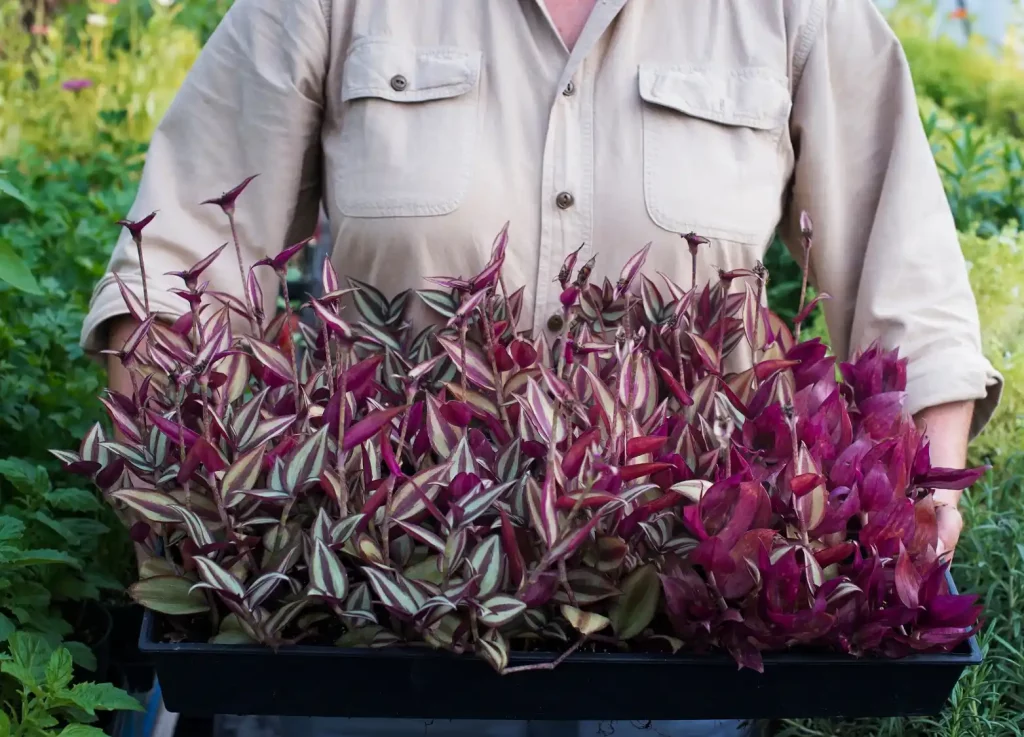
Our Gallery
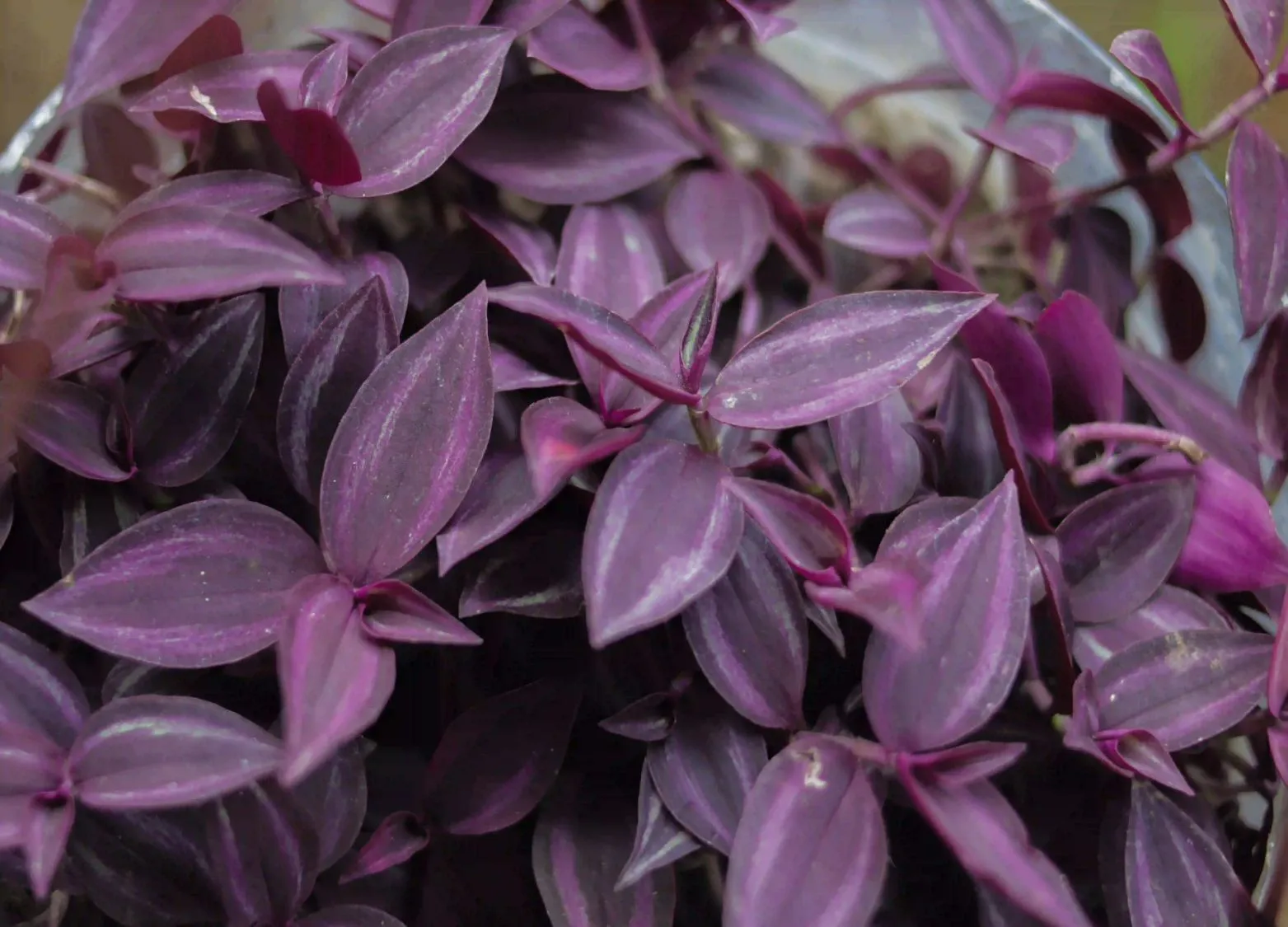
Planting and Propagating the Wandering Jew
Year-Round Propagation of Tradescantia Plants: Soil and Water Methods Propagating Wandering Jew through Soil
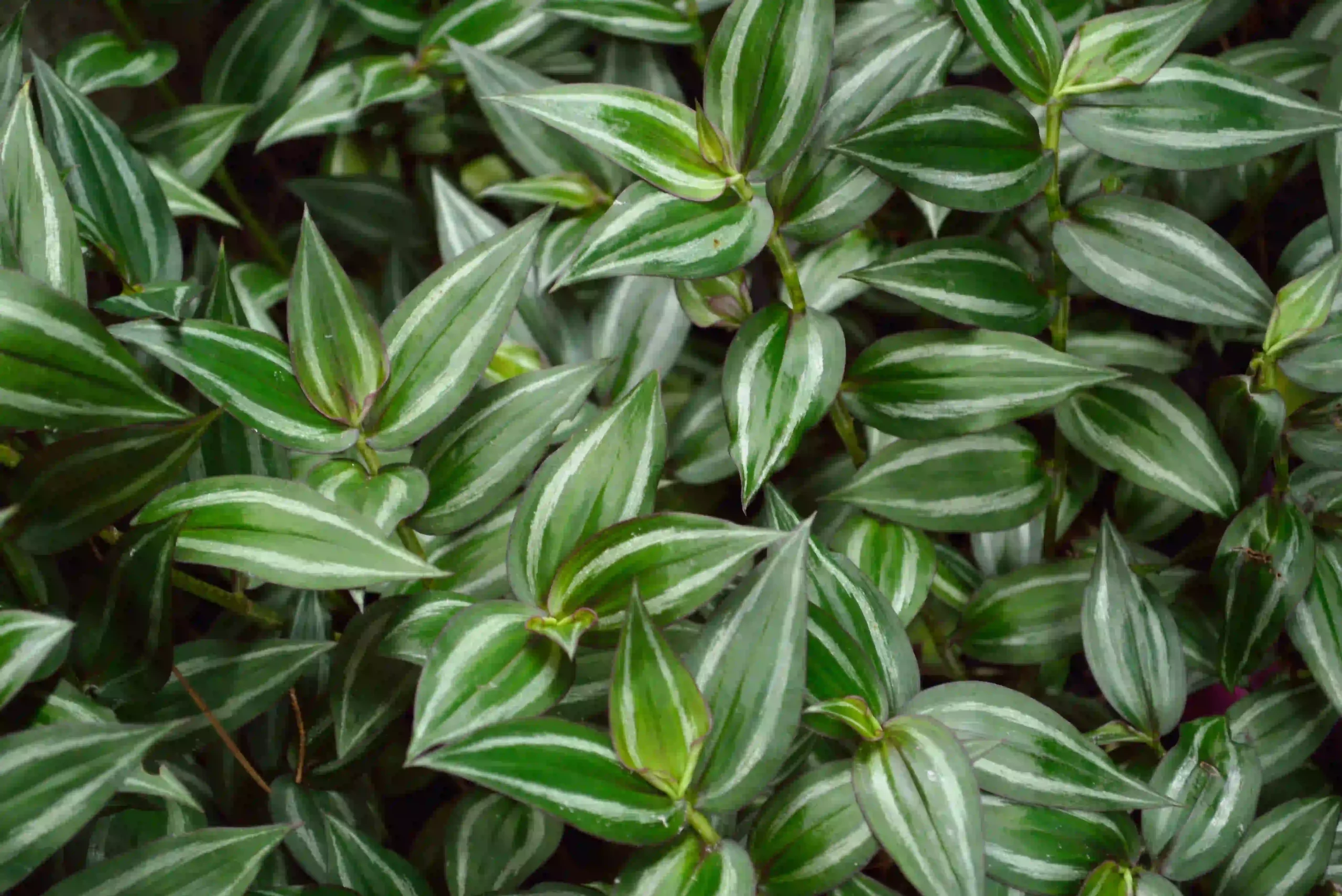
Propagating Wandering Jew through Soil
To propagate Wandering Jew in soil, take 4-6 inch cuttings, remove lower leaves, and plant them in a 6-inch pot filled with all-purpose soil. Keep the soil consistently moist, place in indirect light, and enjoy a vibrant new plant in a few months.
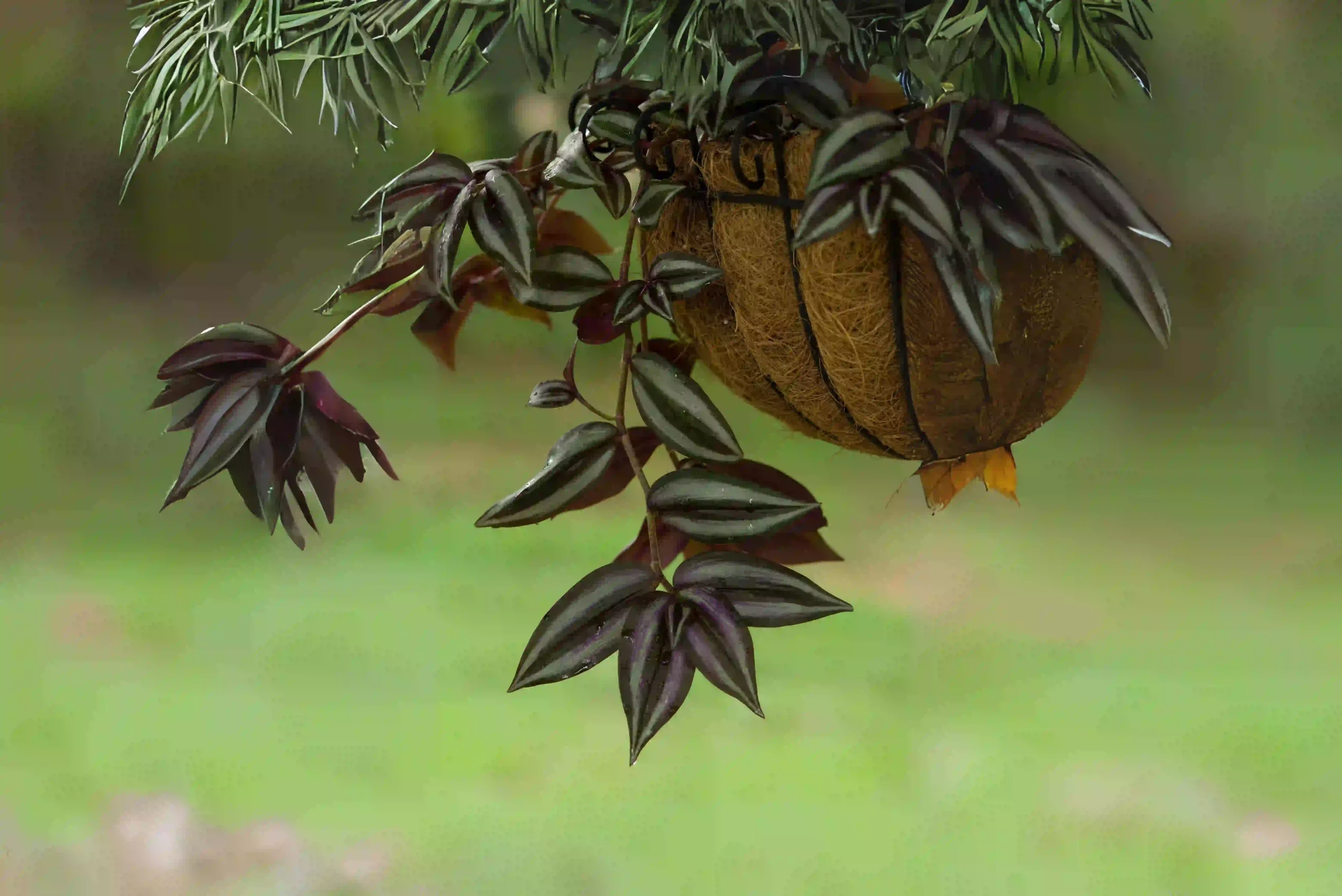
Propagating Wandering Jew through Water
To propagate Wandering Jew in water, make 4-6 inch cuttings beneath a leaf node, remove lower leaves, and submerge them in a glass or jar. After about a week, transfer the rooted cuttings to all-purpose potting mix, continuing standard care as the new roots develop.
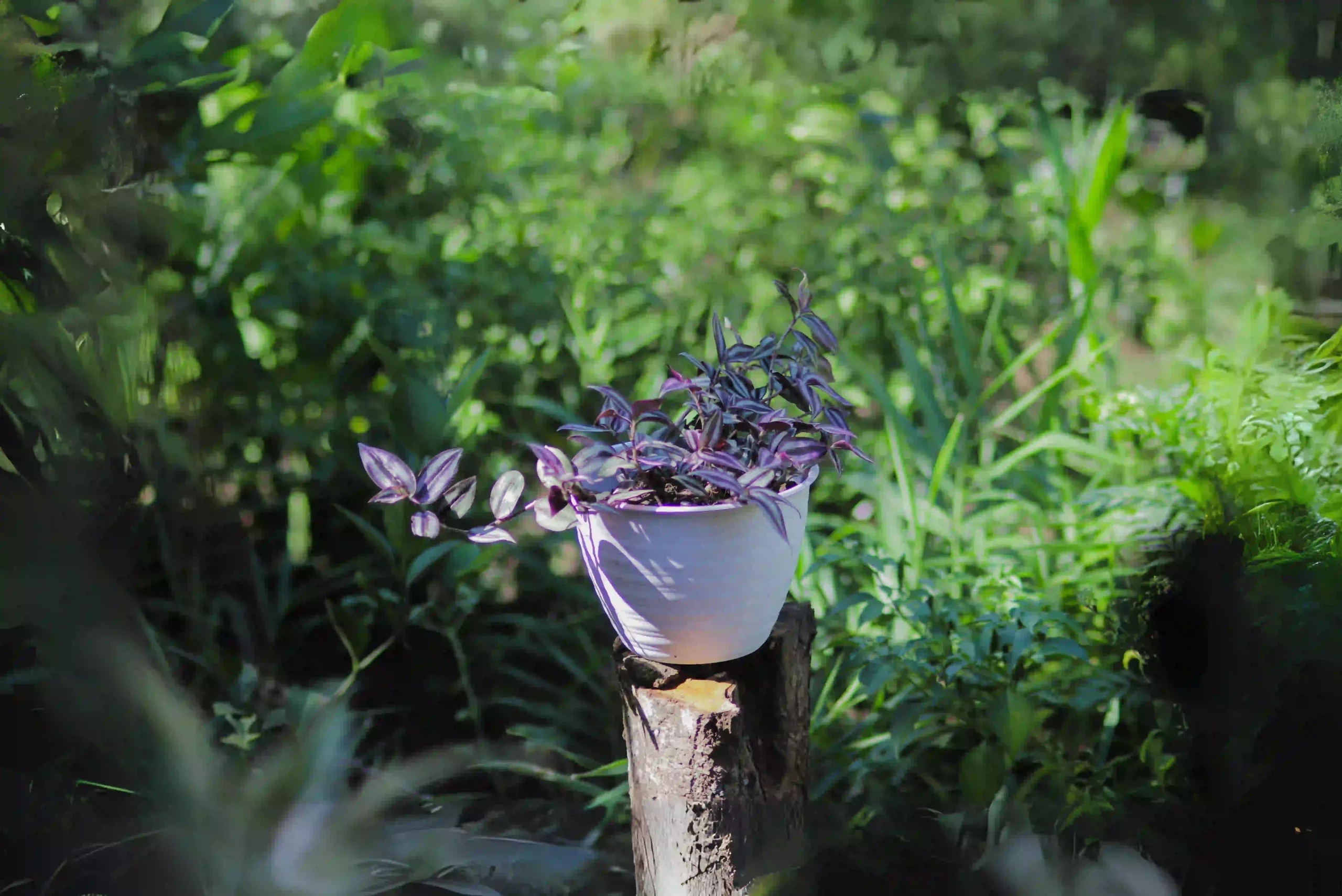
Repotting Wandering Jew Plant
Repot your Wandering Jew every two or three seasons in a slightly wider pot for healthier growth. Use porous containers, add fresh soil, and handle stems with care during the transfer, saving any fallen ones for replanting.
Let See the Review
Testimonials.
Designation
Lorem ipsum dolor sit amet, consectetur adipiscing elit, sed do eiusmod tempor incididunt ut labore et dolore magna aliqua.

How to Take care of a wandering plants indoor
Introduction The Wandering Jew plant scientifically known as Tradescantia zebrina is one of the most beautiful house plants...
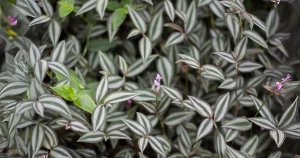
How to Take Care of Your Wandering Jew Plant
Introduction Regardless of whether you are an expert gardener or just a beginner, taking care of this Striped...
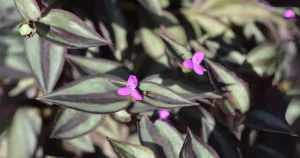
Reviving Your Wandering Jew Plant: Troubleshooting Tips for a Dying Base
Introduction Do you feel like you can't maintain the Wandering Jew plant in its best conditions? Have you...
We independently select everything we recommend. When you buy through our links, we may earn a commission.
Wandering Jew: A Magnificent Cascading Houseplant
Wandering Jew, or spiderwort plants, are popular houseplants loved for their beautiful purple and green variegated foliage, trailing vines, and ease of care.
- About this plant
- Plant information and care guide
Other names for this plant...
Spiderwort plant Inch plant Striped wandering Jew Purple wandering Jew Silver inch plant Wandering dude
About Wandering Jew
Wandering Jews are characterized by their striking purple, green, and silver tricolor leaves. They have recently acquired the alternative name of ‘wandering dude.’
Wandering Jew plants are known for their ability to trail and cascade, making them perfect for hanging baskets or as a trailing plant in a mixed container. They’re low-maintenance, tolerate low light levels, and are incredibly easy to propagate.
While wandering Jew plants are classified as succulents , they have slightly different environmental preferences than most succulents.
Botanical Name
The botanical name of the wandering Jew plant is Tradescantia zebrina. It is a member of the Commelinaceae family , which includes around 652 flowering plants in tropical and subtropical regions.
The wandering Jew plant is a herbaceous perennial, meaning it is a non-woody plant that lives for multiple growing seasons and dies back to the ground each winter when grown outside. As a houseplant, the wandering Jew will grow year-round but not produce much new growth in the colder months.
The wandering Jew plant is native to Mexico and Central America.
The wandering Jew plant is a trailing herbaceous perennial with long, slender stems. The leaves of the wandering Jew plant are typically lance-shaped and range in color from green to purple, with a silver stripe running down the center of each leaf.
The leaves are also slightly fleshy and covered in fine, soft hairs.
The plant produces small, three-petaled flowers that are usually pink or white but are not as showy as the foliage.
Types Of Wandering Jew Plants
Here are a few of the most popular varieties:
The most common wandering Jew plant is radescantia zebrina . It has green variegated leaves with a silver stripe down the center and purple undersides.
Tradescantia fluminensis has green leaves with white stripes down the center and are sometimes confused with Tradescantia zebrina.
Tradescantia pallida is also called purple heart or purple queen. It has purple leaves that turn almost black in bright light.
Tradescantia albiflora has green leaves with white or cream-colored stripes and produces small white flowers.
Tradescantia spathacea , or Moses-in-a-cradle, has long, pointed green leaves and produces small white flowers surrounded by a boat-shaped purple bract.
Tradescantia fluminensis , or “Variegata,” has striped leaves of green and cream.
Wandering Jew Styling
Here are a few ideas for styling your wandering Jew plant:
The cascading and trailing growth habit of the wandering Jew plant make it an excellent choice for a hanging basket. Choose a basket that matches your decor and hang it in a sunny location where the plant can receive indirect sunlight.
You may combine wandering Jew plants with other trailing or upright houseplants, such as spider plant , pothos, or fern , to create a mixed container display.
With some training, the wandering Jew plant can be grown up a trellis or other support to create a climbing effect. This is a great way to add vertical interest to your home decor.
Wandering Jew plants can be grown in a terrarium or other partially enclosed container, which creates a humid environment that the plant enjoys.
If you have a smaller wandering Jew plant, style it as a tabletop display by placing it in a decorative pot or container and using it as a centerpiece on a coffee table or dining table.
Wandering Jew plants thrive in bright, indirect sunlight but also tolerate some shade. Full sun scorches the plant leaves, so it is best to place it near a window that receives filtered or indirect sunlight. Provide some shade if you put it outside in the summer.
Wandering Jew plants prefer consistently moist, well-draining soil, so water the plant thoroughly when the top inch of soil feels dry. Avoid letting the soil dry out completely or become waterlogged, as this causes the plant to wilt or develop root rot.
Temperature
Wandering Jew plants like average room temperatures between 60 and 75°F (15 and 24°C) and tolerate a range of humidity levels. Avoid placing the plant in areas with temperature extremes, such as near drafty windows or heating vents.
Wandering Jew plants prefer moderate to high humidity, so keeping the soil evenly moist and occasionally misting the leaves to increase humidity levels is important. If the air in your home is particularly dry, place a small humidifier near the plant or group it with other houseplants to increase humidity levels.
Wandering Jew plants need a well-draining, peat-based soil with a pH between 5.5 and 6.5. Use a commercial potting mix or create your own by combining peat moss, perlite, and sand in equal parts.
As your wandering Jew plant grows, you must repot it into a larger container.
To prune a wandering Jew plant, use sharp, clean scissors or pruning shears to remove dead, damaged, or yellowing leaves. You can pinch back the growing tips to encourage new growth and branching and create a fuller, bushier shape.
When making your cuts, trim back to just above a node, a small swelling on the stem where new leaves and branches emerge.
Look for stems that have become leggy, stretched out, or are growing in an undesirable direction. Remove any dead, diseased, or damaged ones.
Wandering Jew plants do not require frequent fertilization but provide a balanced, water-soluble fertilizer every 2 to 4 weeks during the growing season (spring and summer). Avoid fertilizing the plant during the winter when it is not actively growing.
Height & Growth
The wandering Jew plant’s stems grow up to 2 to 3 feet (0.6 to 0.9 meters) in length. It can be a very fast grower during the growing season, so plan to prune it regularly to maintain the desired shape and size.
The wandering Jew plant (Tradescantia zebrina) is mildly toxic to humans and animals. The sap of the plant contains oxalates, which cause skin irritation and a rash in some individuals. Oxalates cause gastrointestinal upset if ingested, such as nausea, vomiting, and diarrhea. If ingested, the plant causes irritation and swelling of the mouth, lips, and throat.
Tradescantia zebrina is toxic to pets .
Common Problems
The common problems of a wandering Jew plant include yellowing leaves caused by over-watering, under-watering, or lack of humidity. The plant is also susceptible to pest infestation , like spider mites, aphids, and mealybugs.
How To Propagate Wandering Jew
The propagation of wandering Jew plants is achieved by taking a stem cutting and placing it in potting soil. Keep the soil moist and care for the new plant as you would for a mature wandering Jew plant.
The cutting will take root very quickly in soil or water. Many people take the cuttings from a pruning session and simply stick them back into the same pot to encourage fuller growth.
Frequently Asked Questions
Does wandering jew like sun or shade.
Wandering Jew plants prefer bright, indirect sunlight but also tolerate some shade. Direct sunlight scorches the leaves of the plant.
What is the most common type of Wandering Jew?
The most common type of wandering Jew is Tradescantia zebrina, also known as the inch plant, purple-heart, or purple queen. This plant has distinctive purple and silver striped leaves and trailing stems.
Is Wandering Jew poisonous to cats?
Yes, wandering Jew plants are toxic to pets. The plant contains compounds that cause irritation and digestive problems if ingested. Symptoms of wandering Jew plant toxicity in cats are vomiting, diarrhea, loss of appetite, and lethargy.
Articles about this plant
7 best hanging plants indoors, get your weekly fix of interior design inspiration.
Delivered to your inbox every Saturday morning

- Rustic Home Decor
- Outdoor decorations
- Storage Ideas
- DIY Projects
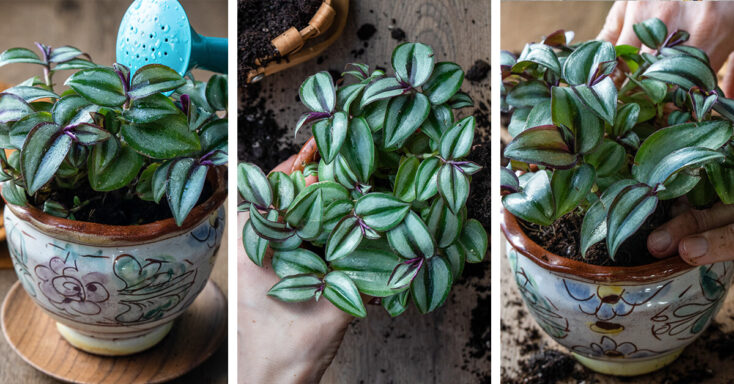
Wandering Jew Plant Care – How to Plant, Grow and Help Them Thrive
Tradescantia zebrina, commonly called the Wandering Jew plant, is a striking houseplant known for its variegated leaves tinted with green, silver, and purple. It originated in Central America and Mexico’s tropical regions. So, the Zebrina is a perfect choice for growing indoors. The good news is that Wandering Jew plant care is not difficult at all!
Key Takeaways
- Zebrina is a low-maintenance, fast-growing plant.
- The Zebra Plant makes an excellent choice for beginner gardeners because care isn’t overly complex.
- This plant quickly fills up empty spaces in your indoor landscaping efforts.
- Pruning is good for Zebrinas. It maintains their shape and keeps them from becoming invasive.
Wondering about the Wandering “Dude”
The Zebrina has numerous nicknames (many from cultivars), including Silver Inch Plant, Striped Trad, Striped Wandering Creeper, Purple Heart Plant, Small Leaf Spiderwort, Moses in the Cradle, and Zebra Plant. Because the name Wandering Jew is offensive to some, gardeners usually use one of these, the botanical name, or the new moniker, Wandering Dude.
The flowing leaves on this plant measure about ½ inch long and about ¼ inch wide. When used outdoors, they make a colorful ground cover. The flowers are pink to purple and bear brownish seeds. Take care when you work with the zebra plant. The sap proves irritating to some people.
Light Play: When Zebrina is in bright light, the colors become even more vibrant. If you have a window location with indirect light, the exposure enhances leaf pigments. It is very visually appealing.
The Basics of Wandering Jew Plant Care (Zebrina)
In taking care of any indoor plant, there are certain important points in your care routine.
- Temperature: Zebrina plants thrive when the temperature is around 70 degrees. Keep the plant away from drafts or air conditioning ducts.
- Light: South or eastern-facing windows work best, provided the light is indirect. If they’re not getting enough sun, they become spindly.
- Water: Keep your inch plant moist. Avoid over-watering or letting the plant’s soil dry out completely.
- Soil: Plant your Wandering Dude in a peat-based potting mix with good drainage.
- Humidity: Good news! The average humidity in your home should work fine.

The Battle of Fronds vs. Flowers: Many people buy houseplants for their flowers. Zebrinas do produce delicate petals, which look charming. However, the true allure of the Wandering Dude is its foliage.
Wandering Jew Plant (Zebrina) Needs
When you’re looking for a beautiful backdrop to your indoor garden efforts, Zebrina fills that need. Mix the type of container you use for greater visual impact. You can take your plants for a summer stroll, but you cannot leave them outdoors during winter.
Except for Purple Queen Zebrina, which loves direct light, the fronds of these plants will burn if left in direct sunlight for too long. If you have a window that gets light in the morning and indirect light later, the Wandering Dude will thrive.
Tip: Turn your pots periodically so all sides of the plant benefit from sunlight.
If you’d like to expand your Zebrina family, propagation is simple. It begins with taking a stem cutting. Look for a healthy stem and snip it below a node. You can then root it in a glass of water or put it directly into the soil. A little rooting compound improves the results from direct soil planting.
Choosing a Wandering Jew Plant for Your Home
Inch Plant (blossfeldiana): Thick, fuzzy leaves with purple undersides. It blossoms in flower clusters of white, rose pink, or blue. Mature height 6-12 inches.
Longpipes (Wild Crocus): These bluish-purple flowers appear from May until June. It’s thin, arching leaves grow up to 7 inches long. If you have a rock feature inside, longpipes will do well there.
Moses-in-a-basket (Oyster Plant; Boat Lily): The dark green leaves are sword-like and grow in a spiral. The undersides of the foliage are purple, and it blossoms with white flowers. Dwarf plants are 6-12 inches tall and require 6-8 hours of indirect light daily. The vibrant purple undersides of this plant’s leaves are truly striking.
There are two popular variants of Moses-in-a-Basket. One is a Tricolor, bearing pink, green, and cream leaves. The other is a Golden Oyster with bright gold-yellow leaves.
Pallida: A native of Mexico, Pallida goes by the name Purple Heart. The foliage is eggplant purple, adorned with light pink flowers bordering on orchid—a good choice for hanging baskets. Grows 1-2 feet tall and wide.
Striped Inch Plant (River Spiderwort, Speedy Henry): Average size is 12” x 12”. The plant’s leaves are dark green, shiny, and pointy (2 inches). Striped inch plants blossom with white flowers.
Virginia Spiderwort: Bright green narrow leaves topped with violet, three-petaled flowers that measure 2” across. Each flower only lives for a day, but there are so many you won’t notice. This is a larger member of the Wandering Jew family, with an adult height of 18-20 inches and a width of 12-18 inches.
White Velvet: Gray-green leaves covered in white hairs distinguish this Wandering Jew from others. It blossoms for about a month in bright pink-purple flowers. Received the Award of Golden Merit from the Royal Horticultural Society. Mature height: 12 inches.
While humans suffer no illness from Zebrina, ingestion by pets can be toxic. Keep this in mind when placing them around your indoor garden.
Wandering Jew Plant Watering Techniques
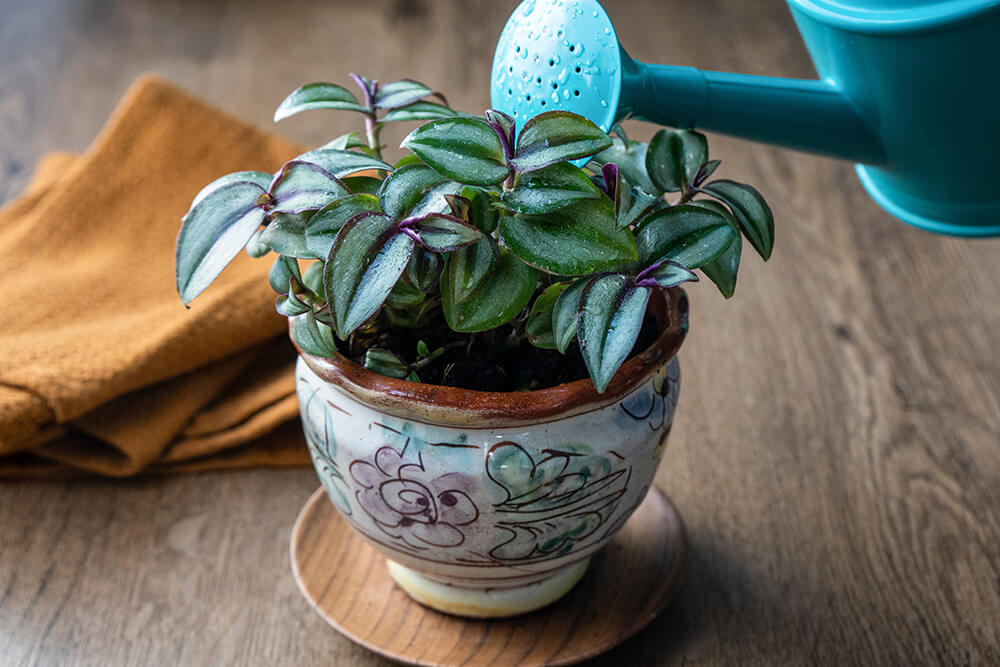
While these plants handle random overwatering, it won’t continue being healthy if left waterlogged too long. When you apply water, do so from the base of the plant. Watch and you can see the water absorption. Alternatively, you can take the plant to your sink and give it a good bottom watering until the liquid comes out of drainage holes. Let it finish in the sink, then put it back in place.
When you walk through your home, regularly check your plant’s soil. Put your finger down to the ½ inch point in the soil. If it’s dry, then water. Because your Wandering Jew may grow at different rates throughout the year, this test alleviates guesswork.
If you are busy and may forget, try an aqua globe.
Vertical Space: If you want a plant to fill some of your vertical space, you’ll be happy to know Zebrina can be trained. By using a support, you can guide it toward climbing. Use a moss pole or trellis as a support system.
Wandering Jew: Potting and Repotting
Tradescantia are fast growers, so you may need to repot it every two or three seasons. When it’s time, you want to give the plant a larger container and fresh soil. Zebrina’s roots will start peeking out of drainage holes to tell you they need more space. Alternatively, they may move up the side of the pot toward the container’s edge.
When you remove the plant from the current container, begin by putting it down on its side. Hold the pot with one hand and the base of the foliage with the other. Gently wiggle (the stems can be quite delicate). Once it slides out, shake off old soil and inspect for signs of disease or pests.
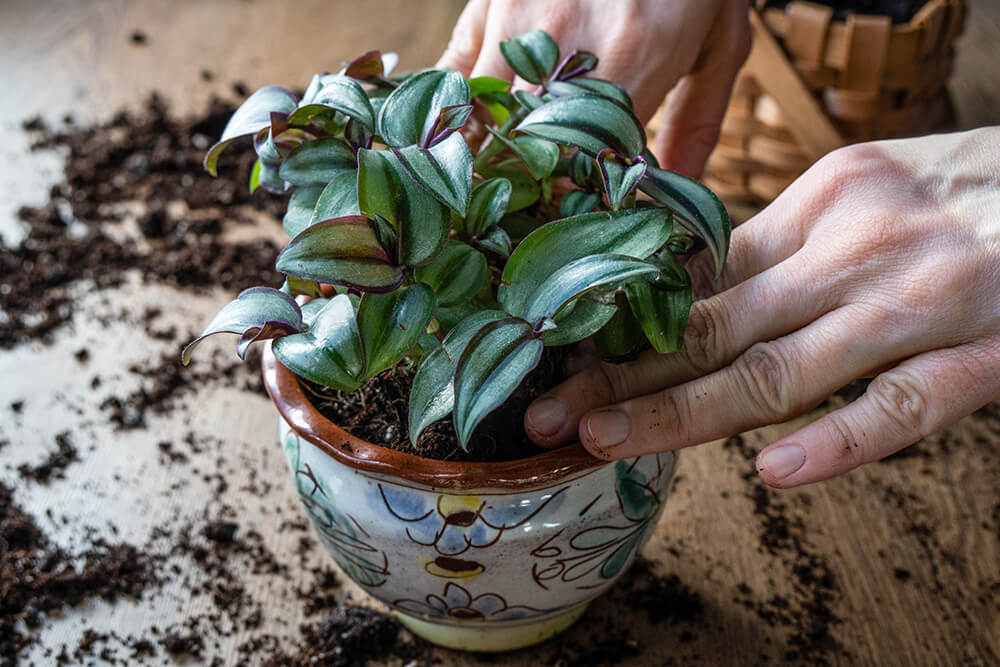
As a generalization, Zebrina represents adaptability, growth, and resilience. Because of its hardy nature, this plant has become a metaphor for overcoming adversity and showing grace during times of transformation. It is an emblem of the human spirit’s perseverance and enduring hope. In literature, the flower appears as a symbol of beauty, strength, faith, and diligence.
Dream books say the Wandering Jew appearing reminds you all is not lost. Stay true, stand tall, and succeed. If you’re holding the flower, it portends luck and prosperity.
Pruning and Maintenance
Because this plant grows quickly, heavy pruning is good for it. Make it an addition to your regular Wandering Jew care routine. Trim off long tendrils, dead leaves, and weak growth. Pinch off new growth and thin it out. This helps create a bushy appearance and transforms the plant into something suitable for your indoor efforts.
Sometimes, per their name, Zebrina goes a-wandering. It becomes leggy stems with few leaves. Keep those trimmed down so the plant can focus its energy more effectively. If you’re plants look rather dull, trimming is the trick for promoting thick leaves.
Perhaps the most important reason for pruning Wandering Jews is to keep them healthy. Removing unhealthy or dead parts deters fungus and disease.
When: Indoor plants often follow nature’s lead, resting during fall and winter. So, give them their haircut in spring or early summer at the latest.
Zebra Plants and Therapeutic Properties: Inch plants have antioxidants and antimicrobial properties. In areas like Jamaica, people treasure them as a treatment for high pressure and cough while applying leaves for swelling. In China, this plant has the name “Water Turtle Grass.” It’s recommended for kidney disorders. Mexicans have an inch plant leaf decoction used as a tonic. Along the same lines, Guyana healers brew the leaves and offer the tea for influenza and digestive issues.
Blooming and Resting Periods
This plant’s flowers benefit from a dormant period the previous winter. Since it’s indoor, you’ll need to put the Zebrina in an area hovering around 60F. Reduce water. You want the soil to dry for two weeks between irrigation. Always use room-temperature water so you don’t shock your plants.
Once the Wandering Jew is growing, you’ll need to water it once a week. Now is the time for fertilization.
There is a legend that surfaced in the 13th century. It says that a Jewish person taunted Jesus on his way to crucifixion. As a result, the person was cursed to walk the earth until the second coming. Another sad account was that of a condemned man separated from his sister by the Bering Straight. He set out to find her, yet wherever he traveled, plagues followed. There is no happy ending here. The fellow never finds his sister.
There is no question that the Wandering Jew is diligent and sometimes invasive, so perhaps some of those characteristics contributed to the plant’s name.
Common Pests & Plant Diseases
Wandering Dudes rarely have pests indoors. Occasionally, you may find aphids or spider mites. You can wash both off the leaves or use a natural insecticide.
When you see small white webs on the undersides of leaves, that’s a spider mite. They like it warm and dry, so amp up the humidity using a household humidifier near the plant. Spray it periodically. Should the critters persist, wash the plant in your sink.
Signs of Aphid infestation include:
- Weakened growth
- Yellowing, twisting, or curling leaves
- Small white flakes on the leaves (this is the result of aphids shedding their exoskeleton)
- A sticky, shiny substance on leaves and stems (honeydew)
- Black, sooty mold (a result of honeydew)
- Diseased plants (aphids carry over 100 different viral diseases that can settle into the Wandering Jew)
Neem oil is a trusted remedy. Apply, then re-apply in a week. Continue more applications until they’re gone.
When it comes to disease, most develop because of over-watering, which leads to root rot. Roots can only retain so much water before they start getting mushy. The good news is you can remedy this easily. Reduce your watering schedule and improve the drainage in the soil. Just add some coarse sand or perlite.
Black patches and white powdery particles on your plant’s leaves reveal fungal issues like leaf spots, botrytis, and powdery mildew. Clean away affected foliage. Make sure your plant isn’t over-watered. If you get stuck and the fungus won’t go away, you should dispose of the Wandering Jew and sterilize the container before reusing it.
In an odd twist, you can grow wandering jew plants in water. You will need to change the water every 4 days and add a little fertilizer (3:1 ratio in freshwater). Using purified water is best. Salt and chlorine can adversely affect these plants. Also, make sure the water is at room temperature. With the right lighting, you can keep Zebrina alive in water for a long time, much like money plants.
Troubleshooting Common Wandering Jew Problems
- Bare stems and spindly growth: Over the years, this is natural. However, in younger plants, it may indicate a lack of light, water, or fertilization.
- Loss of leaf color: When variegated leaves begin turning all green, your plant is getting too much direct sunlight.
- Limp stems: Typically means a lack of water, but could be a sign of insects.
Word Play: The Inch Plant’s name is descriptive to a T. This foliage grows approximately one inch every week! It can also propagate itself using only an inch of stem.
Frequently Asked Questions About Jew plant
Does a wandering jew plant need sun.
Yes, but not direct sun. An area with indirect light is best for these plants. Turn the plant periodically so all sides get filtered light regularly.
How do you care for a wandering Jew indoors?
Now, you may have Wandering Jews that are just indoor plants. But if you have outdoor pines, you; 'll need to bring them into your home before the threat of frost. They’ll do just fine in your household landscape as long as you give them adequate light and proper watering.
How often do you need to water a wandering Jew plant?
If your Wandering Jew develops mushy stems, you’re over-watering it. Don’t automatically bring over the water pail. Check the soil. If it’s dry down to 1”, it’s safe to add moisture. Otherwise, wait.
How long will wandering Jew last?
Wandering Jews are fairly hardy. As long as you care for them correctly, your Tradescantia plants will live for many years.
How big do wandering Jews get?
Much depends on the type. Most plants don’t grow beyond one foot tall but may have longer (2-foot) stems.
Zebrina plants have a rich history and a variety of interesting traits. It thrives in a variety of environments, and has alluring striped leaves, and people enjoy looking at it. When you want to add some living greenery to your indoor garden, Zebrina is one possibility. It’s exotic yet understated, and you will enjoy it for years to come.
- Living Room
- Dining Room
- Laundry Room
- PRO Courses Guides New Tech Help Pro Expert Videos About wikiHow Pro Upgrade Sign In
- EDIT Edit this Article
- EXPLORE Tech Help Pro About Us Random Article Quizzes Request a New Article Community Dashboard This Or That Game Popular Categories Arts and Entertainment Artwork Books Movies Computers and Electronics Computers Phone Skills Technology Hacks Health Men's Health Mental Health Women's Health Relationships Dating Love Relationship Issues Hobbies and Crafts Crafts Drawing Games Education & Communication Communication Skills Personal Development Studying Personal Care and Style Fashion Hair Care Personal Hygiene Youth Personal Care School Stuff Dating All Categories Arts and Entertainment Finance and Business Home and Garden Relationship Quizzes Cars & Other Vehicles Food and Entertaining Personal Care and Style Sports and Fitness Computers and Electronics Health Pets and Animals Travel Education & Communication Hobbies and Crafts Philosophy and Religion Work World Family Life Holidays and Traditions Relationships Youth
- Browse Articles
- Learn Something New
- Quizzes Hot
- This Or That Game
- Train Your Brain
- Explore More
- Support wikiHow
- About wikiHow
- Log in / Sign up
- Home and Garden
- Indoor and Patio Plants
A Complete Guide to Wandering Jew Plant Care
Last Updated: May 28, 2024 Fact Checked
- Potting Your Plant
- Caring for Your Plant
Preventing Pests & Disease
Expert q&a, things you'll need.
This article was co-authored by Chai Saechao and by wikiHow staff writer, Dev Murphy, MA . Chai Saechao is the Founder and Owner of Plant Therapy, an indoor-plant store founded in 2018 based in San Francisco, California. As a self-described plant doctor, he believes in the therapeutic power of plants, hoping to keep sharing his love of plants with anyone willing to listen and learn. There are 12 references cited in this article, which can be found at the bottom of the page. This article has been fact-checked, ensuring the accuracy of any cited facts and confirming the authority of its sources. This article has been viewed 644,336 times.
Wandering Jews are beautiful vining plants known for their solid or variegated leaves. These hardy perennials thrive outdoors as groundcover or in pots that allow their tendrils to cascade. They’re relatively easy to care for and incredibly simple to propagate, making them great houseplants! Keep reading for an easy step-by-step guide to Wandering Jew maintenance, from planting to watering to pruning.
Things You Should Know
- Keep your Wandering Jew in a warm spot (around 50–80 °F (10–27 °C)) with lots of bright, indirect sunlight.
- Pot your plant in well-draining potting soil in a container with drainage holes. Keep the soil moist, but not soaking wet.
- Pinch or prune the leaves when the plant gets leggy to promote bushiness, or when any leaves or vines begin to brown or rot.
Potting Your Wandering Jew Plant

- Refer to this map to see if your area's temperatures are warm enough to support a Wandering Jew plant, if you're planning on keeping it outside. According to the USDA, the Wandering Jew plant grows best in zones 9-11.
- If you don’t live in USDA hardiness zones 9-11, keep in mind that you may not be able to keep your plant outside during the winter. You may want to grow it inside instead.

- If you use a hanging basket, remember to turn it daily so it gets equal amounts of sunlight.
- If you’re hanging your plant, choose a lightweight or plastic pot so it won’t fall. This also makes it easier to move inside in case of frost.

- Be careful not to use soil that’s too heavy, as Wandering Jews need light soil that drains well. [3] X Research source
- Buy well-draining soil, or, if you already have heavier soil, mix equal parts soil with compost, or equal parts soil, compost, and peat.
- Purchase a Wandering Jew plant at a gardening or home improvement center, or propagate cuttings from established plants . Wandering Jew cuttings grow very quickly.
Watering, Fertilizing & Pruning Your Plant

- If you’re growing your plant indoors, an eastern facing windowsill is a good spot. The plant will receive bright indirect light throughout the day, but watch to make sure the space doesn't become too hot in the afternoon. If so, move the pot a few feet away or use a curtain to filter the light. [5] X Research source
- If the plant primarily remains outside, find a spot that receives indirect sunlight. This could be on a porch that gets morning sun for several hours. Just make sure that it's not sitting in direct sunlight without any shade for most of the day.

- If you've set your pot on a saucer, empty the saucer when it fills.
- The plant's growth will slow in the winter months, meaning it needs to be watered less often. Simply let it remain a little dry for a bit longer before watering.
- Some people find it convenient to put self-watering aqua globes in their plant pots; however, these glass globes require cleaning and regular filling. You'll still need to monitor your plant's moisture if you choose to use them.

- Read the container's instructions carefully before fertilizing, as some liquid fertilizers may actually be powders requiring you to mix in water.

- The best time to prune is during the spring and summer months, when the plant is putting on the most growth. After you've pruned, give the plant a chance to put on new shoots and fill in.
- If you find your plant is too dense and bushy, you'll need to prune around the base so that the plant can get adequate circulation and sunlight.

- Generally, expect to repot your plant annually, but keep an eye out for signs your plant has outgrown its container within that time frame: once you see roots creeping out from under the plant through the drainage holes, or popping up through the soil, it’s time to repot. [10] X Trustworthy Source Penn State Extension Educational organization dedicated to delivering science-based information to people, businesses, and communities Go to source

- Try to use distilled or bottled water when misting the leaves for the best results.
- Brown leaves can also be a sign that your plant is getting too much sunlight. In this case, make sure your plant is not directly in the sun by moving the pot or placing a filter, such as a curtain, in between the plant and the window.

- Root rot can spread very quickly, so act fast when you see signs of it. It can be heartbreaking to cut away a large chunk of your plant, but if you wait too long, you could lose the whole plant. [14] X Research source
- Other signs of root rot include spongy, black roots.

- Though "Wandering Jew" is the most common name for this plant, some people may find this term offensive. Consider using "wandering dude" or "inch plant" instead. Thanks Helpful 2 Not Helpful 2
- "Wandering Jew" doesn't refer to just one plant: it refers to a variety of Tradescantia species, the 3 most common of which include Tradescantia fluminensis ("Quicksilver"), Tradescantia pallida ("Purple Heart"), and Tradescantia zebrina ("Tricolor"). Care is the same for all 3. Thanks Helpful 1 Not Helpful 1

- Be careful when pinching or pruning your plant. Wandering Jew sap can cause skin irritation in some people and allergic reactions in dogs. To be safe, wear gardening gloves when pruning your Wandering Jew. [15] X Research source Thanks Helpful 0 Not Helpful 0
- Wandering Jew cuttings or a plant
- Well-draining potting soil
- Pot or hanging basket
- 10-10-10- fertilizer
- Aqua globes (optional)
- Pruning shears (optional)
- Gardening gloves
You Might Also Like

- ↑ https://houseplantcentral.com/tradescantia-zebrina-care-info/
- ↑ https://www.almanac.com/plant/inch-plants
- ↑ https://getbusygardening.com/wandering-jew-plant-care/
- ↑ https://www.weekand.com/home-garden/article/indirect-light-plants-18005506.php
- ↑ https://www.almanac.com/plant/wandering-jew
- ↑ https://www.weekand.com/home-garden/article/use-101010-fertilizer-garden-18057536.php
- ↑ https://www.gardeningknowhow.com/houseplants/wandering-jew/growing-wandering-jew-plants.htm
- ↑ https://extension.psu.edu/repotting-houseplants
- ↑ https://www.houseplantsforyou.com/wandering-jew/
- ↑ https://www.gardeningknowhow.com/plant-problems/disease/treating-root-rot-gardening-tips-for-housplants.htm
- ↑ https://www.wildinteriors.com/blog/2019/10/30/treating-root-rot-and-soft-rot-in-houseplants
- ↑ https://www.weekand.com/home-garden/article/wandering-jew-plants-dangerous-dogs-18063157.php
About This Article

To take care of your Wandering Jew plant, place it by an east-facing window so that it gets a combination of direct and indirect sunlight. Keep the soil moist, but not soaked, and water the soil instead of the top of the plant to avoid rot. You should also fertilize the Wandering Jew plant every two weeks with a liquid 10-10-10 fertilizer. To keep the plant from getting leggy, trim back the stems in the spring and summer. Did this summary help you? Yes No
- Send fan mail to authors
Reader Success Stories
Nancy Gibson
Jun 6, 2016
Did this article help you?
Sherry Clark
Mar 30, 2016
Sep 23, 2016
Beverly Cox
May 18, 2016

Featured Articles

Trending Articles

Watch Articles

- Terms of Use
- Privacy Policy
- Do Not Sell or Share My Info
- Not Selling Info
wikiHow Tech Help Pro:
Level up your tech skills and stay ahead of the curve

Wandering Jew Plant
Table of Contents
A Wandering Jew plant, Tradescantia , is a fast growing, easy to care for plant that looks beautiful hanging in front of a window that gets bright, indirect light but no direct sun. Popular nicknames are “Inch Plant” or Spiderwort. Originally found growing as a 1-2ft tall wildflower in Canada and all the way south to Argentina, today a wandering jew plant is both a popular indoor and outdoor plant throughout the world.
Description
The wandering jew plant group is made up of several different varieties. Most have long vines of 2″-4″ oval or heart shaped leaves. Leaf color depends upon the exact type and can be solid green, green with a purple stripe, green with a white or yellow stripe, green with splashes of pink, purple, and cream, or solid purple. The back of the leaf may also be purple. Some wandering jew plants have hairy leaves and some with a silver shine to them. The wandering jew plant produces small flowers in white, pink, purple, or magenta.
Wandering Jew Plant Varieties
The five varieties most commonly used as indoor plants are the Tradescantia zebrina, Tradescantia fluminensis, Tradescantia sillamontana, Tradesantia pallida, and the Tradescantia blossfeldiana.. All types of Wandering Jew plants are easily propagated using stem tip cuttings.
- The Zebrina variety of the Wandering Jew plant has long vines covered in small, stemless leaves about 2” in length. The colorful patterned leaves, green with purple stripes, have a silver shine. The underside of the leaf is a deep purple or magenta color. A Wandering Jew zebrina produces small pink to purple flowers.
- The basic Fluminensis Wandering Jew plant has long stems of small, shiny, oval, dark green leaves with fleshy stems and produces triangular, white flowers. The more popular variegated fluminensis has cream colored or yellow stripes on the leaves.
- The Sillamontana Wandering Jew plant has a different growth pattern and leaf than other members of the tradescantia family. This is not a vining plant. All the leaves, which are covered in white hair, come off a single, thick stem. Magenta flowers develop at the ends of the stems.
- The Palida Wandering Jew plant (Purple Heart Wandering Jew plant) has deep purple leaves with white, purple, or pink flowers.
- The Blossfeldiana Wandering Jew plant has vibrantly colored, fuzzy, green leaves with splashes of pink, purple, and cream and produces clusters of white flowers.

T. Zebrina T. Sitara Gold T. Palida T. Blossfeldiana
Quick Care Tips
Bright light essential for colorful leaves
Reduce water in winter
Repot in the spring if necessary
Avoid temperatures below 45°F ( 7.4°C)
Propagate using stem cuttings
Prune aggressively to keep plant bushy
Wandering Jew Problems
Brown leaf tips: air too dry or spider mites
Limp stems and yellow leaves: plant needs more water
Variegated varieties turn solid green: plant need more light
The sap of a wandering jew plant is slightly toxic to small children, cats, dogs, and other pets.
Read more about common houseplants that are poisonous in my book Don’t Feed Me to Your Cat: A Guide to Poisonous Houseplants.
How much light does a Wandering Jew plant need: Bright indirect light helps the plant produce colorful leaves and flowers. Direct sun causes the color in the leaves to fade.
How to water a Wandering Jew plant: Water well and then allow the top 2″ to 3″ of soil dry out before watering again. If the soil is very dry and the plant is sitting in bright light, the leaves become stunted and lose color. Lack of water can also cause brown and crispy leaves on a Wandering Jew plant. This usually problem affects to older growth first. Over watering is more serious, resulting in root rot.
Feed monthly when a Wandering Jew plant is producing new growth with a water-soluble houseplant food diluted to 1/2 the recommended strength. How to fertilize a Wandering Jew plant: Using a plant food high in nitrogen helps the plant produce more colorful leaves. Over-fertilizing causes the bright colors in the leaves to fade.
Temperature
Best temperature for a Wandering Jew plant: Try to maintain temperatures between 60°- 80°F (15.6°- 26.7°C).
Does a Wandering Jew plant need high humidity: Average to high household humidity is best. If the air is too dry, the leaves of a Wandering Jew plant turn brown. Place a Wandering Jew plant on a tray of wet pebbles to increase the humidity; be sure the plant is sitting on the pebbles and not in the water.
Does a Wandering Jew plant flower: In ideal growing conditions, the plant produces small white, pink, or purple flowers.
Wandering Jew plant pests: Although these plants are fairly pest resistant, aphids, scale, and mealy bugs can be a problem. See pictures of these plant pests and learn how to get rid of them in Glossary of the website.
Wandering Jew plant diseases: The high humidity that helps the plant grow better also encourages fungal and bacterial idiseases
Best soil to use for a Wandering Jew plant: Use a well- aerated soil that drains quickly. If the soil seems heavy and clay-like, add some peat moss and perlite.
What size pot for a Wandering Jew plant: This is a fast growing plant so check the root-ball frequently to see if a larger pot is needed. Repot, when necessary, in the spring. Use the next size pot, nothing larger, and be sure there are drip holes in the bottom.
How to prune a Wandering jew plant: When the stems get very long and leggy as the plant matures, don’t hesitate to aggressively prune the plant. When pruning, make the cut above a leaf node (the place where a leaf is attached to the stem). It may take a while for the trimmed stems to bush out , so be patient. You can use the stem clippings to propagate new plants.
Propagation
How to propagate a Wandering Jew plant: Very easy to do, take stem cuttings in the spring, summer,or fall. You can read more about how to propagate a plant using plant cuttings in the Glossary of the website.
Poisonous Plant Info
A Wandering Jew plant is slightly poisonous with a Level #1 toxicity. It is toxic to dogs, cats, and small children. The sap of the plant is caustic and may cause skin irritations or a rash. It is, however, considered safe to put into bird or reptile enclosures.
If a Wandering Jew plant gets a few hours of direct sun every day, the color in the leaves fades. I’d recommend moving your plant to a different area where it will get bright indirect light .
You probably waited a little too long before pruning your Wandering Jew plant so that’s why it’s still not doing well. Unlike most houseplants, Wandering Jew plants take a long time before starting to produce new leaves. Place your plant in bright indirect light and be patient. You can always use some of the Stem Cuttings to start some new plants.
You are killing your Wandering Jew plant with kindness. A Wandering Jew plant gets brown leaves and mushy stems when it is over-watered and over-fed. This plant needs water when the top few inches of soil are dry. Over- feeding is worse than no food at all. Fertilize monthly with a water soluble plant food diluted to 1/2 the recommended strength. Feed only when the plant is producing new leaves. For now, cut off all of the brown leaves and soggy stems and replace the soggy soil with new, fresh, well-aerated soil. Place your Wandering Jew plant in a warm bright area, water carefully, and do not fertilize for at least two months.
- Growing Houseplants
- Indoor Garden Ideas
- Cactus & Succulents
- Houseplants Care
- Flowers & Blooms
- Gardening Guide
- Plant Care and Tips
- Beans/Fruit Vegetables
- Companion Planting
- Culinary Herbs
- Flowering Herbs
- Garden Design
- Gardening Ideas
- Growing food
- Growing Trees and Shrubs
- Leafy Vegetables
- Medicinal Herbs
- Patio Gardening
- Root Vegetables
- Shade Plants
- Temperate Fruits
- Tropical Fruits
- Balcony Gardening
- Container Fruits
- Container Gardening Ideas
- Container Herbs
- Container Vegetables
- Rooftop/Terrace Gardening
- Urban Gardening
- Vertical Gardening
- More Than Gardening
- Best and Top of Gardening

- Container Gardening
- Indoor Gardening
8 Types of Wandering Jew Plants+Care Tips

2-Minute Read
When it comes to versatility, there’s none like the adaptable wandering jews check all different types of wandering jew plants in this detailed article.
Wandering Jew Plant comprises various species in the Tradescantia genus. As the plant is adaptable to both indoor and outdoor conditions, it doesn’t matter if you are planning to have it as ground cover, in hanging baskets, or in containers; it’ll do equally well! Also, d o you know you can grow wandering jew in the complete shade, as well as in full sunlight? In full sun, it looks more colorful. Whereas, shade gives its leaves a greenish hue. Here are the Types of Wandering Jew Plants you should consider growing!
Have a look at the plants you can start with just one cutting and a glass of water here
1. tradescantia fluminensis.

It’s a popular indoor houseplant, which is also used as ground cover. Its white flowers are triangular and formed by three petals and look glorious attached to fleshy stems with oval-shaped leaves that are glossy and deep green.
Check out our article on colorful houseplants here !
2. tradescantia zebrina.
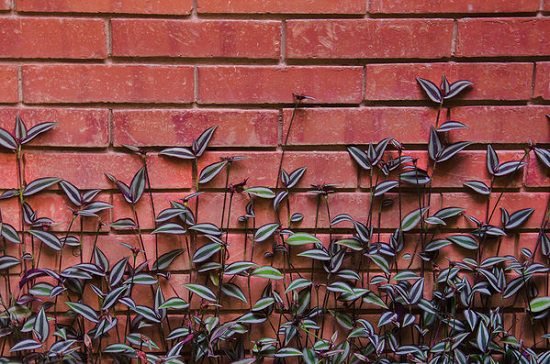
The variegated leaves resemble the stripes of the zebra, hence the name! The purplish-green foliage has a silver outer edge and white stripes running down lengthwise. It grows low to a height of 6-12 inches, and that’s why it can be grown as ground cover. It is one of the best types of wandering jew plants on the list.
3. Tradescantia pallida

It also goes by the name “Purple Heart” and is native to Mexico. Deep purple foliage, adorned with light purplish-pink flowers, looks marvelous and is the reason that it’s one of the most popular types of wandering jew plants! Apart from growing it as a striking ground cover, you can also have it in hanging baskets.
To know about more purple houseplants, click here !
4. tradescantia blossfeldiana.

Commonly known as the ‘Inch plant,’ it’s also referred to as Tradescantia cerinthoidebs . The thick green leaves have a fuzzy texture and a purple hue on the underside. You can easily propagate it from the cuttings, both in soil and water, once it gets growing. It bears delightful clusters of blue, purple, white, or rose pink flowers, making it one of the best types of wandering jew plants on the list.
5. Tradescantia Sillamontana

If precise geometric patterns are your thing, then you’ll love it because of its foliage. Growing from a thick succulent stem, the leaves are around two inches long and covered entirely in white hair. Magneta flower protrudes from the terminal end of the stem in summers.
6. Tradescantia spathacea
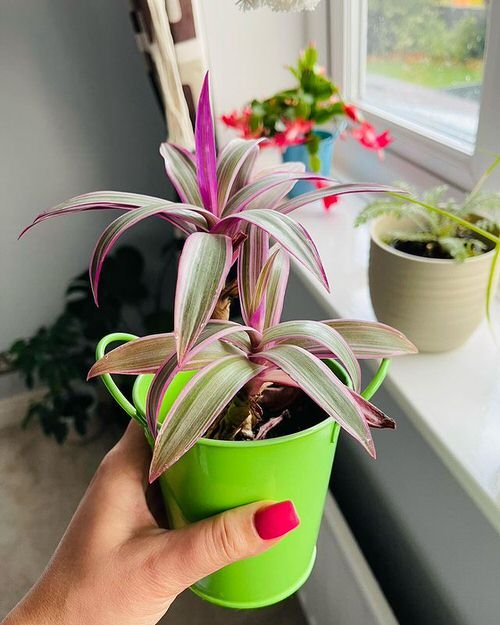
Known as Moses-in-a-basket, Oyster plant, or Boat lily, it is a sub-succulent herb from southern Mexico, Guatemala, and Belize. It grows in 6-12 inches long rosette and sword-like, narrow, and spiral-shaped dark green leaves, with purple bottom sides. The white flowers are enclosed with boat-like purple bracts, hence the name.
7. Tradescantia virginiana

Commonly known as the spider lily, it is a herbaceous perennial from the Commelinaceae family. The plant produces violet-purple to blue, three-petaled flowers, with yellow stamens and dark green arching leaves. You can grow this one of the most popular types of wandering jew plants under full to partial shade.
8. Tradescantia longipes
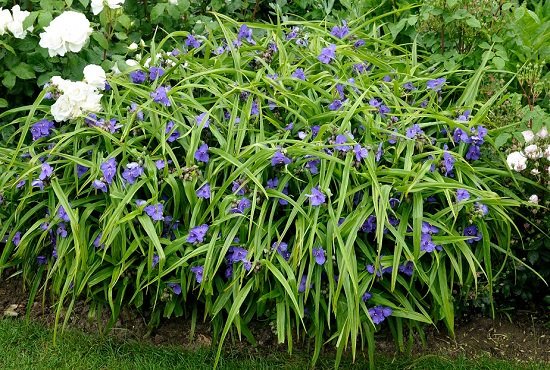
Adorn your garden by growing beautiful, purple-blue flowers of tradescantia longipes or spiderwort. It is native to Southern Missouri and northern Arkansas from the family Commelinaceae. Grow these three-petaled flowers for rock or naturalize gardens, in partial shade, by using well-drained, moist, acidic soil, making it one of the most popular types of wandering jew plants on the list!
Check out our article on indoor rock garden ideas here !
Wandering jew plant care tips.
- Grow a wandering jew plant in bright, indirect light or expose it to full sun, which it won’t mind either. Just keep in mind that low light can fade the markings on leaves.
- Water the plant directly around the roots, avoiding the crown, as it can result in rot.
- The plant prefers slightly moist soil, so maintain the right watering schedule.
- Use an all-purpose, water-soluble fertilizer, once a month, during the growing period.
Recent Posts
15 best plants you can grow in a 12-inch container, 34 beautiful mexican flowers you must grow, 11 indoor plant chandelier ideas, 7 great snake plant benefits proven in research & studies, feed this to your tomato seedlings and they’ll grow like crazy, 9 flowers with a lot of petals, 23 beautiful flowers that start with q, grow unlimited basil plants in one pot this way, join our 3 million followers:, related articles, 4 houseplants that remove carbon monoxide, 12 plants you can start with one cutting & a glass of water, 11 ways to train a wandering jew plant, 12 ways to grow zz plants in home and garden, how to propagate money tree | money tree propagation guide, how to flush plants without overwatering.
dO YOU NEED TO BRING A POTTED PLANT INDOORS DURING THE WINTER MONTHS?
Depends on the plant and where you live. Do research on the specific plant.
Sooooo number 4…. Is not a blossefeldiana. It’s a flumensis. …. You posted a tri-color-mundula variegata……. Not a nanouk. A nanouk is a blossefeldiana centerthoides
LEAVE A REPLY Cancel reply
Save my name, email, and website in this browser for the next time I comment.

Get the Best of BalconyGardenWeb Directly in your inbox.
POPULAR CATEGORY
- Best and Top of Gardening 1624
- Flowers & Blooms 673
- Growing Houseplants 601
- Gardening Guide 413
- Gardening Ideas 389
© 2023 Balcony Garden Web | All rights reserved
- Privacy Policy
- Terms of Service
- Feedback Page

7 Key Wandering Jew Plant Benefits & Why You Should Get One
May 30, 2023
Joe Trewick
If you want to learn about Wandering Jew plant benefits, then you’ve come to the right place.
Wandering Jews, also known as Wandering Dudes, Trad or Silver Inch plants, have a unique appearance and are quite easy to grow and propagate. They are not very expensive either and make a great addition to any plant collection either inside or outside.
In this article, we’ll explore the main types of Wandering Jew plants, as well as seven key benefits of these plants and some things you need to be aware of before purchasing one.
Disclaimer – The name Wandering Jew refers to an old legend from the 13th century about a mythical immortal man, but since that time it has been associated negatively with the events of WW2. For the sake of simplicity we will keep the original name for this article, but we are aware of the negative connotations involved.
Tradescantia Fluminensis
Tradescantia zebrina, tradescantia pallida, 1. aesthetic and decorative uses, 2. medicinal benefits, 3. air purification benefits, 4. easy to propagate, 5. easy care, 6. cheap to buy, 7. can be grown inside or outside, pets and wandering jew plant, invasive species concerns, types of wandering jew plant.
The Wandering Jew plant, also known as Tradescantia, consists of various attractive varieties, making it a popular houseplant choice.
In this section, we will explore three main types of Wandering Jew plants: Tradescantia fluminensis, Tradescantia zebrina, and Tradescantia pallida.
Tradescantia fluminensis, originating from South America, is commonly seen in homes and gardens in Central America, Mexico, Colombia, and Africa.
This variety has vibrant green foliage, which makes it a beautiful addition to both indoor and outdoor spaces. Its adaptability to various lighting conditions makes it suitable for beginners who want an easy-to-care-for houseplant.
Also known as the inch plant, Tradescantia zebrina is another popular variety of the Wandering Jew plant. Its striking silver and green striped leaves give it an eye-catching appearance, perfect for decorating indoor or outdoor spaces.
Native to Central America, this variety thrives in bright, indirect sunlight and can be grown as a trailing or cascading plant, offering versatility in between the landscape or container gardens.
Tradescantia pallida, commonly known as Purple Heart, is native to Mexico and is appreciated for its deep purple foliage. Adorned with light purplish-pink flowers, this plant is one of the most popular types of Wandering Jew plants.
Apart from growing it as a striking ground cover, you can also have it in hanging baskets . This stunning variety is well-suited for both indoor and outdoor cultivation, providing a rich contrast to other green plants in your collection.
These three varieties of Wandering Jew plants, each with their unique characteristics, provide a diverse range of options for enthusiasts to explore. Whether grown indoors or outdoors, these plants are sure to bring beauty and interest to any space.
7 Wandering Jew Plant Benefits
The Wandering Jew Plant offers a range of benefits and uses, making it a popular choice for many garden enthusiasts and houseplant lovers.
Here are the 7 most important benefits to consider:
The Wandering Jew Plant is known for its attractive foliage, which features distinctive stripes and a rich color palette.
The plant’s trailing vines make it an ideal choice for hanging baskets , creating a unique and eye-catching addition to any indoor space. Furthermore, the plant’s delicate flowers add a touch of beauty to any room.
While not widely known, the Wandering Jew Plant has some potential medicinal benefits.
Traditionally, it has been used in some cultures to alleviate inflammation and aid in antioxidant support .
However, further research is needed to confirm these uses and determine potential side effects.
Wandering Jew Plants can contribute to improving the air quality in your home.
Researchers found that Tradescantia pallida specifically exhibited superior abilities to remove VOCs from the air.
One of the major benefits of Wandering Jew Plants is their ease of propagation. This plant can be easily propagated by taking stem cuttings and planting them in soil or water.
This process enables the rapid growth of new plants, making it an efficient and affordable way to expand your garden or share the plant with friends.
The Wandering Jew Plant is known for its low-maintenance nature. It thrives in a variety of conditions, making it a great option for those who have limited experience with plant care.

The plant does best in a consistent temperature range and responds well to moderate watering.
Wandering Jew Plants are relatively inexpensive compared to other houseplants, making them an accessible choice for people on a budget.
Their affordability, coupled with their aesthetic appeal and easy care, has contributed to the Wandering Jew Plant’s popularity in both indoor and outdoor gardening settings.
The last key benefit we’ll cover is that Wandering Jew plants can be grown indoors or outdoors, depending on the climate where you live. It will thrive in USDA growing zones 9-11
Whether you’re sprucing up your front porch or looking for a new office plant, the Wandering Jew plant is a great, flexible option.
Things To Know About Wandering Jew Plants
Although there are a lot of Wandering Jew Plant benefits, there are some important things to know about this plant before you get one.
Wandering Jew Plants can pose certain risks to pets, particularly cats and dogs. The sap present in the plant may cause skin irritation in humans and, if ingested, can be moderately toxic to animals.
Common symptoms in pets that have ingested the plant are vomiting, diarrhea, and increased salivation. It is crucial to keep the Wandering Jew Plant out of reach of pets to mitigate potential health risks.
Wandering Jew plants are known for their rapid growth and adaptability to different environments. As a result, they can easily become invasive species, potentially harming local ecosystems.
The plant thrives in various climates, including USDA growing zones 9-11 . If it starts growing uncontrollably in a non-native habitat, it can outcompete native plants by disrupting soil quality and established plant communities.
In places like Florida and South Africa , Wandering Jew Plants are listed as invasive, and you are not allowed to grow them.
When planting Wandering Jew in your garden or outdoor space, it is essential to monitor its growth and take necessary measures to prevent its spread into neighboring areas.
You should also research your particular area to see whether you are allowed to grow them there or not.
There are a lot of Wandering Jew Benefits, and you should definitely consider adding this plant to your collection either indoors or outdoors.
Always check that the species isn’t invasive in your area and you should have no problem growing this plant as long as the conditions are suited for it.
Hi, I'm Joe! I'm the head of SEO and content management at Bloom and Bumble. I'm a huge plant lover and over the years my home has become more like an indoor rainforest. It has taken a lot of trial and error to keep my plants healthy and so I'm here to share my knowledge to the rest of the world.
Leave a Comment Cancel reply
Save my name, email, and website in this browser for the next time I comment.
Houseplants outdoor plants bees about us contact us
© bloom&Bumble

Wandering Jew Plant – Ultimate Care Guide
By: Author Daniel
Posted on Last updated: September 18, 2023

Sharing is caring!
- Facebook 60
You are reading this guide to learn more about the Wandering Jew Plant and its care . I have had this plant at home for many years and write about all the growing aspects in this guide.
Wandering Jew Plant Care Takeaways
What is the wandering jew plant.
The Wandering Jew, or Tradescantia zebrina, by its scientific name (old name = Zebrina pendula) is native to Mexico. It is not to be confused with Tradescantia albiflora, which also goes by Wandering Jew and has very similar care needs.
Tradescantia zebrina has attractive foliage, sporting exciting zebra-patterned leaves. It also flowers. But when kept as a houseplant, this rarely ever happens. It is a fast-growing and excellent groundcover, according to the University of Florida .

W andering Jew Plant Care
To keep your Wandering Jew plant thriving, ensure it receives bright, indirect sunlight. Keep it in average room temperatures of 60-75°F (16-24°C). Fertilize once a month during spring and summer. In winter, relocate the plant to a cooler area with temperatures of 54-59°F (12-15°C).
Table of Contents
Tradescantia zebrina Growing guide
Tradescantia zebrina care is pretty straightforward, but it certainly can’t hurt to glance at the most important things to consider when caring about this herbaceous perennial plant.
So, without further ado, let’s see how you can make your Wandering Jew, aka the Inch plant, as happy as possible.
Any good potting soil will do for your Wandering Jew. For instance, this could be Miracle Gro potting soil readily available online in stores like Amazon.
But these plants not only feel very comfortable in soil but can also be kept in hydroponics .
Sunlight is a vital aspect when it comes to the well-being of most houseplants. Some houseplants do well with moderate sunlight, while others only thrive (or flower) when a certain level of sunlight is guaranteed.
The Wandering Jew does best in bright, indirect sunlight .
If you are unsure what that means, please look at our Light Levels article.
The Wandering Jew, a tropical native, thrives best when the root ball is always well moisturized. Still, waterlogging should be avoided whenever possible, as this could lead to root rot .

This tropical plant does not enjoy limy water. Use soft water whenever possible. Rainwater and distilled water are very good choices.
Temperature
People who own an Inch plant and keep it outside run the risk of exposing it to cold temperatures. This is where indoor plant owners have the upper hand.
Wandering Jews can thrive with average room temperatures of 60 to 75°F (16 to 24°C) if it doesn’t drop for long periods. Anything below 12°C for an extended period could be fatal for your Wandering Jew.
Wandering Jews prefer a humidity of around 70%
The perennial, herbaceous Wandering Jew plant is native to Mexico, Central America, and Colombia, so it should not surprise you that it likes a good deal of humidity.
To ensure high humidity levels, regularly misting your plant is a very good idea. A hand mister filled with water does the trick.
As for the location, you may want to keep your Wandering Jew in the bathroom , as this is usually the place in the house with the highest humidity.
Feed your plant once a month during spring and summer. In winter, fertilizing is not necessary.
Also, fertilization of the Wandering Jew is only necessary from the second year of cultivation or after repotting.
Propagation
It is best propagated through stem tip cuttings. Propagating the Wandering Jew is an easy task.
Wandering Jews don’t get very tall. They might reach a height of about 14 inches (36 cm) when kept indoors. They spread to about 10 inches (25 cm).
(Re)potting
The thing with the Wandering Jew is that it grows fast , hence its nickname “Inch plant.” Because of its fast-growing pace, the plant usually gets very leggy, and leaves are often lost near the base of the plant.
Repotting is pivotal for keeping the root system healthy regardless of the actual plant species. However, how often a houseplant needs to be repotted depends on various factors.
Some houseplants grow incredibly fast, so they need to be repotted often. Others, on the other hand, grow very slowly, so repotting is not a top priority.
That said, repotting your Wandering Jew occasionally is a good idea.
How long does a Wandering Jew live?
As far as the longevity of Wandering Jews goes, they often don’t get older than 2 to 3 years.

Wandering Jew Watering
Water about once every 5-7 days in spring and summer. Keep the soil slightly humid. Do not let the Wandering Jew dry out between waterings. Use your index finger to check if the soil is dry down 1-2 inches of soil (2.5 – 5 cm).
Reduce watering to every 10-14 days in autumn and winter.
Wandering Jew Propagation
The Wandering Jew roots very easily . The plant can easily be propagated through stem tip cuttings.
When propagating your Wandering Jew, make sure that your plant is in a healthy condition.
Please follow our step-to-step guide to propagate your Wandering Jew through stem tip cuttings.
Propagation through stem tip cuttings
- Identify the plant that you want to replicate. It should have healthy growth and plenty of stems.
- Make clean cuts on sections that are three to six inches in length .
- Use a sharp knife and carefully cut the leaves on the stem’s bottom half.
- If you want, you can dip the exposed end of the stem in a rooting hormone . This will speed up the rooting process. However , it is unnecessary .
- Place your stem tip cuttings into a pot with fresh soil after thoroughly watering the potting mixture.
- Use a clear plastic bag to hold in moisture, taking it off to water weekly .
- Keep your eyes on the plant for new growth . You should start to see roots in about two to three weeks . Once this happens, transfer the plant babies to a larger pot.
Note: Instead of rooting your stem tip cuttings directly in soil, you could also root them in water .
Wandering Jew Pest Control
Wandering Jews are prone to aphids and spider mites attacks. So, you will need to look out for these two little pests.
Some of these are known to cause defoliation, while others can kill the plant altogether. Depending on the severity of the infestation, you may need to use chemicals or insecticides .
Aphids on my Inch Plant
The Wandering Jew is not particularly susceptible to plant diseases or pests. Yet, you might have to deal with an aphid attack at some point. These parasites pierce the leaves of their host plant and suck their sap.
Like scale insects, they excrete sticky honeydew, by which you can immediately recognize the infestation.
Aphids can multiply explosively, especially in warm , dry environments.
As a preventive measure, ensure regular watering and occasional misting of your Wandering Jew.
The best way to combat aphids is to control them mechanically by rinsing them off the plant with water . Isolate the plant from the rest of the collection.
Pest Prevention
To prevent the Wandering Jew from pest infestations, plucking dried leaves regularly makes sense as well as using neem oil. The dried leaves lying on the substrate must be removed. Otherwise, there is a risk of rotting or infestation by parasites and fungi .
Wandering Jew Problems
Brown leaf tips.
Brown leaf tips is a very common problem with a wide variety of houseplant. Depending on the species, the causes for this problem can be very different, though.
So what causes leaves to turn brown with Wandering Jews?
My Wandering Jew has only green leaves (not enough variegation)
If you do own a variegated Wandering Jew but only see a great amount of non-variegated leaves, chances are that your plant does not get enough sunlight .
To solve the problem, allow your Wandering Jew some bright, indirect sunlight by placing it in a sunnier location.
Fading leaves
If your inch plant’s foliage is suddenly losing color and sports fading leaves, this is another sign that it does not get enough sunlight .
Dropping leaves
Dropping leaves is another very common problem many plant parents must deal with regularly . If your Wandering Jew drops leaves, this is usually due to too low or too high temperatures .
In summer , ensure your Wandering Jew is exposed to average room temperatures.
In winter , it should be kept in a cooler environment.
Is Wandering Jew care difficult?
Wandering Jews are considered low-maintenance plants and are perfectly suitable for beginners.
They do well at average room temperatures, don’t demand a very high level of humidity (which is sometimes difficult to achieve in a home environment), and it is very easy to propagate them through stem tip cuttings.
Which plant species are commonly referred to as “Wandering Jew”?
Tradescantia zebrina as well as Tradescantia albiflora.
What is the difference between Tradescantia zebrina and Zebrina pendula?
There is no difference between Tradescantia zebrina and Zebrina pendula. Zebrina pendula is just the old name for Tradescantia zebrina.
Does my Wandering Jew flower at all?
Wandering Jews are indeed flowering plants. However, when kept indoors, they very rarely flower.
How long can you keep a Wandering Jew?
If you don’t propagate your Wandering Jew, you can keep it for about three years. After that period, the quality of your Wandering Jew will most likely decrease. If you regularly propagate your leafy friend through stem tip cuttings, you can keep it indefinitely.
Any display tips for Wandering Jews?
Wandering Jews look great in hanging planters!
Is the Wandering Jew toxic to cats?
The Wandering Jew plant is toxic to cats. Therefore, you have to keep your cat away from this plant.
Is the Wandering Jew toxic to dogs?
Yes, the Wandering Jew plant is toxic to dogs. Therefore, you must ensure your dog does not come in contact with this plant.
What are the health benefits of Tradescantia zebrina, if any?
Not only is The Wandering Jew a beautiful houseplant famous for its striking foliage, but it also presents several health benefits for humans. It is especially known for its antioxidant and antibacterial activity, and it is widely used in Traditional Medicine in several countries. Tradescantia zebrina is also believed to be a valuable source for treating kidney diseases.
The Last Zebrina
The Wandering Jew is a great houseplant that looks stunning in hanging planters. Its care is easy apart from its humidity-loving nature.

Daniel has been a plant enthusiast for over 20 years. He owns hundreds of houseplants and prepares for the chili growing seasons yearly with great anticipation. His favorite plants are plant species in the Araceae family, such as Monstera, Philodendron, and Anthurium. He also loves gardening and is growing hot peppers, tomatoes, and many more vegetables.
Related Posts
(image credits, IG:oohyouplantsy) I have a hide-away in my home that I escape to for…
How much light does my plant need? This is a relevant question as too little…
I love plants that offer an eye-catching burst of color. They sure put a smile…
Most of the 45+ species in the Monstera genus are famous for their unusual leaves…
One of the rarest Anthuriums is the Anthurium Reflexinervium, a gorgeous plant naturally found only…
Hoya Lauterbachii belongs to Hoyas's family, which are known to be the largest plants on…
AMERICAN GARDENER
Climate Change Is Real, Take Action
10 Major Varieties of Wandering Jew (With Pictures)
Tradescantia is a creeping, succulent, multi-branching perennial herb that can form a dense ground cover and root freely at nodes. Alternate, lanceolate shaped leaves have parallel veins that are either green or tinged with purple. Leaves are also somewhat pubescent. Leaf blades arise from short, closed sheaths and are 2 inches long and 0.75 inches wide. Some are glabrous or have ciliate margins. Flowers are white, in small clusters at stem tips. Fruits are small, 3-parted capsules containing black, pitted seeds.
Tradescantia will invade disturbed areas, natural forests, riparian zones, urban areas, hammocks, and wetlands. The growth habit of wandering Jew is such that it will form a dense groundcover and smother the native groundcover and seedlings. Once established, Tradescantia is difficult to control.
Plants in the genus Tradescantia have until recently been commonly known as ‘Wandering Jew’. This name is no longer used by the horticultural world due to its historical use in supporting antisemitic stereotypes.
Tradescantia palladia
Tradescantia flumenisis, tradescantia zebrina.
- Tradescantia blossfeldiana
Tradescantia spathacea
Tradescantia virginiana.
- Tradescantia Sillamontana
Tradescantia longipes
- Tradescantia navicularis
Tradescantia Nanouk
- Tradescantia hirsuticaulis
Tradescantia subaspera
Tradescantia ohiensis.
Tradescantia pallida ‘Purple Heart’ is a tender perennial commonly used as a houseplant or an annual. Dark purple, lance-shaped leaves up to 7” long are produced alternately on fleshy stems. The fleshy leaves are covered with pale hairs and form a sheath around the stem. The stems are quite fragile, and break off easily if brushed or kicked too hard. In colder areas it will die back to the ground in winter, but comes back from the roots in spring. The rambling plants get about a foot high but can spread much wider. From midsummer through fall, and sporadically at other times, relatively inconspicuous pink or pale purple flowers with bright yellow stamens are produced at the ends of the stems.
Tradescantia flumenisis is trailing perennial with succulent stems, rooting readily at nodes. Forms a carpet up to 50cm thick. Alternate leaves 3-6 cm long, ovate-elliptic, shining and loosely clasping the stem. Leaves are typically dark green, but can have longitudinal stripes and/or purplish bases, these forms typically revert to green. The flowers are in clusters, are star-shaped and have 3 delicate white petals that are 10mm long.
Also Read: Different Types of Ground Covers
Tradescantia zebrina, formerly known as Zebrina pendula, is a species of creeping plant in the Tradescantia genus. This creeping plant makes a good groundcover 6-12” high. It has succulent stems with ovate to lanceolate leaves clasping the stem. The upper leaf surface is green to purple with two wide, silvery-white stripes, while the lower leaf surface is a uniform deep magenta. If you look closely you can see the fine hairs along the leaf margins and may note that the surfaces seem to sparkle in bright light. In low light conditions, stems lose lower leaves and the leaves lose much of their coloring. The stems will branch or root at the nodes and ascend at the flowering tips. The stems break easily at the nodes.
Tradescantia Blossfeldiana
Tradescantia Blossfeldiana is an evergreen, clump-forming perennial. It has a short stem that bears a rosette of fleshy, lance-shaped glossy green leaves with purple undersides. Flowers have 3 triangular petals, and are blue, purple, rose-pink or white.It can grow in a range of soil and pH conditions, however, prefers well-drained acidic, loamy soils. Pinching the tips back will promote a more bushy habit. It can take on a trailing habit if the tips are not pinched. This wandering Jew species can be found in moist prairies, fertile woodlands, open woods, meadows, hillsides, stony bluffs, stream banks, and along roadsides.
Tradescantia spathacea, the oyster plant, boatlily or Moses-in-the-cradle is a clump-forming evergreen widely cultivated in tropical areas because of its attractive foliage. It typically grows as a 6-12 feet tall with rosette consisting of narrow, spirally arranged, linear-lanceolate, stiffly-ascending, sword-shaped, dark green leaves with purple undersides. This Plant spreads to form a dense ground cover over time. White flowers in axillary cymes are enclosed by long-lasting, boat-shaped, purple bracts, hence the common name of Moses-in-a-basket. Flowers bloom throughout the year. Flowers are followed by fruit. This plant is easily grown indoors in pots or containers.
Also Read: Different Types of Pothos
Tradescantia Virginians plant is up to 2½ feet tall and unbranched, except for 1 or 2 small side stems near the inflorescence. The central stem is round and glabrous, although scattered long hairs may occur where the leaves wrap around the stems, or a little below. The leaves are dark green or olive green, up to 12 inch long and 1 inch across, with parallel venation and smooth margins. They are linear to broadly linear, but wider at the base and narrowing to a pointed tip. In spring the 3-petaled flowers appear and last for a day but new ones are produced daily in terminal clusters. Flower colors range from blue to purple to pink. Once they have finished blooming cut back the stems. The foliage may die back in the heat of the summer but returns in late summer to fall and often reblooms. The plants spread by underground stolons forming clumps and grow 2-3 feet tall by 1 foot wide.
Tradescantia sillamontana
Tradescantia sillamontana commonly known by the names Cobweb Spiderwort and White Velvet is a low-growing plant with an upright habit. It grows between 12 and 18 inches in height. The leaves are a dull olive to gray-green color, sometimes blushed purple but the leaves and new stems are so heavily covered with cobwebby silver-white hairs that the plant appears quite silver. In summer appear the single magenta flowers with three petals that are crowded into the terminal leaf axils. It makes a wonderful garden plant as an accent, small scale groundcover or a container specimen and is compatible with succulents and other dry growing plants and with a little shade is also a pretty interesting hanging basket plant.
Tradescantia longipes, commonly known as the wild crocus , is a spring blooming species. This tradescantia can be trailing or tufted perennials with usually fleshy, evergreen foliage and distinctive, 3-petalled flowers, often pink-or purple-tinged.The plant typically prefers habitat of wooded slopes on rocky hillsides. While most other members of the genus Tradescantia have stems reaching at least a few inches above the soil, the flowering shoots of Tradescantia longipes are borne essentially at ground level.
Also Read: Different Types of Cosmos Flowers
Tradescantia Nanouk, also known as Fantasy Venice, is a newer cultivar that was created by cross-pollinating seedlings from tradescantia albiflora. This designer plant was created in a lab in 2012 in the Netherlands. Those who developed it hoped to create a tradescantia variety that was more compact, with beautiful flowers, and—of course—the stunning variegated colors. The tradescantia nanouk is known for this gorgeous variegation. The foliage on the plants are a mix of light green, light purple, and cream. The purple is much more of a purple than the pinkish color on the leaves of the fluminensis tricolour and callisia repens. While it’s the new it’s not a difficult plant. In fact, it’s one of the easiest houseplants to care for, which makes it a great choice for beginners.
Tradescantia ohiensis is a clump-forming spiderwort with purple to rose-blue, 3-petaled flowers. It can be found growing in meadows, along roads and woodland margins. Each flower blooms for a single day, typically opening in the morning. Its grass-like leaves are long with a lengthwise fold or groove. It can be grown in shade, however, the blooms will not be as profuse as when placed in full sun. Will also grow in a variety of soils, but will be at its best when located in moist, sandy soil.
Tradescantia subaspera can be a perennial herb, houseplant or interiorscape plant. The leaves are alternate and clasp at the base. They are simple, long and grass-like. Secondary stems and leaves can occasionally develop from the axils of the primary leaves. The fuzzy leaves have prominent parallel veins, looking similar to the leaf of a corn stalk. Growing in the wild, its natural habitats include deciduous woodlands and borders, along ravines, bases of bluffs and along shady streams. Its common name, Zigzag Spiderwort, come from the appearance of its stem. The stem makes slight direction changes at the leaf nodes in the half of the plant. Wideleaf Spiderwort has wider leaves than most of those in this species.
Further References
- Facts About Wandering Jew: https://en.m.wikipedia.org/wiki/Wandering_Jew
- Growing Inch Plant: https://www.gardeningknowhow.com/houseplants/wandering-jew/growing-wandering-jew-plants.htm
- Wandering Jew : https://www.britannica.com/topic/wandering-Jew
- Skip to primary navigation
- Skip to main content
- Skip to primary sidebar
Houseplant Addicts
A place to realize our addiction is real & relatable
History of the Tradescantia Plant
Staff 3 Comments
Collaboration: Hannah and Jessica
Most Houseplant Addicts are familiar with the popular and well-known Tradescantia genus of plants . It is a beautiful trailing group of plants that spread easily, come in many textures, colors and take little care to thrive. They go by many names; Inch Plant , Speedy Jenny, Spiderwort and more! But most likely you know these popular plants by their controversial common name “ Wandering Jew “.

Do you know where this plants common name comes from? We thought we did! But the truth is, we only knew a small portion of the folklore and history behind this name.
It is because of those of you, in our wonderfully kind and inclusive Houseplant Addict community, who reached out to us about this subject that made us stop and take the time to educate ourselves – and we are so glad we did! Now we’d like to help educate others too. The history behind this name goes much deeper than we could have possibly imagined and today we’d like to dive deeper with you all into the origins of this common name.
Tradescantia are a genus of roughly 75 species of herbaceous wildflowers in the family Commelinaceae . These trailing/climbing plants grow up to 9″ inches tall and when planted in the ground will spread indefinitely if conditions are right. They come in a wide range of colors from green to purple to an iridescent silver.

Technically speaking only three species within the Tradescantia genus that carry the common name. These include tradescantia fluminensis, tradescantia zebrina, and tradescantia pallida. The most popular and most common being tradescantia zebrina; named for it’s silvery stripes that adorn dark-green foliage providing striking contrast to it’s white three-petal flowers .
There are a few theories on where the plant acquired the common name, though when the plant acquired this nickname is virtually unknown but the common name seems to have gained popularity sometime in the 1950’s to the 1970’s.
“Gardeners would share cuttings from their WJ houseplant with neighbors and friends and like the Jews from long ago, the WJ houseplant would travel from place to place,” – Growing WJ Plants – gardeningknowhow.com
The above quote is one popular theory often cited by plant lovers as the creation of this common name but it is more likely that the plant gets it’s name from an early Christian folklore tale.
In this tale a Jewish man taunts Jesus on his way to Golgotha. In turn Jesus curses him and dooms the man to walk the Earth until the second coming of Christ. These plants were likely nicknamed after this wanderer due to plants long and seemingly endless lifespan.
But hang on! That isn’t where this story ends, that is just the beginning. There is a lot more to the story behind this character and we owe it to our Jewish friends and neighbors to look into the long history behind this character.
History and Folklore
The tale of the wanderer character has been retold many times throughout modern history. It is often believed that the earliest version of this tale can be found in the Englishman Roger of Wendover’s “ Flores Historiarum” (c. 1228) , in which upon meeting the archbishop from Armenia who told him the following story:
Cartaphilus, a porter of the hall in [Pontius] Pilate’s service, as Jesus was going out of the door, impiously struck him on the back with his hand and said in mockery, ‘Go quicker, Jesus, go quicker! Why do you loiter?’ And Jesus, looking back on him with a severe countenance, said to him, ‘I am going, and you will wait till I return.’ And according as our Lord said, this Cartaphilus is still awaiting his return. At the time of our Lord’s suffering he was 30 years old, and when he attains the age of a hundred years, he always returns to the same age as he was when our Lord suffered.He is a man of holy conversation and religious, a man of few words and circumspect in his behavior, for he does not speak at all unless when questioned by the bishops and religious men; and then he tells of the events of old times and of the events which occurred at the suffering and resurrection of our Lord. Englishman Roger of Wendover’s “ Flores Historiarum” (c. 1228)
In the bible ( John 18:20–22 ) we see a reference to an officer who struck Jesus at his arraignment before Annas. Often this is cited as the basis for the legend.

The appearance of the character shows up as early as the 13 th century in stories and literature. He is first used in Medieval stories to show anti-Jewish hostility. People continued to use his story for oral traditions into the 15 th century, where they state the man repented his sins and converted to Christianity to wait out his sentence.
It wasn’t until the 17 th century that the story ( the character of the WJ has no given name in most folklore; but in others, he’s called Cartaphilus, Malchus, or Ahasuerus ) was used primarily to spread hatred of the Jewish people. We will go into more detail on this in the next section.
In The Media
Early in the 17 th century we see that Germany adopted the story of this character into their pamphlets and literature to highlight the anti-Jewish implications of the story. We see this as early as 1602, in the pamphlet ‘ Kurtze Beschreibung und Erzehlung von einem Juden mit Namen Ahasverus, welcher bey der Creutzigung Christi selbst Persbn-lich gewesen : auch das “Crucifige” uber Christum hab helfen schreyen, etc ‘ where a man stands outside a church barefooted and thread bare. He hangs his head, beats his breast and sighs mournfully at the mention of Jesus’ name. This is the first appearance of the character as Ahasuerus whom the Germans nicknamed The Eternal Jew .

In 1940 we see the character resurface in a Nazi propaganda film , presented falsely as a documentary by the Nazi administration, called Der ewige Jude which translates into the The Eternal Jew . This propaganda film was released during the height of the Nazi occupation of Poland and was directed by Fritz Hippler and commissioned by the Nazi Germany’s Minister of Propaganda, Joseph Goebbels.
In the film Jewish peoples are portrayed as uncivilized and barbaric with low social standing. As with most propaganda, the various locations we see in the film are intentionally chosen to manipulate the viewer into the creators way of thinking.
The film shows dirty ghettos throughout Poland, often covered in grime and infested by rats – a common metaphor used by the Nazi party when describing the Jewish people. Unfortunately, the propaganda film worked in making the german people believe that the Jews chose to live this way rather than the truth which was that these living conditions were caused and created by the Nazi administration and their assault on the lives of millions of Polish Jews.
Throughout history, this character has been used in more than 100 folktales around the world. The Ukrainian people converted it to a story about the moon. In Westphalia, they tell of a man who can only rest for the time it takes to eat a small morsel of bread. The Danes and Swedes tell of a man who can only rest on a plow share.
We can find more traces of the character in Geoffrey Chaucer’s Pardoner’s Tale (1387) , which features a man whose unending existence shares a close resemblance. Centuries later, the character surfaces again in Matthew Lewis’ The Monk (1796) where the character appears from nowhere to tame the ghostly Bleeding Nun.
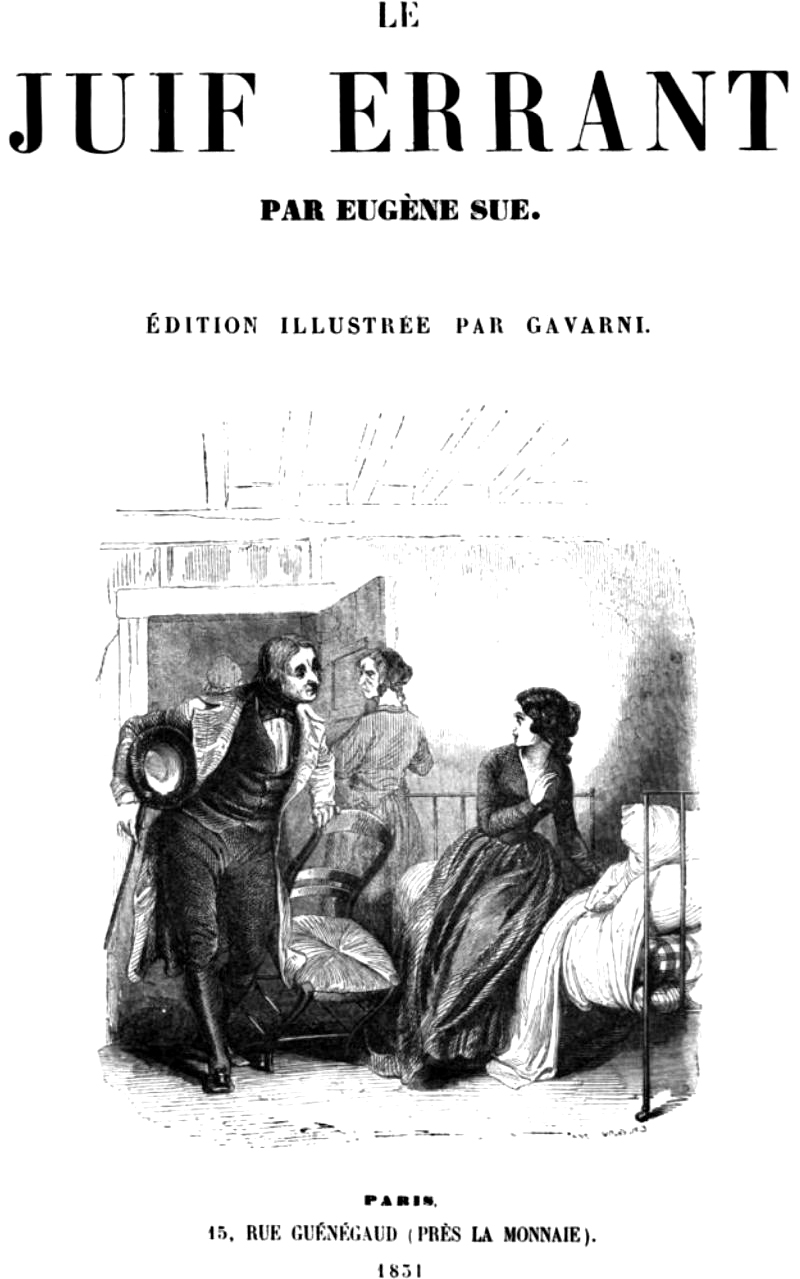
The WJ theme continued to spread across the world in poems and literature, where it became most popular in the 17 th and 18 th century. In the 19 th century Mark Twain writes about it in The Innocents Abroad (1869) and French author Eugene Sue writes Le Juif errant (1844) ( translation ‘The WJ’ ), where she used the character as a cautionary tale that shows famine, storms and epidemics that follow in the wanderers wake.
These are just a few of many examples of the tale spread throughout literature. Many Jewish authors, composers and play-writes such as Jaroslav Vrcblicky and Abraham Goldfaden also write about this character. Edmond Fleg in 1933 even uses the character to narrate Jesus’ biography .
Throughout history, the tale has been modified, reworked and adapted to fit many different cultures. Though some groups such the Nazi’s used the character to fuel hatred and spread propaganda, other groups chose to write him as inspiring and unrelenting to weave tales of understanding, blessings and redemption.
Too often we see things that are twisted and used to fit personal or political agenda and belief – and more often than not this is a harmful act. When this happens we cannot simply ignore the new problematic ideals that have been attached by those with nefarious intentions. We must change.
How we view the use of this common name and our reactions to it, will always be different than those of our neighbors but we hope that in sharing this history with you that you will think carefully on it’s origins, its effect on those around you and how it may make those in our Jewish community feel and choose to use another name.
Ask ing the Community
“Given the persistence of anti-Jewish sentiment and hateful / violent acts directed at the Jewish people, I have to that I hope the name will be retired and replaced. I am deeply proud of my Jewish heritage, which includes many long exiles during which we have maintained our faith and traditions. I would like to a believe a better and more positive name could be found.”
By: Rabbi Shalom Bochner
“There is a plant which bears the name WJ because it has a tendency to spread. The name was probably given without conscious anti semitic malice. There is also a bird called WJ, and even a card game and a game of dice.
However, in Christian legend there is certainly a mythical figure called the WJ who embodies anti-Jewish animus. The underlying notion is that the Jews are destined to wander and be reviled because they rejected Jesus.
The story takes many forms and its origin is likely to have had little if any specific connection with Jews. Not until the 13th century did it become a clearly anti semitic legend, often linked with the tradition that an officer of the high priesthood struck Jesus on the way to the cross and Jesus condemned him to suffer punishment until the so-called second coming (“You will go on forever until I return” is what Jesus is said to have told him).
The WJ is said to be called Ahasuerus, the same name as the Persian king in the story of Mordechai and Esther. The legend says that the Ahasuerus who struck Jesus was a Jerusalem shoemaker.
Centuries of anti-Jewish prejudice inexorably conditioned Christian communities to see the Jew as a pathetic sinner doomed by his rejection of Jesus.
The WJ was given different names in different versions of the story and became the central character in a sheaf of poems, novels and artistic and musical works, though the tragedy of the Holocaust has largely discredited the notion.
However, some fundamentalist Christian circles who hang on to the story find it hard to come to terms with the vitality, dignity and creativity of the Jewish people and the vibrancy of the State of Israel.”
By: Rabbi Raymond Apple AO RFD
“We greatly appreciate you reaching out to better educate yourself and your group. Yes the term is offensive and people should refer to the plant by a different name.”
By: Adam Chaskin – Jewish Community Alliance
“Any botanist will tell you that the WJ is a unique species of plant which – when given minimal sustenance – will nevertheless spread and grow. Similarly, if you cut out its roots and plant it in other soil , it will regenerate itself and start anew.
This plant’s nomenclature is, of course, a comment on the Jewish People’s ability to adapt to varied environments and conditions. “Wandering” is what Jewish history has been all about. The Patriarchs and Matriarchs were nomads. The Jewish nation itself was forged in Egypt and while wandering through the Sinai desert – the only nation ever to establish its identity while wandering outside its homeland. And for the past 2000 years we have been wandering the world.” Read More..
By: Rabbi Yehuda Appe
Conclusions
We hope this article has provided some insight as to the history behind the Tradescantia genus’ common name and helped you understand why the name causes discomfort and pain for many people. We would like to ask that, out of respect for your fellow members, you use one of the many other names for this plant including but not limited to; tradescantia [variety here], wandering dude, inchplant, spiderwort, speedy jenny and so on .
While we cannot force you to use these alternate names outside of our community, please understand that these alternate names are the Houseplant Addicts networks preferred terminology. If you continue to use this term now knowing the history behind it and the pain it causes many people then you will be removed or banned without notice to you.
We hope you will take the time to listen to your fellow Houseplant Addicts, have civil discussions with each other and we hope that if you have further questions about the history of this common name that you will take the time to look through the many resources we provided, self-educate and reach out to your local Jewish communities as we have.
We’d also like to remind our members that sometimes those who use this term are not using it with ill-intent, but they just do not know better. When that is the case, we hope that you will take the time to share this article and help educate them so we can all thrive together.
Please note* the use of the WJ term in this blog article is for educational, historical and discussion purposes ONLY.
More Reading:
- The Wandering Jew (Sue novel) , an 1844 novel by Eugène Sue
- Le Juif errant (opera) , an 1852 opera by Fromental Halévy, loosely inspired by Sue’s novel
- The Wandering Jew (Heym novel) , 1981
- The Wandering Jew (1923 film) , British silent fantasy film
- The Wandering Jew (1933 film) , British fantasy drama film
- “The Wandering Jew” (ballad) , a 17th-century English “broadside Ballad”
- The Eternal Jew (1940 film) , a Nazi propaganda film
- The International Jew , 1920s anti-Semitic writings authored by Henry Ford
- The Jewish Encyclopedia – Wandering Jew
- THE WANDERING IMAGE: CONVERTING THE WANDERING JEW by Joanna L. Brichetto
- Collections historical texts and references to The Wandering Jew
- The Wandering Jew in English Lit. to 1850 by Samuel Gene Andrews
- THE WANDERING JEW — A JEWISH PERSPECTIVE Published By: World Union of Jewish Studies

Share this:
Reader interactions.
In Hungary, Tradescantias are called ‘gossip’ because how they spread like a rumor.
I feel that is a great name for this plant
Leave a Reply Cancel reply
Your email address will not be published. Required fields are marked *
Save my name, email, and website in this browser for the next time I comment.
This site uses Akismet to reduce spam. Learn how your comment data is processed .
Where The Naked Man Orchid Plant Got Its Cheeky Nickname (& Where To Grow Them)
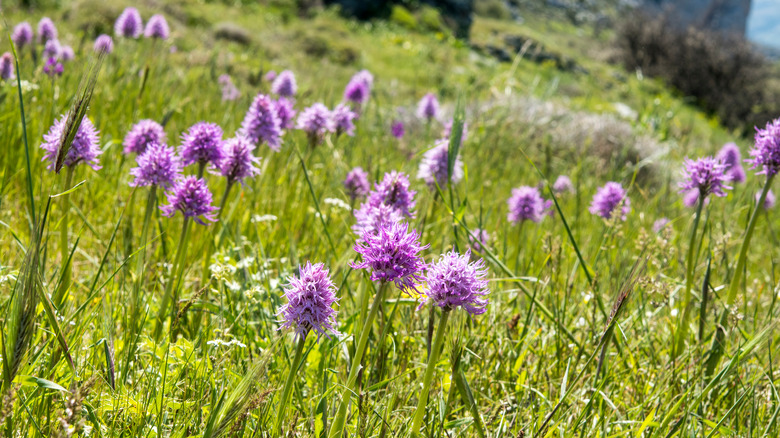
If you've ever studied the plants in your garden or during a nature walk, at some point you've probably paused on a plant and thought, "Wow, that looks ... interesting." Sometimes nature has a sense of humor, and there's no shortage of funny-looking plants in the world, but the naked man orchid might take the cake for its ability to make us giggle. Orchis italica is also called the Italian orchid, but it's frequently described as the naked man orchid or hanging man orchid. A closer look at these beautiful blooms may reveal exactly where the name comes from; each flower head is decorated by rows of petals, each resembling a tiny person — and more specifically, a male person — with two arms, two legs, two little eyes, and a certain male appendage.
The naked man orchid is a sight sought after by many botanists and plant enthusiasts, but even for the average person, the idea of little nude creatures sprouting up from the ground sounds like something out of a fantasy novel. Add to that, the naked man orchid is grown for culinary and medicinal benefits. Some might be tempted to bring this plant home as a fun, chuckle-worthy garden statement, but acquiring and growing this delicate orchid can be complicated. Here's what you need to know about the naked man orchid and everything you should know before planting this quirky flower.
This orchid is a mirthful Mediterranean native
Orchis italica is native to the Mediterranean region and parts of the Eastern Europe, where it grows in patches across meadows, rocky coastlines, and woodland borders in somewhat chalky and alkaline soil. The mature plant reaches about 18 inches in height, with blooms that emerge in spring in varying shades of pink. Rarely, white blooms can also appear. The flowerheads look like clusters of tiny dangling men, each like a little paper doll hanging by his hat. This isn't the only flower known to produce remarkably humanoid petals; it shares a genus with the monkey orchid (O. simia), the soldier orchid (O. militaris), and the man orchid (O. anthropophora), which also have blooms that look like funky little figures.
They say that laughter is the best medicine, but the naked man orchid can do more than just give you a healthy giggle. While it might not be one of the typical culinary plants to grow in a Mediterranean garden , the naked man orchid is also edible, with herbal benefits that have been recognized for centuries! Orchis italica has a large bulb root that can be harvested and ground for salep powder. Traditionally, this sugary powder has been consumed to treat gastrointestinal issues or mixed with sugar and hot milk to create a warm, creamy beverage popular in Turkey. Some people also believe that the plant can improve a man's virility, but there is no scientific data to back up these claims.
Acquiring and caring for a naked man orchid
The idea of "raining men" might be a far-fetched weather phenomenon, but can you grow little men in your garden? While it is fairly common in its native regions, this orchid is considered to be a pretty rare houseplant or garden plant to have in North America. Like many other orchids, Orchis italica has a protected status. Although it is not currently threatened or endangered, it is still illegal to dig it up and remove it from its natural environment. Acquiring the seeds for this plant might seem easy, with a simple internet search yielding tons of results, but orchids require a very specific mycorrhiza fungi to kickstart and fuel early germination. To find a mature plant, you may need to visit an exotic plant nursery or orchid collectors' show, ensuring that the orchid was grown or propagated in a responsible way.
If you're lucky enough to acquire such a special orchid, you'll want to avoid any common mistakes that are sure to kill an orchid . This plant is best grown indoors in bright, indirect sunlight, but may survive in USDA zones 4 through 8. Keep the orchid's environment around 40% to 60% humidity. Water regularly with rainwater or distilled water is best to ensure no contaminants from tap water will harm the plant. Well-drained soil is a must for the naked man orchid; it is vulnerable to fungal and bacterial issues if it sits too long with a soggy bottom.
- Election Results
- The Political Beat
- Latest Links
- Continuing Coverage
- Talking About Race
- Power Grid Security
- Black History in the Carolinas
- Streaming/Mobile Apps
- Newsletter Sign-up (Opens in new window)
- Severe Weather Resources
- Interactive Radar
- 7-Day Forecast
- Tracking the Tropics
- Hour by Hour
- Video Forecast
- School Closings
- Report Closings
- Closings Instructions
- WSOCTV Weather Apps
- Live Stream
- WSOC 24/7 News
- Weather 24/7
- The $pend $mart Stream
- Law & Crime
- Curiosity NOW
- 9 Investigates
- Carolina Panthers
- Charlotte FC
- High School Football
- Black History Month
- Carolinas Get Real
- Priced Out Of Charlotte
- Mental Health Resources
- Faces of Pride
- Family Focus
- 9 Food Drive
- 9 School Tools
- Steves Coats
- 9 Crisis Help
- Carolina Strong
- COVID-19 Community Resources
- Back to School
- Steals and Deals
- Contests (Opens in new window)
- Advertise with Us
- Daily 2 Video
- Toyota of North Charlotte
- What's on Channel 9
- What's On TV64
- Closed Captioning
- Visitor Agreement
- Privacy Policy
- Celebrando la Herencia Hispana
- Programas de Telemundo
- Share Your Pics!
NC man thinks debris that crashed onto his home came from space
FRANKLIN, N.C. — A North Carolina man believes a large piece of debris that fell on his house could have come from space, ABC affiliate WLOS reports .
Mike Wooten lives in Franklin, about three hours west of Charlotte. He said around dusk on May 21, he heard a thump on his roof.
“I came outside to see what might have hit. I looked out in the yard and saw this piece laying in the yard and at first glance, it looked like a dead crow had flown into my house and fell there,” Wooten said.. “But I came down and I took a stick to poke it and I realized it wasn’t a crow, of course.”
This isn’t the first piece of debris reported in the area. A similar, larger piece was found about an hour north of Franklin.
The similarities between the two objects seem obvious, WLOS reports. They include what appears to be carbon fiber weaving and burnt titanium.
(WATCH BELOW: UNC Charlotte graduate selected to join the United States Space Force)
UNC Charlotte graduate selected to join the United States Space Force
©2024 Cox Media Group

Charlotte man and investment firm accused of running Ponzi scheme
:quality(70)/cloudfront-us-east-1.images.arcpublishing.com/cmg/K6XNQMTT2JG47JCPKONWF67N5I.jpeg)
HBCUs could see significant impact from UNC System DEI programs ending
:quality(70)/cloudfront-us-east-1.images.arcpublishing.com/cmg/PNZISC7NAJEZZAWXNPRDFNVTOU.jpg)
One final spin: Pat Sajak’s final ‘Wheel of Fortune’ airs this week
:quality(70)/cloudfront-us-east-1.images.arcpublishing.com/cmg/I6KLPJ2S4BAXLPNL4TK7T4N7YU.jpeg)
VIDEO: Bear spotted wandering Mecklenburg County
:quality(70)/cloudfront-us-east-1.images.arcpublishing.com/cmg/MRBZCR2AGZFENNTCQD5W6HQ3CY.jpg)
83-year-old woman gored by bison at Yellowstone National Park

IMAGES
VIDEO
COMMENTS
Repotting Tradescantia Plants. If your wandering jew is beginning to become a bit crammed in its pot, select a pot that's 1-2″ wider than its current one. Prepare your pot with a little fresh potting soil around the sides. Remove your inch plant from its existing pot, setting the root ball into the new one.
The wandering dude is a novice plant parent's dream: It's an easy to grow plant, has beautiful silver, green and magenta foliage, and drapes beautifully from pots.Wandering dude (Tradescantia zebrina) also is super-simple to propagate so you can make more baby plants (for free!).With its long dangling stems, this plant tends to "wander" all over the place.
Wandering jew plants are super easy to propagate. Take cuttings that are 3-4″ long, and include a couple of leaf nodes. Dip the cut ends into rooting hormone, then stick them in moist soil. Don't allow the soil to dry out, and keep the air around the cuttings humid. A propagation chamber makes this simple.
It belongs to the dayflower or spiderwort family, Commelinaceae. Plant Type and Habit: The Wandering Dude is a fast-growing, succulent, trailing herbaceous plant, making it ideal for hanging baskets, ground cover, and as an indoor trailing plant. Size: When grown in hanging baskets or containers, the plant usually stands 6-9 inches tall (15-22 ...
Temperature and Humidity. Daytime temperatures between 65-80°F suit the Wandering Dude well. At night, temperatures around 55-65°F are fine. Average humidity around 40-50% is preferred, with higher humidity promoting the lushest growth. Avoid drafty locations.
Fill a 6-inch to 1-gallon container that drains with a rich, well-drained potting mix. Water the soil to settle it. Make about a 2-inch indentation in the soil where you want to place the Wandering Jew cutting. Remove the bottom leaves from the cutting where you will be inserting it into the soil.
It describes a Jewish man cursed to walk the planet until the Second Coming because he taunted Jesus on his way to the cross. Because of this, the plant name has partly fallen out of fashion and has been the source of much debate in the plant world over the past few years. ... There are three subspecies of inch plant (wandering Jew ...
If you have a tradescantia, then you're in luck; simply snip a stem and squeeze some of the juices onto the cut stem of the cutting you are trying to propagate. Or if you're propagating by water, squeeze the juices into the water. 4. The Wandering Dude. Until recently, several species of inch plant were known by the common name of Wandering ...
The wandering Jew plant is a common name for different species of plants that belong to the Tradescantia genus. There are around 75 different types of plants in Tradescantia genus and some are called inch plants, spiderwort, striped wandering Jew, Boat Lily, Purple Queen, or flowering inch plant. Wandering Jew plants are great house plants because they are relatively easy to care for.
Pruning. Wandering Jew plants require regular pruning. The plant grows quickly, and if you don't prune, then it can overtake the pot fast. Pruning also helps the stem, from getting "leggy," meaning that the plant starts to look bare at the base. Pruning keeps the plant healthy and growing at an optimal rate.
Fertilizer. Wandering Jaw plants do not require fertilizer to survive for many years. However, the application of one can dramatically boost growth. Apply a 20-20-20 liquid fertilizer for wandering Jew once every 2 months to once a year in the summer months. Dilute 1 1/2 teaspoons of fertilizer will 1 gallon of water.
Propagation: Wandering Jew propagation is easy with 3 - 5 inch softwood stem cuttings just below the leaf node. Remove all but 1 or 2 leaves and place in a pot with a moist potting mix within a warm and bright setting. Within 3 - 6 weeks you will see new growth appearing. It doesn't get much simpler than this.
To care for a Wandering Jew plant indoors, place it in a location with bright, indirect sunlight, such as near a window. Water it when the top inch of soil feels dry, typically every 1-2 weeks, and provide well-draining soil. Additionally, mist the plant occasionally to increase humidity and remove dust from the leaves.
Propagating Wandering Jew through Soil. To propagate Wandering Jew in soil, take 4-6 inch cuttings, remove lower leaves, and plant them in a 6-inch pot filled with all-purpose soil. Keep the soil consistently moist, place in indirect light, and enjoy a vibrant new plant in a few months.
The wandering Jew plant is a trailing herbaceous perennial with long, slender stems. The leaves of the wandering Jew plant are typically lance-shaped and range in color from green to purple, with a silver stripe running down the center of each leaf. The leaves are also slightly fleshy and covered in fine, soft hairs.
Let it finish in the sink, then put it back in place. When you walk through your home, regularly check your plant's soil. Put your finger down to the ½ inch point in the soil. If it's dry, then water. Because your Wandering Jew may grow at different rates throughout the year, this test alleviates guesswork.
3. Pot your Wandering Jew plant. Fill the pot about two-thirds of the way with light, well-draining potting soil, then place the plant in the center of the pot. Add soil to surround and fill in the sides. Gently press down on the soil around your plant and water it until the soil is completely moistened.
About. A Wandering Jew plant, Tradescantia , is a fast growing, easy to care for plant that looks beautiful hanging in front of a window that gets bright, indirect light but no direct sun.Popular nicknames are "Inch Plant" or Spiderwort. Originally found growing as a 1-2ft tall wildflower in Canada and all the way south to Argentina, today a wandering jew plant is both a popular indoor and ...
The thick green leaves have a fuzzy texture and a purple hue on the underside. You can easily propagate it from the cuttings, both in soil and water, once it gets growing. It bears delightful clusters of blue, purple, white, or rose pink flowers, making it one of the best types of wandering jew plants on the list. 5. Tradescantia Sillamontana.
Wandering Jew Plants can contribute to improving the air quality in your home. Researchers found that Tradescantia pallida specifically exhibited superior abilities to remove VOCs from the air. 4. Easy To Propagate. One of the major benefits of Wandering Jew Plants is their ease of propagation.
In their native habitat, the wandering jew plant tends to prefer warmer climates. Temperature ranges between 50-80 degrees are perfect. During winter, temperatures in the 45 degree range are a time to be cautious. They can tolerate it for short periods of time, but too long and the plant will start to die.
W andering Jew Plant Care. To keep your Wandering Jew plant thriving, ensure it receives bright, indirect sunlight. Keep it in average room temperatures of 60-75°F (16-24°C). Fertilize once a month during spring and summer. In winter, relocate the plant to a cooler area with temperatures of 54-59°F (12-15°C).
Tradescantia zebrina, formerly known as Zebrina pendula, is a species of creeping plant in the Tradescantia genus. Common names include silver inch plant and wandering Jew. [1] The latter name is controversial, [2] and some now use the alternative wandering dude. [3] The plant is popular in cultivation due to its fast growth and attractive foliage.
Pruning is an essential part of caring for your Wandering Dude plant. Regular pruning helps maintain its shape, prevents legginess, and encourages new growth. Use clean, sharp scissors or pruning shears to trim back any overgrown or damaged stems. You can also pinch off the tips of long vines to encourage branching and bushier growth.
This Plant spreads to form a dense ground cover over time. White flowers in axillary cymes are enclosed by long-lasting, boat-shaped, purple bracts, hence the common name of Moses-in-a-basket. Flowers bloom throughout the year. Flowers are followed by fruit. This plant is easily grown indoors in pots or containers. Also Read: Different Types of ...
The Plant. Tradescantia are a genus of roughly 75 species of herbaceous wildflowers in the family Commelinaceae. These trailing/climbing plants grow up to 9″ inches tall and when planted in the ground will spread indefinitely if conditions are right. They come in a wide range of colors from green to purple to an iridescent silver.
Monitor the temperature: Lower temperatures may help to keep the leaves more purple. Provide humidity: High humidity will help to keep the leaves more purple. Keep in mind that there are also different types of tradescantia zebrina. Some tend to produce more purple than others, while some produce pinks and greens.
This plant is best grown indoors in bright, indirect sunlight, but may survive in USDA zones 4 through 8. Keep the orchid's environment around 40% to 60% humidity. Water regularly with rainwater or distilled water is best to ensure no contaminants from tap water will harm the plant. Well-drained soil is a must for the naked man orchid; it is ...
FRANKLIN, N.C. — A North Carolina man believes a large piece of debris that fell on his house could have come from space, ABC affiliate WLOS reports. Mike Wooten lives in Franklin, about three ...
The name Wandering Jew has been rightfully shelved and is now commonly known as Inch Plant, Wandering Spiderwort, or the jovial Wandering Dude - kind of like that happy-go-lucky friend that couch surfs. These common names describe three types of plants from the Tradescantia species: zebrina, pallida, and fluminensis.